
BULLETIN
FALL 2009
VOLUME 55
NUMBER
PLANT SCIENCE
ISSN 0032-0919
The Botanical Society of America: The Society for ALL Plant Biologists
THE BOTANICAL SOCIETY OF AMERICA
Leading Scientists
and
Educators
since 1893
News from the Society
American Journal of Botany Named a Top 10 Most Influential Journal of the Century...90
Annual Meeting
Election Results.......................................................................................................................91
Awards......................................................................................................................................91
Botanical Society of America Merit Award.........................................................91
2009 J.S. Karling Graduate Student Research Award.........................................92
2009 BSA Graduate Student Research Award....................................................92
2009 Young Botanist Award..................................................................................93
2009 Vernon I. Cheadle Award..............................................................................94
TRIARCH (Conant) “Botanical Images” Student Travel Awards...................94
Charles E. Bessey Teaching Award.....................................................................94
Darbaker Prize..........................................................................................................94
LDS: Botany in 2009 (Presidential Address).......................................................................95
Donald R. Kaplan Memorial Fund Benefit Dinner..............................................................97
BSA Science Education News and Notes.................................................................................98
In Memoriam
Jack Dainty, 1919-2009..................................................................................................................101
Personalia
Alan Graham receives American Society of Plant Taxonomists 2009 Asa Gray Award...105
Botanical Preserve Established in Honor of Centenarian, Rogers McVaugh....................105
Award Opportunities
American Philosophical Society Research Programs..............................................................105
The David Starr Jordan Prize.......................................................................................................106
The Rupert Barnaby Award of the New York Botanical Garden...........................................107
Bullard Fellowships in Forest Research, Harvard University...............................................107
Positions Available
Postdoctoral Fellowship in Pollination Biology.......................................................................107
Postdoctoral Opportunity in Ecological Genomics: Genomics of Drought Stress in Prairie
Grasses...................................................................................................................................108
Courses/Workshops
2nd Northeastern Weed Science Society (NEWSS) Noxious & Invasive Vegetation
Management Short Course (NIVM)...................................................................................108
Symposia, Conferences, Meetings
XVIII International Botanical Congress....................................................................................109
Fourth International Conference on Plants & Environmental Pollution...............................110
IAPB Congress, 2010....................................................................................................................111
American Genetic Association VI Congreso Southen Connection Beca en Geneticaecologia
de Plantas...............................................................................................................................112
Reports and Reviews
Reversing Teenagers Disconnect from Nature.........................................................................113
Botany in Equatorial Guninea & in the Island Nation of
São Tomé
and Principe................117
continued on inside cover

9 0
Plant Science Bulletin 55(3) 2009
P
LANT
S
CIENCE
B
ULLETIN
POSTMASTER: Send address changes to:
Botanical Society of America
Business Office
P.O. Box 299
St. Louis, MO 63166-0299
E-mail: bsa-manager@botany.org
Address Editorial Matters (only) to:
Marshall D. Sundberg, Editor
Dept. Biol. Sci., Emporia State Univ.
1200 Commercial St.
Emporia, KS 66801-5057
Phone 620-341-5605
E-mail: psb@botany.org
ISSN 0032-0919
Published quarterly by Botanical Society of America, Inc., 4475 Castleman Avenue, St. Louis,
MO 63166-0299. The yearly subscription rate of $15 is included in the membership dues of
the Botanical Society of America, Inc. Periodical postage paid at St. Louis, MO and additional
mailing office.
News from the Society
The Society visited Snowbird Utah for the second
time in five years and this meeting was even better
than the last. Approximately 1200 botanists and
mycologists participated in a variety of field trips,
workshops, special lectures, symposia, and talks.
In addition to our usual botanical fellow-societies,
we were symbiotically joined by our Mycological
colleagues. For those of you who were not able to
attend, we will be featuring some of the highlights of
the meeting in this issue and the next. Also featured
in this issue are one of the educational programs of
the Fairchild Tropical Botanical Gardens and another
installment of our international botany series.
The Fairchild has three major educational programs.
The Explorer Program, grades k-12, is now 29 years
old and still going strong. The Discovery Program,
grades 3-12, is an innovative new program using
GPS units and focused on biomimicry. The Fairchild
Challenge, open to middle school and high school
students (and piloting for elementary levels) is a very
large and complex outreach program and is the
focus of our article.
The International Section takes us to Equatorial
Guinea, a small country on the west coast of Africa
with big challenges and big opportunities in botany.
It is on the southern limit of the Guinean Rainforests,
a global biodiversity hot spot. I should note that in
addition to this series of articles, the section is
working on a proposal for a joint meeting with
Peruvian botanists in Peru. Hopefully we’ll have
more to report in a future issue. For now, enjoy this
issue and the end of summer.
- the Editor
American Journal of Botany
Named a Top 10 Most Influential
Journal of the Century
The Special Libraries Association (SLA) has
selected the American Journal of Botany as one of
the 10 most influential journals of the past 100
years in the field of biology and medicine. The SLA
announced the results on June 16, 2009 at its
annual business luncheon in Washington, DC.
To commemorate the SLA’s 100th anniversary,
The Biomedical and Life Sciences Division (DBIO)
of the SLA convened an international panel of 9
eminent subject experts to compile a ballot for an
electronic poll of their membership to determine
the 100 most influential journals of biology and
medicine over the 100 years of the association’s
existence. The AJB—published by the Botanical
Society of America (BSA)—competed in a field of 13
nominated journals of Botany and was recently
selected as one of the top 100. This new honor is
even more prestigious.
Prof. Judy Jernstedt (Univ. of California, Davis),
current Editor-in-Chief of the AJB, said, “This is an
enormous honor for the American Journal of Botany,
to be in the company of such distinguished journals.
Our work is cut out for us, to try to be worthy of this
recognition and to continue to improve the quality
and stature of this society-supported journal.”
The President of the BSA and former Editor-in-
Chief of the AJB, Prof. Karl J. Niklas (Cornell
University), said, “The BSA membership can take
great pride in seeing their flagship publication
honored in this way. Since the inception of the BSA,
our members have striven to produce and
disseminate peer-reviewed scientific articles of
the highest quality. The recognition of the AJB as
contents continued:
Books Reviewed
......................................................125
Books Received
.......................................................139
Peer Review in Plant Science Bulletin
................140

9 1
Plant Science Bulletin 55(3) 2009
Editorial Committee for Volume 55
Joanne M. Sharpe (2009)
Coastal Maine Botanical Gardens
P.O. Box 234
Boothbay, ME 04537
joannesharpe@email.com
Nina L. Baghai-Riding (2010)
Division of Biological and
Physical Sciences
Delta State University
Cleveland, MS 38677
nbaghai@deltastate.edu
P
LANT
S
CIENCE
B
ULLETIN
Jenny Archibald (2011)
Department of Ecology
and Evolutionary Biology
The University of Kansas
Lawrence, Kansas 66045
jkarch@ku.edu
Root Gorelick (2012)
Department of Biology
Carleton University
Ottawa, Ontario, Canada, K1H 5N1
Root_Gorelick@carleton.ca
Elizabeth Schussler (2013)
Department of Botany
Miami University
Oxford, OH 45056
schusse@muohio.edu
Annual Meeting
one among the top 10 journals in biology and
medicine testifies to their hard work and dedication
and to the importance of non-profit scientific societies
like the BSA.”
The remaining Top 10 journals include Science,
Nature, Proceedings of the National Academy of
Science, New England Journal of Medicine, Journal
of the American Medical Association, British Medical
Journal, Journal of Zoology, American Journal of
Physical Anthropology, and Journal of Paleontology.
The SLA is a professional organization of subject
specialist librarians, information managers, and
publishing industry representatives. To learn more
about the criteria for selecting the most influential
journals, visit
http://units.sla.org/division/dbio/
publications/resources/dbio100.html.
The Botanical Society of America (
botany.org
)
is a non-profit membership society with a mission
to promote botany, the field of basic science dealing
with the study and inquiry into the form, function,
development, diversity, reproduction, evolution, and
uses of plants and their interactions within the
biosphere. It has published the American Journal
of Botany (
www.amjbot.org
) for nearly 100 years.
For further information, please contact Richard
Hund, Project Manager of the American Journal of
Botany, at
rhund@botany.org
or Amy McPherson,
Managing Editor of the American Journal of Botany,
at
amcpherson@botany.org
.
Thanks for your time!
Sincerely,
Dr. Karl Niklas
President
Botanical Society of America
BSA Election Results
Congratulations to Dr. Judith Skog as the incoming
BSA President-Elect. Joining her will be Dr. Pamela
Diggle as our Secretary for the next three years, and
Rachel Meyer as the new Student Representative
for two years.
In line with changes to our bylaws earlier in the year,
we have three new positions on the BSA Board to
support developments in specific areas of
importance to the Society. They are: Dr. Scott Russell
for Publications; Dr. Dennis Stevenson for
Development; and Dr. Christopher Haufler for
Education.
Thank you to Dr. Steve Weller for his service as
Secretary for the past three years, to Andrew
Schwendemann as Student Representative and for
his role on the bylaws committee, and to Dr. Pamela
Soltis for her extraordinary efforts as BSA Past-
President.
Awards
Botanical Society of America Merit Award
Dr. Norm Ellstrand - 2009. The Botanical Society of
America recognizes Dr. Norman C. Ellstrand with
the Merit Award for his studies on plant population
genetics; Ellstrand is one of the country’s foremost
experts on plant gene flow, the movement of genes
from one organism to another. His research has
involved the study of the possibility of escape of
genes from genetically engineered crops into their
wild relatives as well as the potential consequences
of that escape. Ellstrand’s work has shown that
crops can mate with their wild relatives at rates and
distances much higher than previously supposed.
He also has shown that the hybrids are often more

9 2
Plant Science Bulletin 55(3) 2009
fit than suspected, suggesting that once transgenes
occur in hybrids they will spread readily. Ellstrand
has warned that if transgenes confer an advantage
to a weed, such as herbicide resistance, that weed
will become more difficult to control.His recent
research has come to focus on the evolution of
invasiveness in plants. He was among the first to
suggest that invasive species could evolve from
relatively innocuous progenitors. Ellstrand is the
author of more than 100 peer-reviewed research
papers and of the influential book Dangerous
Liaisons? When Cultivated Plants Mate with Their
Wild Relatives. Norman Ellstrand is richly deserving
of the Merit Award, the highest award of the Botanical
Society of America.
Dr. Alan Graham - 2009. The Botanical Society of
America recognizes Dr. Alan K. Graham with the
Merit Award for his lifetime of perceptive and careful
study, by which Graham has laid the foundations for
our “concepts about the origins and history of tropical
vegetation” in the Western Hemisphere during the
past 75 million years. Encouraging numerous
students and colleagues for several decades, he
has greatly advanced the field of vegetation history,
the basis of our understanding the past migrations
of plants and animals in North and South America,
their evolution, and the way in which we should
understand their present distributions. For his life’s
works, the Botanical Society of America awards Dr.
Alan Graham with its highest award.
Dr. Gar Rothwell - 2009. The Botanical Society of
America recognizes Professor Gar W. Rothwell
with the Merit Award because he has demonstrated
a level of professional commitment and
accomplishment that we all strive to attain. He is a
world-class scholar as judged by his peers, an
effective and persuasive teacher as judged by his
University and students, and an active and convincing
advocate for the plant sciences as judged by the
scientific community. As noted by one of his peers:
Rothwell’s “work with fossil ferns of many
types…helped to more accurately define the three
major radiations of true ferns and to sharpen the
focus when molecular clade estimates and
phylogenetic analyses based only on molecular
data conflicted with each other.” These individual,
but highly intertwined activities in his career have
been carried out at the highest level of
professionalism and with a sense of purpose that
is rarely matched. “Scholar, teacher, and
extraordinary professional citizen” for the plant
sciences underlines the distinguished career of
Gar W. Rothwell, who so richly deserves the BSA’s
Merit Award.
Dr. Marshall Sundberg - 2009. Professor Marshall
D. Sundberg has demonstrated excellence in basic
research, education, and exceptional service to the
professional botanical community. His studies on
the morphology of teosinte and its relatives are
considered stellar contributions. Sundberg has
made many valuable contributions to the Society,
especially to the teaching section (vice-chair,
program chair and workshop and section chair for
many years) and as chair of the committee which
revised and expanded the valuable 1995 booklet,
Careers in Botany. This small booklet with large
outreach for our society and for educators provided
the resources to help students and professionals
alike to understand the importance of a botanical
education and how they could apply it to their life’s
work. Professor Sundberg has also chaired the
Society’s Education Committee, Membership and
Appraisal Committee and assumed editorial
responsibility for the Plant Science Bulletin. As the
current editor of our Bulletin, established in the
1950’s as a vehicle for disseminating information
for our colleagues in the Plant Sciences, Marsh has
surpassed this goal with his choice of subject
matter, editorial insights and innovative reports.
Marshall Sundberg is a notable public ambassador,
speaker, researcher and advocate for plant biology
at state, national, and international venues. Marshall
Sundberg has earned the Botanical Society of
America Merit Award, the highest honor our society
can bestow on a colleague who has made
outstanding contributions to botanical science and
dedicated his career to our profession.
2009 J. S. Karling Graduate Student
Research Award Recipient
Andrew B. Schwendemann
University of Kansas, KS - Advisor, Dr. Thomas N.
Taylor, Deep time plant physiology and its
implications for climate change
2009 BSA Graduate Student Research
Award Recipients
Madelaine Bartlett
University of California, Berkeley, CA - Advisor, Dr.
Chelsea D. Specht, Evolution of floral symmetry in
the petaloid monocot order Zingiberales
Jessica M. Budke
University of Connecticut, Storrs, CT - Advisor, Dr.
Cynthia Jones, Examining the matrotrophic calyptra
and its role in moss sporophyte development using
Funaria hygrometrica L. (Bryophyta).
Ben R. Grady
University of Wisconsin, Madison, WI - Advisor, Dr.
Kenneth J. Sytsma, Systematics and Edaphic
Endemism in Eriogonum (Polygonaceae): An
Integrative Approach

9 3
Plant Science Bulletin 55(3) 2009
Alison Hale
University of Pittsburgh, Pittsburgh, PA, - Advisor,
Dr. Susan Kalisz, Testing the stability of obligate
mutualisms using the plant-arbuscular mycorrhizal
fungi interaction as a model system
Robert G. Laport
University of Rochester, Rochester, NY - Advisor.
Dr. Justin Ramsey, Reproductive Isolation in the
North American Creosote Bush (Larrea tridentata,
Zygophyllaceae)
Maribeth Latvis
University of Florida, Gainesville, FL - Advisor, Drs.
Pamela S. & Douglas E. Soltis, Tracking Migration,
Diversification, and Gene Losses Across North and
South America in Agalinis (Orobanchaceae)
Nicole E. Miller
Washington University, St. Louis, MO - Advisor, Dr.
Peter Hoch, Stress-adaptation and competition for
pollinators: Implications for endemism
Patricia Lu-Irving
University of Washington, Seattle, WA - Advisors, Dr.
Richard G. Olmstead, How do shifts in dispersal
strategy affect the distribution and diversification of
species? An example from the Lantana-Lippia
complex (Verbenaceae)
Alexandra Sasha Rohde
University of Pittsburgh, Pittsburgh, PA, - Advisor,
Dr. Tia-Lynn Ashman, Temperature and Water
Effects on Phenology and Opportunity for Positive
Assortative Mating in Plantago
Jane E. Ogilvie
University of Toronto, Toronto, ON, Canada, - Advisor,
Dr. James Thomson, Pollination Facilitation
Subalpine in Gentians
Robert N. Schaeffer
Dartmouth College, Hanover, NH, - Advisor, Dr.
Rebecca Irwin, Direct and indirect effects of nectar
microbial communities on pollinator behavior and
plant fitness
2009 Young Botanist Award Recipients
Certificate of Special Achievement
Andre Calaminus
University of Florida,
Gainesville, FL - Advisor, Dr. Pamela S. Soltis
Julia I. Chapman Ohio University, Athens, OH -
Advisor, Dr. Phil Cantino
Anna Dennis
Willamette University, Salem, OR
- Advisor, Dr. Dr. Susan R. Kephart
Brinton Domangue
James Madison
University, Harrisonburg, VA - Advisor, Dr. Conley K.
McMullen
David Farler
Miami University, Oxford, OH -
Advisor, Dr. John Z. Kiss
Karl Gorzelnik
James Madison University,
Harrisonburg, VA - Advisor, Dr. Conley K. McMullen
Annie Hanks
Humboldt University, Eureka, Ca
- Advisor, Dr. Frank J. Shaughnessy
Lucas T. Henderson
Humboldt University,
Eureka, Ca - Advisor, Dr. Alexandru M. F. Tomescu
Richard LaMar Hederstrom
C o n n e c t i c u t
College - Advisor, T. Page Owen, Jr.
Jane A. Hopkins Miami University, Oxford, OH -
Advisor, Dr. John Z. Kiss
Amelia Huerta
Miami University, Oxford, OH -
Advisor, Dr. John Z. Kiss
Emily Johnston Ohio University, Athens, OH -
Advisor, Dr. Harvey E. Ballard, Jr.
William John Karis
Connecticut College -
Advisor, T. Page Owen, Jr.
Roxanna Khadem
University of California,
Los Angeles, CA - Advisor, Dr. Ann M. Hirsch
Ashley Klymiuk University of Alberta, Edmonton,
AB, Canada - Advisor, Dr. Ruth A. Stockey
Adam Kotaich
Willamette University, Salem, OR
- Advisor, Dr. Susan R. Kephart
Meagan Lebeau SUNY Plattsburgh, Plattsburgh,
NY - Advisor, Dr. Chris Martine
Ralph McNeilage University of Tennessee,
Knoxville, TN - Advisor, Dr. Elias J. Fernandez
Megan Pallo
University of Missouri, Columbia.
MO - Advisor, Dr. J. Chris Pires
Adel Peña
Florida International University,
Miami, FL - Advisor, Dr. Suzanne Koptur
Valinn Joseph Vincent Ranelli
C o n n e c t i c u t
College - Advisor, T. Page Owen, Jr.
Deb Rojas
California State University, Chico,
CA - Advisor, Dr. Christopher T. Ivey
Laura Schmidt
Central Michigan University,
Mount Pleasant, MI - Advisor, Dr. Anna K. Monfils

9 4
Plant Science Bulletin 55(3) 2009
Angela Schultz
University of Colorado, Denver,
CO - Advisor, Dr. Dr. Leo Bruederle
Allison SchwartzUniversity of California, Los
Angeles, CA - Advisor, Dr. Ann M. Hirsch
Michael Schwieterman
Miami University, Oxford,
OH - Advisor, Dr. John Z. Kiss
Michael R. SekorVassar College, Poughkeepsie,
NY - Advisor, Dr. Mark A. Schlessman
Molly Sultany
Willamette University, Salem, OR
- Advisor, Dr. Susan R. Kephart
Jennifer VanWyk
Vassar College,
Poughkeepsie NY - Advisor, Dr. Mark A. Schlessman
2009 Vernon I. Cheadle Student Travel
Award
Madelaine Bartlett - University of California,
Berkeley, CA - Advisor, Dr. Chelsea Specht Botany
2009 presentation: “CYCLOIDEA-like genes and
the evolution of floral symmetry in the Zingiberales.”
Brett A. Bergman - California State Polytechnic
University, Pomona, CA - Advisor, Dr. Frank W.
Ewers Botany 2009 presentation: “Effect of Leaf
Nodes on the Mechanical Properties of Stems.”
Nathan Derieg - University of California, Santa
Barbara, CA - Advisor, Dr. Scott HodgesBotany
2009 presentation: “Molecular basis of an adaptive
trait: floral anthocyanin production in Aquilegia.”
Julia Nowak - University of British Columbia,
Vancouver, BC - Advisor, Dr. Quentin Cronk Botany
2009 presentation: “Morphological oddity of the
Krishna Fig.
TRIARCH (Conant) “Botanical Images”
Student Travel Award
First Place, Mauricio Diazgranados, Saint Louis
University Nature Games$500
Second Place, Julia Nowak, University of British
Columbia Canola vascular bundles$250
Third Place, James Cohen, Cornell University
Apocynaceae flower close up$150 Botany 2009
Student Travel Award
Charles Edwin Bessey Teaching Award
Dr. Roger Hangarter is the Class of 1968
Chancellor's Professor in the Department of Biology
at Indiana University. Although he is foremost a
botanical researcher who studies how plants use
light and gravity to regulate their growth and
development, he recognizes the synergistic
relationship between research and teaching. He is
highly committed to, and has been highly successful
at, communicating botany to public audiences. His
Plants-In-Motion website provides a large collection
of his own time-lapse plant movies and educational
materials for teachers and students worldwide. He
also develops visually compelling educational
projects. His work is exhibited in US science
museums as well as art galleries. Using time-
lapse photography, Dr. Hangarter has created
movies allowing us to see that plants are living
organisms capable of some extraordinary things.
His time-lapse movies provide a unique opportunity
to demonstrate the dynamics of plant life. Professor
Hangarter has shared his vision with the BSA at its
annual meetings on several occasions—- including
his most memorable delivery of the 2006
Educational Forum and Outreach plenary address
entitled "Communicating an Awareness of Plants
through Science and Art" at the Chico, CA meeting.
In short, Dr. Roger P. Hangarter's significant and
ever-evolving body of botany education work
represents teaching innovation, documented
national impact, attention to scientific quality, and a
quest for public enlightenment.
Darbaker Prize
Dr. Patrick Keeling, Canadian Institute for Advanced
Research, Evolutionary Biology Program,
Department of Botany, University of British Columbia,
Vancouver, BC, Canada. Dr. Keeling’s research
has contributed in a substantial and meaningful
way in the area of organelle evolution, genetransfer,
and genome evolution, including plastid evolution,
in the microalgae of the Chromalveolates and
Ulvophyceae.

9 5
Plant Science Bulletin 55(3) 2009
.
LDS: Botany in 2009
Kent E. Holsinger, Presidential Address
Botanical Society of America
Department of Ecology & Evolutionary Biology
U-3043, University of Connecticut, Storrs, CT
06269-3043
Botany & Mycology 2009 was held in Snowbird.
Snowbird is in Utah not far from Salt Lake City, the
Mormon Temple, and the monument marking the
spot where Brigham Young announced on 24 July
1845 that this is the place. So you might think that
“LDS” refers to the Church of Jesus Christ of Latter
Day Saints, and in Utah it does. But it’s not what I’m
referring to.
You might remember that the meeting was Botany
& Mycology 2009 and think that I’m mildly dyslexic.
After all, mycologists study fungi, Claviceps is a
fungus, and it produces a compound that made
Timothy Leary famous in the 1960s – lysergic acid
diethylamide, LSD. I may be mildly dyslexic, but
that’s not what I’m referring to either.
Or if you really think I’ve gone off the deep end (and
if you’re still reading this, you probably do) you may
think that I’m severely dyslexic and that instead of
“LDS” I really meant to write “SLD”, referring to the
SLAC Large Detector. But the SLAC Large Detector
is collecting data on the Z0 boson, which has
nothing to do with botany, and I’m pretty sure that I’m
not severely dyslexic. No, I really did mean to write
“LDS”, and this is why.
The meeting was Botany & Mycology 2009, and we
all know that 2009 is a very important year. It is the
200
th
anniversary of Darwin’s birth on 12 February
1809 and the 150
th
anniversary of his publication of
On the Origin of Species. So that’s the “D”. And, of
course, Darwin made many fundamental
contributions to botany for which he’d be
remembered today, even if he’d never written the
Origin.
You probably also remember that another very
important person was born on 12 February 1809,
Abraham Lincoln. That’s the “L”. So where does the
“S” come from? That requires a little detour into
history.
You probably don’t know that in 1849 the U.S. Patent
Office issued patent number 6469 for a device to lift
boats over shoals in rivers, but if you did know that
you’d also know that patent number 6469 is the only
patent ever issued to someone who would later
become President of the United States – Abraham
Lincoln. So Lincoln and Darwin share something
besides a birthday. They share a commitment to
science and technology.
In fact, Lincoln’s commitment to science was so
great that in the depths of the Civil War, in 1863 a
couple of months before the Battle of Gettysburg, he
signed the act establishing the National Academy
of Sciences “to investigate, examine, and report
upon any subject of science or art” (
http://
w w w 7 . n a t i o n a l a c a d e m i e s . o r g / a r c h i v e s /
nasfounding.htm
l).
So the “S” is science, and the Botanical Society of
America is celebrating 2009 as a Year of Science,
along with many other scientific organizations,
colleges, universities, museums, and educational
organizations. We have a lot to celebrate in 2009
besides Darwin and Lincoln. Here’s a very short list
of examples:
-The 400
th
anniversary of Galileo’s first use of a
telescope to observe the heavens in 1609,
-The 150
th
anniversary of the founding of the Missouri
Botanical Garden in 1859,
-The 250
th
anniversary of the founding of the Royal
Botanic Gardens Kew in 1759,
-The 800
th
anniversary of the founding of Cambridge
University in 1209, and
-The 1250
th
anniversary of the founding of the oldest
university in the world, the University of al-Qarawiyyin
in 759.
But we also have a lot to be concerned about. A
survey that the Pew Research Center for the People
& the Press released this summer shows a wide
divergence in attitudes between scientists and the
general public (
http://pewresearch.org/pubs/1276/
science-survey
). While more than 80% of scientists
agree that human activity is warming the earth and
that living things evolved by natural processes,
1
only
about 50% of the general public agree that human
activity is warming the earth and barely 30% agree
that living things evolved by natural processes. At a
time when some of the greatest challenges facing
us require some knowledge of science – climate
change, biodiversity loss, emerging diseases,
personal genomics, nanotechnology to name a few
– the need for broad understanding of science has
never been greater.
The Pew Survey also asked scientists to rate the
importance of various problems in translating
science into policy. More than 80% of us agreed that
the public isn’t knowledgeable – not surprising and
not a new observation. It just so happens that 2009
is the anniversary of another event that you may
never have heard about (if you’re young) or that
you’ve forgotten about (if you’re old, like me) – the
Rede lecture at Cambridge by C. P. Snow in which
he lamented the divide between two cultures.
“Literary intellectuals at one pole – at the other

9 6
Plant Science Bulletin 55(3) 2009
scientists…Between the two a gulf of mutual
incomprehension” (C.P. Snow, “The Two Cultures”,
New Statesman 6 October 1956).
That’s the way we always describe it. “The public
doesn’t know enough.” We look at survey results,
like those from Pew, and convince ourselves that
we need to teach people more science – and we do.
But is that all we need to do? (Would I be asking the
question if I thought the answer was “Yes”?)
Think about these results (also from the Pew survey):
·More than 80% of respondents think that science’s
effect on society is mostly positive. That’s good.
·But they don’t know much about what we think:
Only a little more than half agree that scientists think
humans are causing global warming or that humans
evolved. That’s bad.
·But only about 30% of respondents know that
members of the U.S. House of Representatives
have a 2-year term, only about half are familiar with
Brown v. Board of Education, and nearly 30% don’t
know that the First Amendment protects free speech.
So the public doesn’t know basic civics much better
than they know science.
The problem for science is not just that they don’t
know it, but that they don’t care. So you have to
wonder: Is the lack of science knowledge in the
general public their problem, or is it ours? Maybe,
as Pogo might have said, “We have met the enemy
and he is us.”
So how do we overcome the mutual
incomprehension? We start with education for sure.
We know how to do that, and we do it pretty well.
Again from the Pew Survey, fewer than 20% of those
who never attended college have a high level of
general science knowledge, but almost 60% of
those who finished college do. We need to continue
to invest in and enhance our educational efforts,
both as graduate students and faculty and as
professional societies.
But teaching our students won’t be enough, unless
we’re willing to wait 10-15 years and to write off the
hundreds of millions of people who are beyond
school age. We have to reach out beyond schools
and colleges to engage a broader audience and to
cultivate an appreciation for science. That’s part of
the reason for Year of Science 2009. For botanical
societies, there are some obvious opportunities.
We ought to build stronger connections with
horticultural societies, garden clubs, and botanical
gardens and arboreta, for example. We should also
explore how best to use “new media” – blogs,
Facebook, and the like – to engage a broader
audience and to communicate the wonder and
excitement of botany and science.
But (you knew there was going to be a “but”, didn’t
you?) that won’t be enough. Educating and engaging
are great, but they presume that it’s the public that
has the problem, not us. Let me remind you of
another anniversary we’re celebrating this year.
The 250
th
anniversary of the founding of Wedgwood
China. Why do I mention this? There’s the obvious
Darwin connection. Josiah Wedgwood was
Darwin’s maternal grandfather, but that’s not the
only reason I’m mentioning it. In addition to being a
Year of Science, 2009 is also the year in which
Waterford Wedgwood declared bankruptcy. Why?
Because in the words of Judith Flanders, it had lost
“Josiah’s intuitive grasp, his flair, his zest for selling”
(New York Times 9 January 2009;
http://
w w w . n y t i m e s . c o m / 2 0 0 9 / 0 1 / 1 0 / o p i n i o n /
10flanders.html
).
I’m afraid we may be more like the Waterford
Wedgwood that went bankrupt than the Wedgwood
that Josiah founded. Josiah succeeded because
he understood his market. He listened to his
customers. Remember, the problem we’re trying to
solve is one of mutual incomprehension. Maybe we
need to listen a little more carefully.
Over 2000 years ago Aristotle outlined the principles
of persuasion in his Rhetoric (see
http://
plato.stanford.edu/entries/aristotle-rhetoric/
for a
summary). The first principle is logos: the logical
structure and evidence of the argument itself. That’s
the part that we as scientists tend to focus on and
tend to think ought to be sufficient. Aristotle was
devoted to reason and rationality, but he knew that
reason and rationality weren’t enough.
The second principle is ethos: the character and
trustworthiness of the speaker. Think about that for
a moment. Just over a week before Botany &
Mycology 2009, Walter Cronkite passed away. At the
height of his career he was, as David Halberstam
wrote, “the most trusted man in America” (reprinted
in The Atlantic 18 July 2009). When Walter spoke,
America and the world listened.
Those of us old enough to have watched him will
also remember that it was Walter who anchored the
launch of Apollo 11, which landed on the moon 40
years ago in July, and many of the other launches
starting with those of the Mercury program 8 years
earlier. It was a time when science and technology
captured the public imagination, and Walter’s
credibility must have been part of the reason.
But it wasn’t only his credibility. It was his infectious
enthusiasm. Walter was positively giddy when Apollo
11 blasted off. That’s the third principle, pathos:
engage the emotions of the listener. If your listener

9 7
Plant Science Bulletin 55(3) 2009
gets bored, game over.
So in thinking about how to bridge the gap we have
to remember that evidence and logic are necessary,
but they’re not enough. We need to remember why
we do science, because it’s FUN and exciting, and
we need to share that excitement with others. We
need to do it to ensure the health of our science, but
we also need to do it to ensure the health of our
world. The world needs science – and scientists.
Note: On the morning after I gave this address
Nature published an editorial, (“Inspiring non-
scientists,” Nature 460:552; 2009;
http://
www.nature.com/nature/journal/v460/n7255/full/
460552a.html
) encouraging scientists to look at the
TED conference talks (
http://www.ted.com/themes/
top_10_tedtalks.html
) as a model to follow. Here’s
their conclusion:
TED talks tend to have a strong feel-good aspect,
often featuring calls to make the world a better
place. Rarely is the audience provoked or seriously
challenged. But that’s not necessarily bad — the
attendees have paid thousands of pounds apiece
in this case to have an uplifting time, after all. They
are eager to hear about new ideas. And the process
does spread those ideas among people who are
themselves influential and well connected.
Scientists wishing to inspire non-scientists should
look at a few of these talks online and learn a thing
or two.
The PowerPoint slides that accompanied this talk
are available on SlideShare:
http://
www.slideshare.net/kholsinger/bsa-presidential-
address-2009.
(Endnotes)
1
It ’s frightening to think that more than 10% of
scientists surveys think that living things did not
evolve by natural processes.
Donald R. Kaplan Memorial Fund
Benefit Dinner
The Developmental and Structural Section, with
approval of the BSA Council, initiated the Donald R.
Kaplan Memorial Lecture in Comparative
Development Fund at the 2008 BSA meetings.
Principle and interest from this fund will be used to
invite a leading scholar to present a talk in
comparative development of plants, sponsored by
the Society as a whole, at the annual BSA meetings.
The Fund Raising Committee (Todd Cooke, Cynthia
Jones, Chelsea Specht and Darleen DeMason,
chair) organized a benefit dinner on Monday evening
at Snowbird. A portion of each ticket went into the
fund and an auction and raffle were held of donated
gifts from both corporations and individuals. Frank
Ewers was the Master of Ceremonies and Joe
Armstrong expertly ran the auction. The major
donors were AIBS, NRC Research Press, University
of California Press and University of Chicago Press.
Among the private donations was a wooden bowl
made by Jack Fisher, which went for $100. In
addition to the lighthearted bidding wars during the
auction, the entertainment included a botanical
joke contest and a “name the author contest.” Ann
Hirsch and Stefan Kirchanski donated wine for
each table, which also contributed to the festive and
jovial atmosphere.
On a more serious note, the evening finished with
a talk given by Chelsea Specht entitled “Bringing
morphology into the field: diversity, complexity, and
adaptation of plant form.”
“Even though the college man raises no more
wheat than his neighbor, he will have more
satisfaction raising it. He will know why he turns the
clod; he will challenge the worm that burrows in the
furrow; his eyes will follow the field mouse that
scuds under the grass; he will see the wild fowl
winging its way across the heaven. All these things
will add to the meaning of life and they are his.”
—Liberty Hyde Bailey
Compliments of Jim Wandersee
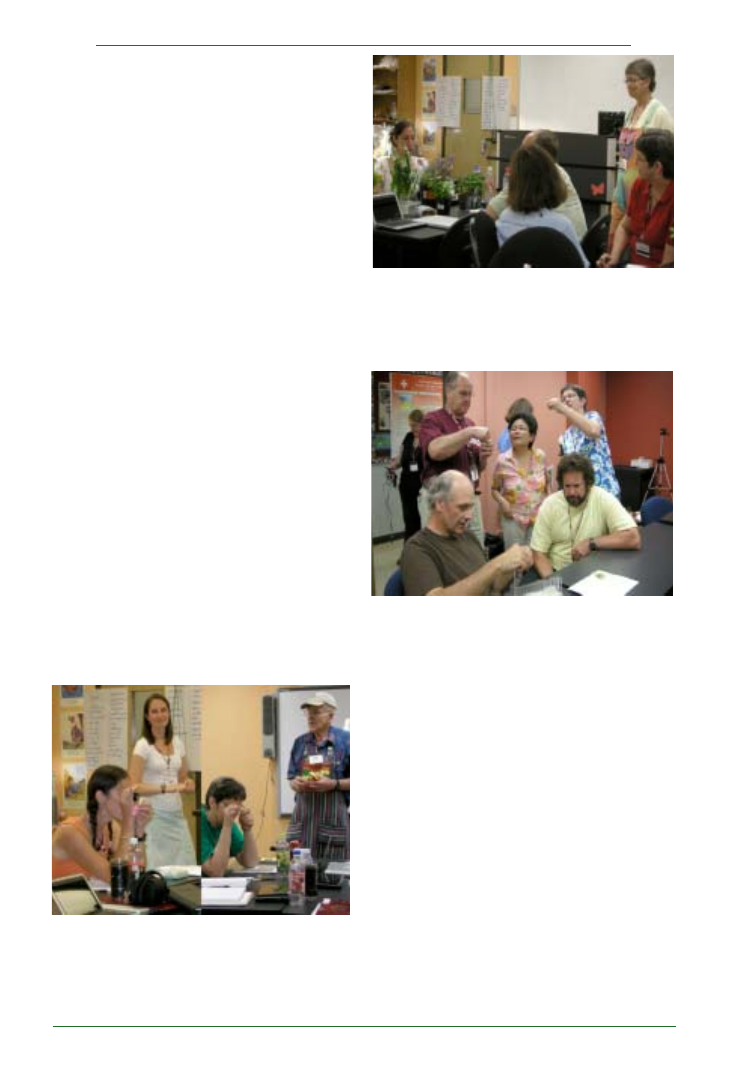
9 8
Plant Science Bulletin 55(3) 2009
Examining results of new assay technique Larry
Griffing, Associate Professor Texas A&M University,
tested during the institute.
Larry Griffing also led a workshop at the 2009
American Society of Plant Biologists meeting in
Hawai’i. Thanks to Larry for introducing 19 teachers
to PlantingScience and continuing to strengthen
the ASPB and PlantingScience collaboration.
Teresa Woods will be coordinating another round
of classroom field-testing for the genetics and
pollination modules this school year. She’s also
working with Renee Lopez Smith and Marshall
Sundberg as they develop new PlantingScience
modules. If you have interests in contributing to
writing new units or shadowing student experiments
and mentoring field-testing classes, please contact
psteam@plantingscience.org
.
Gearing up for PlantingScience School-year
Sessions — Interested in Mentoring Students
Online? Option to Join the 2009-2010 Master Plant
Science Team.
We invite you to join the effort to enhance the
standard school science experience by
Discussing ideas for pollinator movement
experiments led by Beverly Brown, Associate
Professor Nazareth College.
Summer Institute teachers using simple but effective
magnifying tools from Paul’s Sandbox with guidance
from Amber Roberston, graduate student University
of Wisconsin, Madison (left) and Paul Williams,
professor emeritus University of Wisconsin,
Madison and Wisconsin Fast Plants (right panel).
BSA Science Education News and Notes is a
quarterly update about the BSA’s education efforts
and the broader education scene. We invite you to
submit news items or ideas for future features.
Contact: Claire Hemingway, BSA Education
Director, at chemingway@botany.org or Marshall
Sundberg, PSB Editor, at psb@botany.org.
PlantingScience — BSA-led student research
and science mentoring program
Summer Learning Fun for Teachers. The second
PlantingScience Summer Institute was held June
8-16. What a phenomenal group of accomplished
and committed middle school and high school
teachers! And what an engaging and enlightening
learning environment the scientist presenters
offered these 12 teachers who came to Texas A&M
University from across the country.
Paul Williams and Amber Robertson, along with
input from classroom field-testing teacher Kathy
Vanderloop, introduced the new Rapid Cycling
Brassica Genetics Strand. Larry Griffing, along with
teacher leaders Allison Landry and Toni Lafferty,
introduced the Arabidopsis Genetics Strand. Beverly
Brown led pollen and pollinator movement inquiries,
with field-testing teacher Valdine McLean posting
comments to teacher teams online. Following five
days of science inquiry immersion, Claire
Hemingway, Carol Stuessy, Sandy Honda, and
Teresa Woods provided focused sessions to
support implementing in the classroom,
communicating with scientists and peers, and
getting the most of the curricular materials.
BSA Science Education
News and Notes
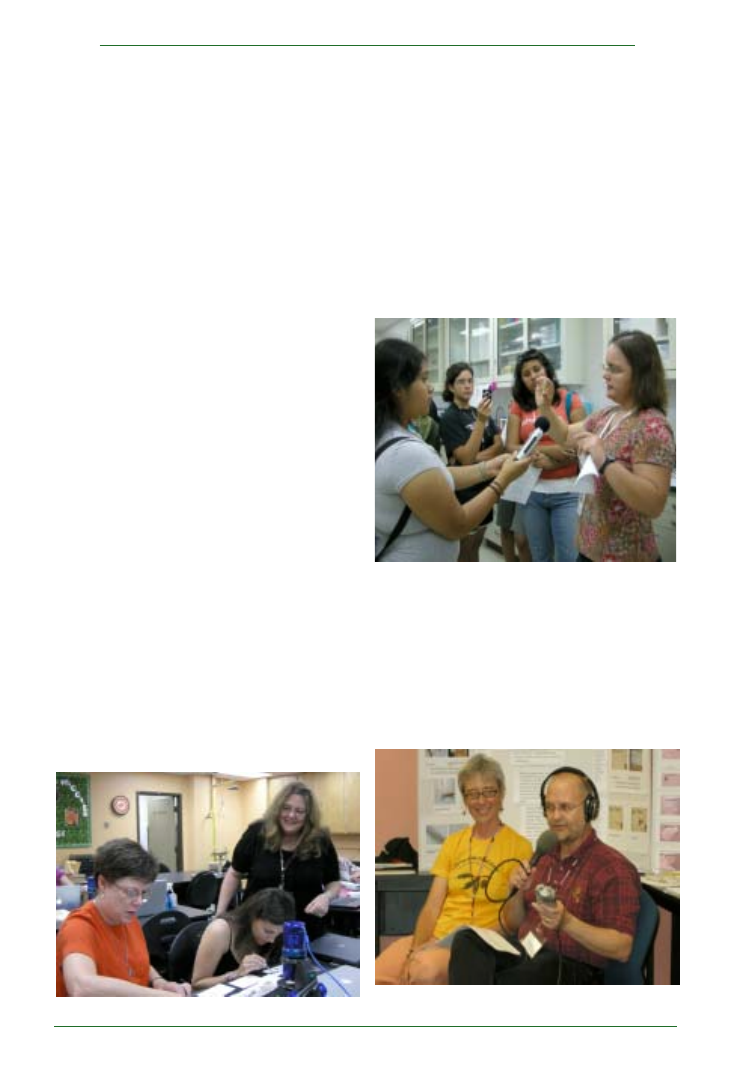
9 9
Plant Science Bulletin 55(3) 2009
communicating online with student teams as they
plant investigations in their classroom.
If you have about an hour a week to volunteer during
the 2-month Fall or Spring Online Session, consider
joining as Scientist Mentor. The Fall 2009 Online
Session will officially run October-November. The
Spring 2010 Session will likely run mid February-
mid April.
Special opportunities are open to graduate students
and post-doctoral researchers who can commit to
mentoring 3-4 teams in both Fall and Spring Online
Sessions.
The BSA will sponsor 20 students/post-docs to
serve on the 2009-2010 Master Plant Science
Team.
For information and an online application form,
please see the Scientist page on
www.plantingscience.org.
Or use the link below.
h t t p : / / w w w . p l a n t i n g s c i e n c e . o r g /
index.php%3Fmodule=pagesetter%26func=
viewpub%26tid=4%26pid=62
Plant IT Careers, Cases, and Collaborations
Second Institute for Teachers and Career Camp for
High School Students
How people use plants was the theme for the
second Plant IT Institute for Teachers and Summer
Career Camp for Students. Co-PI Ethel Stanley and
presenter Toni Lafferty introduced 14 teachers from
across the country to teaching plant biology content
through student investigative cases. Materials and
resources for the Apple Seeds Case, Seedy Sock
Case, and Chia Case developed by Ethel and Toni
are available online. Be sure to also check out the
seven cases created by teacher teams during the
2009 Summer Institute, and investigative case
materials from the 2008 session. You’ll find these
under the teacher tab on the project
website http:/
/myPlantIT.org
Ethel Stanley talking with Sandi and Becky as they
analyze seed evidence in the Seedy Sock forensic
plant science case.
In week two, the session was infused with the live-
wire energy of 25 students primarily from Houston.
They came to campus to explore cases with teachers,
visit lab and research facilities, learn about college
life, and meet scientists, professionals, and science
media experts. Plant professionals from the USDA,
TAMU Departments of Biology, Entomology and
Horticulture, AgriLife, the Horticultural Greenhouse,
Fruit and Vegetable Improvement Center, and local
businesses Producers Cooperative and
GreenTeams Inc. gave the students an idea of the
diverse careers available to individuals interested in
working with and sharing knowledge about plants.
Students interview Dr. Lori Hinze of the USDA Cotton
Germplasm Research Group.
Charles Kazelik (aka Dr. Biology) and Beth Judy
(aka Flora Delaterre) helped student prepare for the
experience of interviewing the professionals they
would meet by modeling an interview and gave the
students tips on telling their own stories.
[Check out Dr. Biology’s interview with Flora
Delaterre on Ask-A-Biologist:

100
Plant Science Bulletin 55(3) 2009
h t t p : / / a s k a b i o l o g i s t . a s u . e d u / p o d c a s t s /
content_logs/vol50_log_aab_podcast.html
Check out Flora Delaterre’s Radio Shows on
Medicinal plants:
http://www.floradelaterre.com/
And don’t miss the 2009 PlantIT Student blogs on
the project website:
http://myplantit.org/blog/
Our thanks to Co-PI Carol Stuessy, Associate
Professor Department of Teaching, Learning, and
Culture at Texas A&M University, and her graduate
students for their incredible work hosting and
collecting education research data for both the
PlantingScience and Plant IT Summer Institutes!
Science Education in the News
Science Video Contest Winners Announced—
Visual learners are in for a treat with the science
videos submitted to recent contests. Educational
videos reach new heights and new audiences. Find
a new teaching tool or watch for the shear pleasure.
ChloroFilms, plant videos on YouTube supported
by the American Society for Plant Biologists,
Botanical Society or America and Canadian
Botanical Society, awarded the winning video to
“Fertile Eyes.”
http://www.chlorofilms.org/
The Scientist Video Awards, sponsored by The
Scientist Magazine and SciVee, cover a wide range
of topics. Plant videos include water pressure
measurement in the xylem of transpiring leaves
and plant biotech for food and environment.
h t t p : / / w w w . t h e - s c i e n t i s t . c o m /
videoawards/
http://www.scivee.tv/node/11148
http://www.scivee.tv/node/10853
Long-Rage Vision for Transformative Change—
The Carnegie Institute for Advanced Study
Commission on Mathematics and Science
Education released a report, The Opportunity
Equation: Transforming Mathematics and Science
Education for Citizenship and the Global Economy,
that calls for an urgent and coherent effort to “do
school differently” in order to deliver excellence
equitably to all students. The report may be
downloaded from:
http://www.opportunityequation.org/
Editor’s Choice.
Botany in Science Education Journals
Robert Marquard and Rebecca Steinbeck 2009. A
Model Plant for a Biology Curriculum. American
Biology Teacher 71: 235-244.
Four teaching modules on reproduction, inheritance,
biochemistry, and germination involving Cleome
are described.
Kaesha Neil 2009. Flowering Phenology: An
Activity to Introducte Human and Environmental
Effects on Plant Reproduction. American Biology
Teacher 71: 300-304.
An activity and discussion to introduce the concept
of flowering phenology to high school students with
extensions to field data collection.
Lara B. Pacifici, Craig Miller, and Norman Thomson.
2009. Student Participation in Ecological Research:
Preliminary Insights from Students’ Experiences in
the Smoky Mountains. JNRLSE vol. 38.
Students’ electronic journals kept during summer
research internships at the Great Smoky Mountain
National Park are analyzed to identify impacts of
research experience for young people.
Zhong Ma, Cynthia Cooper, Hyun-Joo Kim, and
Diane Janick-Buckner. 2009. A Study of Rubisco
through Western Blotting and Tissue Printing
Techniques. CBE Life Sci Educ 2009: 140–146.
Description of laboratory exercise for a cell biology
course introducing techniques for quantitative and
qualitative analysis of Rubisco from various plants.
Baskauf, Steven J. and Bruce K. Kirchoff. 2008.
Digital Plant Images as Specimens: Toward
Standards for Photoghraphing Living Plants. Vulpia
7:16-30.
We all use plant images in our teaching and
research, and now, with the widespread availablity
of digital cameras and digital imaging, it is more
reasonable than ever to visually document all
aspects of plant morphology. Baskauf and Kirchoff
present, and illustrate, a system of standards for
documenting plants. There are separate standards
for woody angiosperms, herbaceous angiosperms,
gymnosperms, ferns and other vascular non-seed
plants, and cacti. High quality images illustrate
each of the standards. The intent is that these will
become the standards for Morphobank
http://
www.morph-bank.net
.

101
Plant Science Bulletin 55(3) 2009
In Memoriam:
Jack Dainty 1919 - 2009
Jack Dainty was a pioneering plant biophysicist
who introduced a thermodynamic approach to the
study of the movement of water and ions across
plant cell membranes. Although he began scientific
life as a nuclear physicist, an early interest in natural
history and an early transformative teaching
experience led him into the field of biophysics. Jack
established strong research groups in plant
biophysics first at the University of Edinburgh, and
subsequently at the University of East Anglia and
then University of Toronto. Through a series of
influential review articles and research papers,
Jack established the importance of understanding
the basic physical processes that underlie the ion
and water relations of plant cells.
Jack was born in an economically depressed coal-
mining town near Sheffield, England. His father had
died when he was three, and he grew up in what he
described as a deprived and poverty-stricken
environment, an experience that made him a life-
long committed socialist. Although none of his
immediate family had continued schooling past the
age of 14, Jack received a scholarship to attend
Mexborough secondary school where he
specialized in mathematics, physics and chemistry
in the last two years. He was taught English by the
mother of A.S. Byatt and Margaret Drabble, but at
that stage his consuming interest in literature was
dormant. Jack was a very keen football player and
at one stage was head-hunted by one of the
professional Yorkshire football teams but
mathematics prevailed! He also maintained a
personal interest in natural history, going on long
walks in the South Yorkshire countryside and reading
British naturalists such as Gilbert White. In 1937,
Jack won a scholarship to Cambridge University
(an almost impossible achievement from such a
background) to study mathematics, but he switched
to physics, and graduated with first class honors in
1940. At the beginning and end of each term, he
would cycle between Mexborough and Cambridge,
a distance of 120 miles with his books secured on
the back of the bike.
Completion of his studies at Cambridge coincided
with the early days of the Second World War, and
Jack was recruited by the military authorities to
remain at Cambridge as part of a team working on
nuclear fission. This research ultimately led to the
construction of an atomic bomb, but it was realized
at the time that only the United States had sufficient
industrial power to actually make such a bomb. One
of Jack’s specific responsibilities was to calculate
whether Germany had enough heavy water to make
an atomic bomb (which it did not). Jack became
head of the cyclotron team and spent the war years
working on basic aspects of nuclear fission; for this
work he received the Stokes Medal from Cambridge
University in 1945. He was an ARP (air raid
protection) warden and when on duty played bridge
with Fred Hoyle and others to pass the time. Also,
because of a shortage of faculty during the war
years, Jack did a great deal of teaching, lecturing on
atomic and nuclear physics and giving tutorials. He
later said that teaching strengthened his
understanding of physics and was of great
importance when he switched to biological
problems. During his time at Cambridge, Jack
continued his interest in natural history, chiefly bird-
watching, and read more deeply in evolutionary
biology, including works by Darwin, Huxley, Mayr
and Dobzhansky.
After the war, Jack spent two years at the Canadian
Atomic Energy Laboratories in Chalk River, Ontario,
where he helped to establish the program in nuclear
physics and worked on methods to measure doses
of radioactivity received by biological tissues. In
1949, he was invited to join the physics faculty in the
Department of Natural Philosophy at the University
of Edinburgh where he built up a research group
around a small accelerator. In the early 1950’s Jack
was asked by the head of the department, who knew
of his interest in biology, to take on the task of
teaching elementary physics to a large class of
medical, dental and veterinary students. Although
he initially balked, he was offered the opportunity to
establish a new Department of Biophysics as an

102
Plant Science Bulletin 55(3) 2009
inducement, and thus, in his own words, he moved
into biology “almost by accident”. Early collaboration
with an animal physiologist on the exchange of
sodium across the membranes of cat nerve cells
pointed Jack in the direction in which he was to
make his most important contributions: the transport
of water and ions across the membranes of plant
cells. A brilliant physics graduate student, Enid
MacRobbie (now Professor Emeritus, University of
Cambridge) joined forces with Jack to work on
membrane transport in plants, using the characean
alga Nitellopsis and radioactive isotopes to measure
influxes and effluxes of Na, K, and Cl. These
pioneering studies demonstrated the presence of
ion pumps in the cell membrane and tonoplast and
established that the fast-diffusion, so-called free
space, fraction of ions was located exclusively in the
cell wall, not in the protoplast as previously thought.
Further collaboration with Alex Hope at the University
of Sydney on water permeability and ion exchange
in the giant cells of the freshwater alga Chara
corallina established that the rate of water exchange
was controlled by the rate of diffusion across the
unstirred layers of water external to the cell
membrane.
These early publications made clear the importance
of a biophysical approach to plant membrane
transport and transformed the field. As a
consequence, Jack was invited to write several
reviews in the early 1960s, including ones for the
Annual Review of Plant Physiology and Advances in
Botanical Research. In these he argued that the
older concepts of “suction pressure” and “diffusion
pressure deficit” be replaced by more rigorous
irreversible thermodynamic approach to
understanding the driving forces of plant water
relations. In 1963, Jack moved to the new University
of East Anglia in Norwich where he attracted a
strong group of academic visitors, graduate students
and post-doctoral fellows working on ion and water
relations, including the ion exchange capacity of cell
walls and the measurement of membrane
potentials. Here, he carried on with his strong
interest in teaching physics to undergraduate biology
students, as well as to graduate students in
biophysics. His lectures to M.Sc students started at
8 am because everyone was so busy that this was
the only time available. Jack somehow made it but
often looking the worse for wear. The students were
prepared and provided coffee and he would cadge
a cigarette and puff away as lucidity prevailed.
In 1969, Jack moved again to the University of
California at Los Angeles, first to the Laboratory of
Nuclear Medicine and Radiation Biology and then
to Department of Botany at UCLA. At that time, Hal
Mooney had recently moved from UCLA to Stanford
and Jack volunteered to look after his grad students
and to teach an undergraduate course in plant
ecology. Jack saw this as an opportunity to integrate
his knowledge of biophysics with a life-long interest
in natural history. Despite the enjoyment of putting
a biophysical slant on everything ecological, he
decided in the end that ecology was biologically too
complex for a physical scientist. Development of
this course, however, influenced the direction of
research taken by Park Nobel at UCLA, who
subsequently made important biophysical
contributions to plant ecology and the course also
provided the foundation for the successful advanced
textbook written by Nobel.
After just two years at UCLA, Jack moved to the
Department of Botany at the University of Toronto to
take up the position of Chair and the opportunity to
return to biophysical plant physiology. A former grad
student from East Anglia, Mel Tyree, joined faculty at
same time and together they formed a fruitful
collaboration, studying water relations of Tsuga
canadensis using the Scholander pressure bomb
and symplastic transport between the giant
internodal cells of Chara corallina using radioactive
tracers as a test of theoretical considerations. In the
mid-1970s, Bill Lucas (now University of California,
Davis) joined the lab to continue electrophysiological
work on the properties of HCO
3
- transport across
the cell membrane of Chara and demonstrated the
dramatic effects of cations on HCO
3
- influx and
membrane integrity. Other students and associates
also worked on the electrophysiology of membrane
transport and on the ion exchange properties of
plant cell walls. During this period, he was also an
Associate Editor of Plant Physiology, a position that
he took very seriously but enjoyed. Jack stepped
down as Chair in 1976 and retired from the University
of Toronto in 1984. In retirement, he continued
collaboration with his successor, Eduardo
Blumwald (now at UC Davis) on the regulation of ion
channels in the cell membranes of halophytes.
Jack continued to be sought after as a consultant
and collaborator in various aspects of membrane
biology and biophysics throughout his life. His most
recent publication dealt with the biomechanics of
aquatic vegetation (Schutten et al., 2005, J. Ecol. 93:
556-571); thus, his publication record spanned
more than 60 years (another joint MS is under review
at present).
As Chair of the Department of Botany at the University
of Toronto, Jack was distinguished by his strong
sense of fair play, open-mindedness, and lack of
pretension. Despite his distinguished academic
career, his behavior was democratic and his attitude
toward the diversity of fields of study found in the
department inclusive. He was uniquely able to
personally connect with individual faculty members,
support staff, and graduate students and was
generous with advice and encouragement.
Throughout his life, Jack was a loyal and steadfast

103
Plant Science Bulletin 55(3) 2009
friend of many, maintaining friendships and
collaborations with many in North America, the U.K
and Europe, and Australia.
Teaching played an important part throughout Jack’s
career and he later stated that one of his most
significant accomplishments was inculcate a
feeling in students for the biophysical aspects of
biology. For example, while at the University of
Toronto, he taught an introductory biology course for
non-Biology students on the “Design of Organisms”
that discussed questions of size and shape and
how these were determined by the physics of
diffusion, the bulk flow of fluids, and biomechanical
constraints. The text book for this course was
“Gulliver’s Travels”, a choice that surprised many of
the students, but one that forced them to think
analytically about biological size. While an untenured
faculty member, I (Nancy) audited an upper division
course on “Plant Biophysics” taught by Jack (and
Mel Tyree) and was entranced by how straightforward
and logical he made the physical processes
underlying membrane transport and the bulk flow of
fluids in the xylem and phloem seem. Even an
elementary understanding allowed an evaluation
of conflicting theories and a check on the
interpretation of experimental evidence.
The significance and impact of Jack’s research
accomplishments were recognized by appointment
as “University Professor”, the highest academic
honor at the University of Toronto. He has been a
recipient of the Gold Medal of the Canadian Society
of Plant Physiologists and was elected a
Corresponding Member of the Botanical Society of
America and of the American Society of Plant
Physiologists. Jack was also a Fellow of the Royal
Society of Canada, the American Society for the
Advancement of Science, and the Royal Society of
Edinburgh. He was elected as a Foreign Associate
of the Academy of Sciences of the Institute of France
and also he was appointed an Academician of the
National Academy of Lincei, Rome. Sadly, election
to the Royal Society of London eluded him, a reflection
of the somewhat myopic views of the day. In 1994,
he was invited to write a biographical chapter for the
Annual Review of Plant Physiology and Plant
Molecular Biology (Vol 41: 1-40).
In retirement, he lived in France and Norwich in East
Anglia, U.K. Much of the time was spent avidly
reading European and North American literature or
watching football. He had an excellent command of
languages; a month before he died he had just
finished reading a novel in French. He celebrated
his 90
th
birthday a few weeks before he died with
family, friends and colleagues, but had been in
failing health for over a year. Jack is survived by Mary
Elbeck and their sons Anton, Chris and Patrick and
by Trish Shea and their sons Jack and Matthew.
At the University of Toronto he is remembered by the
Jack Dainty Graduate Scholarship in Ecology and
Evolutionary Biology, which was set up two months
before he died. It gave him considerable pleasure
that a Scholarship was to bear his name. So far
about half of the funds needed have been donated.
(Donations may be sent to the University of Toronto
at Office of Advancement, Faculty of Arts & Science,
100 St. George Street, RM 2033, Toronto, ON, M5S
3G3, Canada. Cheques should be made payable
to ‘University of Toronto’ and identified as ‘Jack
Dainty Fund’)
Nancy G. Dengler
Robert L. Jefferies
Department of Ecology & Evolutionary Biology
University of Toronto
Corresponding member, Jack Dainty passed away
in Norwich in June, 2009 at 90. He contributed to
Plant Science in Britain, Scotland, USA, Canada,
Australia and many European nations by applying
physical theory to water and mineral transport in
plants, and by founding departments of plant
biophysics in Edinburgh, Scotland and East Anglia,
England. From 1969 through 1980’s he was in
North America first at UCLA (1969-1971), then as
Chair of The Botany Department at University of
Toronto (1971-1984). He produced hundreds
important papers and a series of books and
chapters on plant biophysics and membrane
transport, as well as providing editorial advice for J.
Plant Physiology, AJB, and many other journals.
Two British tributes are found in The Guardian and
The Times (
http://www.timesonline/tol/comment/
obituaries/article657821.ece
and
http://www.guardian.co.uk/science/2009/jun/24/
obituary-jack-dainty
).
Jack Dainty’s Major Contributions to Plant Science
Jack Dainty transformed the field of transport of
water and solutes in plant cells and tissues,
introducing strict physical principles and analysis.
His legacy is three-fold, in his own scientific
publications. in the strong influence he had on
others, not only through personal contact and
collaborations but also remotely through the
literature, and in the scientific dynasties he founded
when research students trained by him went out to
found their own groups.
After his transfer from nuclear physics to set up
Biophysics in Edinburgh in 1953 he worked first on
the ionic relations of algal cells, including a giant
Characean alga, an experimental system which
had been used extensively by Osterhout and Blinks

104
Plant Science Bulletin 55(3) 2009
in the 1930s at Harvard, Rockefeller and Stanford.
Dainty then moved on to investigate the water
permeability of plant cells, work which revealed the
importance of unstirred layers in membrane
transport. His studies of the ion exchange properties
of cell walls demonstrated the role of fixed charges
on cell wall polymers in determining ion access to
the membrane. He went on to use the principles
of irreversible thermodynamics to analyze
movement of water and solutes across plant cell
membranes, using a frictional model to characterize
solute-water interactions. He provided insight into
the mechanism of osmosis.
A portion of his legacy are the establishment of
active research groups in three Universities,
Edinburgh, East Anglia, and Toronto, and in each
case he and his students and collaborators pursued
rigorous biophysical research on an extremely wide
range of problems in plant transport, on single
cells, tissues and whole plants. They maintained a
dominant position in the field for several decades.
In Edinburgh and East Anglia he established
graduate courses in Biophysics, which brought
graduates in the physical sciences into biology. He
taught them to think as biologists,and inspired
them to remain in biological research. Together
with his efforts to get biologists in general to think
quantitatively, this may turn out to be one of the most
important contributions of a remarkable career.
Dainty’s Work in Australia
Dainty had made close contacts with botanists in
Australia working on membranes in his early
transition days from physics into botany in the
1950’s. Dainty said “This experience of working in
Australia with Alex Hope and Alan Walker was of the
greatest benefit to me, not only owing to the ideas
we had and the experiments we did. It was the first
time I had worked in a biological milieu, and I believe
I derived much from my close contacts with Bob
Robertson, Joe Wiskich, and others who were
more biochemically inclined than I and were trained
as biologists, not physicists. Similar ideas were
being followed in Australia, particularly by Alex Hope.
Alex had been a member of a remarkable group in
the Physics Department of the University of
Tasmania at Hobart. This group was the brainchild
of Lester MacAulay, the head of the department, who
had an interest in how plants function and
encouraged some graduate students to share it.
Bruce Scott, Alex Hope, Alan Walker, Geoff Findlay,
and Ian Newman are all from this school and have
helped to make plant biophysical physiology
eminent in Australia. In 1958 Alex was in the
C.S.I.R.O. Plant Physiology Unit at the University of
Sydney, This turned out to be an extremely fruitful
collaboration. We came up with what I believe to be
one or two important concepts from the experiments
we carried out on the water permeability of Chara
australis (now corallina) and on the ion exchange
properties of the Chara cell wall.”
Dainty’s Work in the USA
Jack Dainty ,as a corresponding member of the
Botanical Society of America, helped with
Physiological and Molecular journal editing and
Symposia for 25 years. He was also a member of
the American Society of Plant Physiologists (Plant
Biologists) and on the editorial board of Plant
Physiology. He worked in the United States twice,
once during the Los Alamos Atom Bomb days
wherein his English team of nuclear physicists
came to the US as well as Chalk River ,Canada. His
second period was at UCLA (first to the Laboratory
of Nuclear Medicine and Radiation Biology and then
to the Department of Botany) for several years from
1969-1971 (where one of us (AT) visited him
frequently). Dainty said of this period , “ My short time
at UCLA was certainly pleasant, thanks to George
Laties, Park Nobel, Jacob Biale, and others.” His
peripatetic wanderings at scientific meetings kept
him in contact with a series of plant scientists in the
USA from his USA post-docs John Gutknecht and
Anitra Thorhaug to many membrane workers
throughout the USA, including British, Canadian
and Austrialian workers who had come to the USA.
He very much appreciated Botanical Society of
America conferring a Corresponding membership
title on him, writing to one of us (AT) in his last years
about how he enjoyed the journal immensely and
the honor bestowed on him at Norman, Oklahoma
in 1979 where he received this honor. Dainty was
also an Associate Editor of the Journal Plant
Physiology for two periods of three years, handling
biophysical papers—under the late Martin Gibbs.
Anitra Thorhaug , Yale University, School of
Forestry and Environmental Studies, New Haven
CT, USA
Enid MacRobbie, Cambridge University,
Cambridge , England

105
Plant Science Bulletin 55(3) 2009
Personalia
Alan Graham Receives American
Society of Plant Taxonomists’ 2009
Asa Gray Award.
The Asa Gray Award is given by the ASPT to an
individual for outstanding accomplishments
pertinent to the goals of the Society. This year’s Asa
Gray Award recipient is Dr. Alan Graham, Curator of
Paleobotany & Palynology at the Missouri Botanical
Garden and Professor Emeritus at Kent State
University, where he received university awards for
excellence in teaching and research and served as
major advisor for 16 graduate students. Alan’s
extensive and diverse efforts on late Cretaceous
and Cenozoic vegetation and flora of the New World
have resulted in 118 scientific articles, two sole-
authored books (Late Cretaceous and Cenozoic
History of North American Vegetation, in 1999, and
Late Cretaceous and Cenozoic History of Latin
American Vegetation, in 2009), two co-edited and
co-authored books (Floristics and Paleofloristics of
Eastern Asia and Eastern North America, in 1972,
and Vegetation and Vegetational History of Northern
Latin America, in 1973), and 120 contributed and
invited talks. Alan’s contributions to teaching include
a five-week course in Mexico that was taken by over
350 students over 14 years. He has served on the
editorial board of Systematic Botany, in addition to
other journals, and donated a 25,000 palynological
slide reference collection and associated literature
collection of nearly 17,000 reprints to the
Smithsonian Tropical Research Institute. For these
and other contributions, the ASPT is pleased to
recognize Alan with this year’s Asa Gray award.
Botanical Preserve Established in
Honor of Centenarian,
Rogers McVaugh
On Saturday June 6, Rogers McVaugh and his son
Michael McVaugh, Professor Emeritus at University
of North Carolina-Chapel Hill, held a 100
th
birthday
party at the Hill Alumni Center on the UNC campus
for Rogers, who reached his centenary on May 30,
2009. Over 60 friends and family attended this
celebration, including many botanical colleagues
from UNC, Duke University and North Carolina
State University, and some colleagues from Mexico
with whom he has worked. One of these colleagues,
Dr. Javier Curiel, a physician with botanical interests,
announced the establishment of a botanical
preserve in Jalisco province in his honor, namely
the Jardin Botanico Rogers McVaugh. It will be used
to promote and educate about the unique mix of
tropical and temperate vegetation in that area and
environmental conservation. Dr. Curiel summarized
some of the more interesting plants that occur in the
forest preserve, and noted also that several
interesting large mammals inhabit the area,
including at least three types of large cats (puma
etc).
Award Opportunities
American Philosophical Society,
Research Programs
All information and forms for all of the Society’s
programs can be downloaded from our website,
http://www.amphilsoc.org/
Click on the “Fellowships
and Research Grants” tab at the top of the homepage.
INFORMATION ABOUT ALL PROGRAMS
Purpose, scope
Awards are made for non-commercial research
only. The Society makes no grants for academic
study or classroom presentation, for travel to
conferences, for non-scholarly projects, for
assistance with translation, or for the preparation of
materials for use by students. The Society does not
pay overhead or indirect costs to any institution
or costs of publication.
Eligibility
Applicants may be residents of the United States or
American citizens resident abroad. Foreign
nationals whose research can only be carried out
in the United States are eligible. Grants are made
to individuals; institutions are not eligible to apply.
Requirements for each program vary.
Tax information
Grants and fellowships are taxable income, but the
A high school student proudly displays the fruits of his
labor in a school garden - - see “Reversing Teenagers
Disconnect from Nature” - p. 113.

106
Plant Science Bulletin 55(3) 2009
Society is not required to report payments. It is
recommended that grant and fellowship recipients
discuss their reporting obligations with their tax
advisors.
Contact information
Questions concerning the FRANKLIN and LEWIS
AND CLARK programs should be directed to Linda
Musumeci, Research Administrator, at
LMusumeci@amphilsoc.org
or 215-440-3429.
INDIVIDUAL PROGRAMS
Franklin Research Grants
Scope
This program of small grants to scholars is intended
to support the cost of research leading to publication
in all areas of knowledge. The Franklin program is
particularly designed to help meet the cost of travel
to libraries and archives for research purposes; the
purchase of microfilm, photocopies or equivalent
research materials; the costs associated with
fieldwork; or laboratory research expenses.
Eligibility
Applicants are expected to have a doctorate or to
have published work of doctoral character and
quality. Ph.D. candidates are not eligible to apply,
but the Society is especially interested in supporting
the work of young scholars who have recently
received the doctorate.
Award
From $1,000 to $6,000.
Deadlines
October 1, December 1; notification in February and
April.
Lewis and Clark Fund for Exploration and Field
Research
Scope
The Lewis and Clark Fund encourages exploratory
field studies for the collection of specimens and
data and to provide the imaginative stimulus that
accompanies direct observation. Applications are
invited from disciplines with a large dependence on
field studies, such as archeology, anthropology,
biology, ecology, geography, geology, linguistics,
and paleontology, but grants will not be restricted to
these fields.
Eligibility
Grants will be available to doctoral students who
wish to participate in field studies for their
dissertations or for other purposes. Master’s
candidates, undergraduates, and postdoctoral
fellows are not eligible.
Award
Grants will depend on travel costs but will ordinarily
be in the range of several hundred dollars to about
$5,000.
Deadline
February 15; notification in May.
The David Starr Jordan Prize
For Innovative Contributions to the Study
of
Evolution, Ecology, Population and
Organismal Biology
In 1986, Cornell, Indiana and Stanford Universities
established a joint endowment to fund a prize in
honor of David Starr Jordan, a scientist, educator
and institution builder of enormous influence on
higher education in the United States who had
important ties to each of these universities. The
prize is international in scope and presented
approximately every three years to a young scientist
(40 years of age or less) who is making novel
innovative contributions in one or more areas of
Jordan’s interest: evolution, ecology, population
and organismal biology.
The intent of this prize is to recognize young scientists
who are making research contributions likely to
redirect the principal foci of their fields. In addition
to a cash award, the recipient will receive a
commemorative medal, will attend an awards
ceremony, visit each of the sponsoring institutions
and give scholarly presentations of his/her work.
The selection of the prize winner will be made by a
committee composed of representatives from each
of the three institutions.
The sixth David Starr Jordan Prize will carry a prize
of $20,000.00 and will be announced in Fall of 2009.
This year the award ceremony will be held at Cornell
University.
Nomination forms are posted on the David Starr
Jordan Prize Website (www.davidstarrjordan.org).
Nomination forms with supporting materials should
be submitted by email. Questions should be directed
to:
Dr. William L. Crepet, Chair
Plant Biology Department
412 Mann Library Building
Cornell University
Ithaca, New York 14853
(607-255-2131 - FAX 607-255-5407)
email
WLC1@cornell.edu
All nomination materials must be received prior to
August 15, 2009. For more information including a
list of previous prize winners and their
accomplishments, visit:
www.davidstarrjordan.org

107
Plant Science Bulletin 55(3) 2009
The Rupert Barnaby Award Of The
New York Botanical Garden
The Rupert Barneby Award, named in honor of the
late NYBG scientist and renowned legume expert,
consists of US$ 1000.00 granted annually to assist
researchers to visit The New York Botanical Garden
to study the rich herbarium collection of
Leguminosae. Comprising over 320,000
specimens, including ca. 8450 types, the collection
is widely considered to be one of the best curated
and most comprehensive of its kind, particularly
with regard to New World legumes. Graduate
students and early career professionals with
research in systematics and/or legume diversity
are given special consideration. Anyone interested
in applying for the award should submit their
curriculum vitae, a two-page proposal describing
the project for which the award is sought, and the
names of 2-3 references. The application should
be addressed to Dr. Benjamin M. Torke, Institute of
Systematic Botany, The New York Botanical Garden,
200th Street and Kazimiroff Blvd., Bronx, NY 10458-
5126, USA, and received no later than December 1,
2009. Submission by e-mail is preferred (send to:
btorke@nybg.org
). Announcement of the recipient
will be made by December 15, 2009. Travel to NYBG
should be planned for a period, preferably of at least
two weeks, in 2010. Recipients are asked to give a
presentation about their research at NYBG.
Positions Available
American Institute of Biological Sciences
(AIBS) Legislative Action Center
Available to all members of The Botanical Society of
America, the new American Institute of Biological Sciences
(AIBS) Legislative Action Center (www.capwiz.com/
aibs) is a free online tool that alerts you when important
science legislation is coming up and then allows you to
quickly and effectively communicate with members of
Congress, the President, and local elected officials, as
well as send letters to national and local news outlets.
If scientists are to play a role in shaping science policy,
securing funding for research, promoting science
education, or helping the public understand scientific
issues, it is important to become an active citizen, so you
are encouraged to join the Action Network with the AIBS
Legislative Action Center (www.capwiz.com/aibs) today!
Postdoctoral Fellowship in
Pollination Biology
A postdoctoral position is expected to be available
to conduct research to identify, characterize, map
traits that contribute to out-crossed insect-mediated
pollination in soybean.
The funds will come through the USDA ARS;
candidates must be U.S. citizens. Candidates with
a Ph.D. and demonstrated ability to conduct QTL
molecular mapping and the ability to conduct
transmission and scanning electron microscopy
are encouraged to apply. The microscopy will be
done in the Bessey Microscopy and NanoImaging
Facility at Iowa State University in collaboration with
Dr. H.T. Horner. The position is expected to be
available mid-spring 2010 and funding will be for 2
½ years, subject to satisfactory performance. The
salary will be at the GS-11 level, plus benefits.
Please check with Dr. R.G. Palmer to confirm that
the grant was awarded before sending documents,
which include curriculum vitae, reprints of published
papers, and the names, addresses, telephone
numbers, and emails of three referees to:
Dr. Reid G. Palmer
SDA ARS
G301 Agronomy
Iowa State University
Ames, Iowa 50011
Email:
reid.palmer@ars.usda.gov
Bullard Fellowships in Forest
Reearch
Harvard University
Each year Harvard University awards a limited
number of Bullard Fellowships to individuals in
biological, social, physical and political sciences to
promote advanced study, research or integration of
subjects pertaining to forested ecosystems. The
fellowships, which include stipends up to $40,000,
are intended to provide individuals in mid-career
with an opportunity to utilize the resources and to
interact with personnel in any department within
Harvard University in order to develop their own
scientific and professional growth. In recent years
Bullard Fellows have been associated with the
Harvard Forest, Department of Organismic and
Evolutionary Biology and the J.F. Kennedy School of
Government and hve worked in areas of ecology,
forest management, policy an conservation.
Fellowships are available for periods ranging from
six months to one year after September 1
st
.
Applications from international scientists, women
and minorities are encouraged. Fellowships are
not intended for graduate students or recent post-
doctoral candidates. Information and application
instructions are available on the Harvard Forest
web site;
http://harvardforest.fas.harvard.edu
.
Annual deadline for applications is February 1
st
.

108
Plant Science Bulletin 55(3) 2009
2
nd
Northeastern Weed Science
Society (NEWSS) Noxious &
Invasive Vegetation Management
Short Course (NIVM)
September 21-25th, 2009 near Harrisburg,
Pennsylvania.
This course has evolved to meet the demand and
need for training and instruction of professionals
involved in the administration and/or application of
management strategies for invasive plants here in
the Northeastern United States. The short course is
designed for public and private land managers
(parks, conservancies, preserves, forests, private
parcels and farms) from Maine to North Carolina
who desire a better understanding of non-cropland
weed management. A huge success in 2008, the
course has expanded to include even more topics.
This year, pre-registrants can select from a choice
of topics they most want to see included in the week
long event. Other topics will cover principles of
vegetation management, early detection and rapid
response training as well as in-depth instruction on
herbicide properties, biological, mechanical and
chemical tools of weed control and hands on weed
identification each day. Classroom, laboratory and
field exercises will be utilized and the program is
designed to encourage interaction between
students and instructors. This year’s course will
also offer different session workshops for novice
and advance applicators.
Weed management professionals affiliated with
the society instruct and staff the course. This event
is a not-for-profit activity of the Northeastern Weed
Courses/Workshops
Postdoctoral Opportunity in
Ecological Genomics: Genomics
of Drought Stress in Prairie
Grasses
Kansas State University Postdoctoral
Opportunity AVAILABLE. We have a position
available for a post-doctoral research associate to
study the ecological genomics of drought stress.
The project will include studies of the responses of
natural prairie ecosystems to variation in
precipitation using the ecologically dominant prairie
grass big bluestem as a model. The work is part of
a project funded by the USDA Plant Biology Abiotic
Stress program. The project will include common
garden transplant experiments and genomic
approaches to test for the signature of adaptive
genetic differentiation among natural populations
of big bluestem across the precipitation gradient of
the Great Plains.
This specific research assembles investigators
with complementary expertise in Plant Ecological
Genomics (Johnson
www.ksu.edu/johnsonlab
,
Garrett
www.ksu.edu/pdecology
), Genomics
(Ahkunov
eakhunov@ksu.edu
), Evolutionary
Genetics (Morgan
http://www.ksu.edu/morganlab
)
and Restoration Ecology (Baer, SIU
www.plantbiology.siu.edu/Faculty/Baer/index.html
)
to elucidate the response and adaptation of prairie
grasses to abiotic stresses. This work will take
place in the laboratories of Drs. Johnson, Akhunov,
and Garrett and in field sites across the Great
Plains, with close collaboration with Drs. Morgan
and Baer. There will also be opportunities to interact
with other researchers in the context of the KSU
Ecological Genomics Institute
(
www.ecogen.ksu.edu
).
For this postdoctoral position, we seek candidates
with a Ph.D. in the biological sciences with interest
in evolutionary and ecological genetics. Preference
will be given to individuals with experience in
functional genomic approaches, including next-
gen sequencing, custom microarray development
based on 454 screens, using custom arrays to
screen patterns of gene expression among
ecotypes in response to drought stress and VIGS
techniques. Importantly, applicants should have
the interest and willingness to cross disciplines.
The successful candidates must be able to design
and conduct independent experiments. Excellent
oral and written communication skills and the ability
to work well in a team-based/collaborative research
atmosphere are essential.
Applications will begin to be reviewed on Aug 15,
and will continue until the position is filled. Start date
for the post-doctoral position is Sept 6, 2009. A
complete application must consist of:
1) A cover letter detailing your qualifications and
how they relate to the advertised position.
2) A professional resume
3) Reprints/preprints of publications
4) Names and contact information for three referees
Send a complete application package by e-mail to:
dmerrill@ksu.edu
Complete applications can also be mailed to:
Doris Merrill, Program Coordinator
Ecological Genomics Institute
Division of Biology, Kansas State University
104 Ackert Hall, Manhattan, KS 66506-4901
Phone: (785) 532-3482
Fax: (785) 532-6653
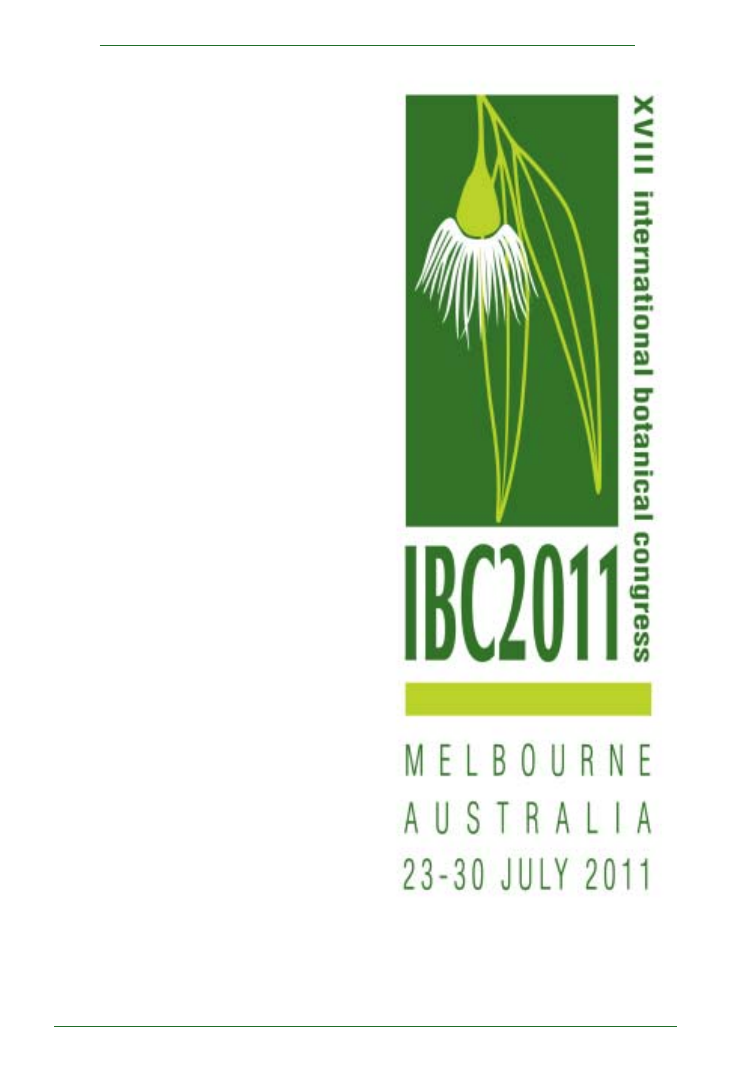
109
Plant Science Bulletin 55(3) 2009
Science Society and is sponsored in part by a grant
from the U.S. Forest Service. To cover anticipated
expenses and course training materials the course
tuition will be $400.00 for a 4.0 day terrestrial course
and $150.00 for a 1.0 day aquatic course or a
discounted $500.00 for those individuals interested
in staying for the entire event. Students will need to
cover travel, lodging and some meal expenses. The
course is limited to the first 75 pre-registered
applicants for the terrestrial portion of the course
and the first 75 pre-registered applicants for the one
day aquatic. Pre-registration is required to attend
this course and should be submitted before June.
The announcement flyer and pre-registration
documents are now posted on the NEWSS Website.
We appreciate your assistance in disseminating
this important and exciting information to potential
registrants.
Melissa A. Bravo, Coordinator for NEWSS NIVM
Short Course
Botanist/Weed Scientist
Bureau of Plant Industry Pennsylvania Department
of Agriculture
2301 North Cameron Street, Harrisburg, PA 17110
mbravo@state.pa.us
717-787-7204
Symposia, Conferences,
Meetings
XVIII International Botanical
Congress
The Australian botanical community invites you to
Melbourne, Australia inJuly 2011 to participate in
the XVIII International Botanical Congress.
Australiahas a vibrant scientific community active
across all botanical disciplines and its researchers
play a prominent and highly collaborative role in
international biological sciences.
The Australian flora, with its many endemics and
strong Gondwanan element, provides a unique
opportunity full of inspiring experiences for the
botanical visitor. Its ancient landscape includes
vast deserts, tropical and temperate rainforests,
floristically rich heathlands and unique eucalypt
forests. Marine environments include a rich flora
and the most extensive coral ecosystem, the Great
Barrier Reef.
Australia’s botanical community is eager to
welcome our colleagues from around the world to
the 2011 IBC for an intellectually stimulating and
socially memorable occasion.
Judy West, Congress President
For more information see: http://www.ibc2011.com/
Default.htm
(note: call for Symposia is now open)
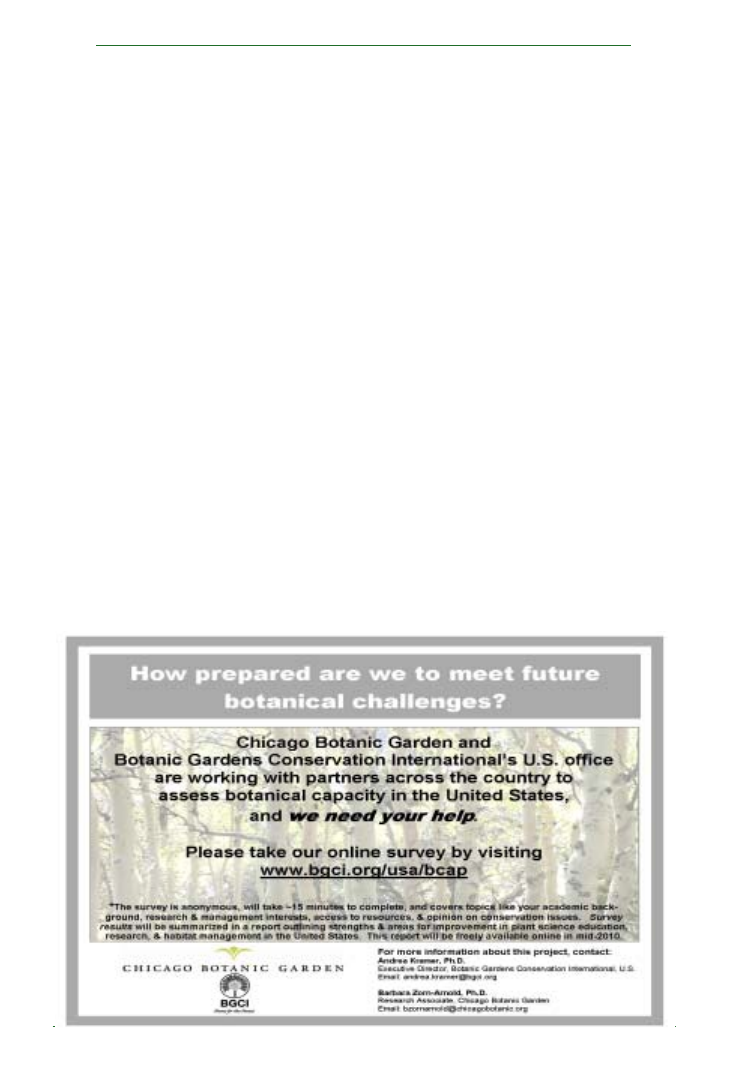
110
Plant Science Bulletin 55(3) 2009
Fourth International Conference on
Plants & Environmental Pollution
7-10 February, 2010
Lucknow, India
It is to inform you that the first circular - Call for
registration and Abstracts - for the Fourth
International Conferenace on Plants and
Environmental Pollution (ICPEP-4) has been issued
and it can be viewed/dowloaded from the links
given below;
1. View Conference information:
http://
isebindia.com/icpep-4/icpep-4.html
2. Download the first circular - Call for registration
and Abstracts:
http://isebindia.com/icpep-4/icpep-
4_1st_circular.pdf (430 kb)
3. Download the Registration Form only:
http://
isebindia.com/icpep-4/icpep-4_reg_form.pdf
For additional information contact:
(Dr. K J Ahmad & Dr. R D Tripathi)
Organizing Secretaries, ICPEP-4
International Society of Environmental Botanists
National Botanical Research Institute
Lucknow-226001, India
E-mail:
isebnbrilko@sify.com
or
isebmail@gmail.com
Webpage:
http://isebindia.com
“
The Identification of Grasses,” by H. D. Harrington
A grass can be “glumey” in more ways than one
When its classification remains to be done;
You pull off the parts, and soon feel your age
Chasing them over the microscope stage!
You peer through the lenses at all of the bracts
And hope your decisions agree with the facts;
While your oculist chortles with avid delight
As you strain both your eyes in the dim table light.
You are left on the horns of quite a dilemma
When you count the nerves on the back of the lemma;
Then you really get snoopy and turn each one turtle
To see if the flower is sterile or fertile.
And then the compression, no problem is meaner—
Is it flat like a wallet or round like a weiner?
“How simple,” you think, “for a mind that is keen”—
But what do you do when it’s half-way between?
You probe and you guess how the florets will shatter,
For you know later on it is certain to matter;
You long for the calmness of labor that’s manual
When the question arises— “perennial or annual?”
And that terrible texture, the meanest of all,
Is one of the pitfalls in which you can fall;
“Catrilaginous” maybe—or is it “chartaceous?”
Has even the experts exclaiming “good gracious!”
Then you wail as you wade through the long tribal key
“Oh why must this awful thing happen to me?”
“Grasses are easy,” our teacher declares,
As he mops off a brow that is crowned with grey hairs!
—
Compliments of Karl Niklas
Complete the following online survey by 8 September!

111
Plant Science Bulletin 55(3) 2009
The 2006 meeting of the International Association for Plant Tissue Culture and Biotechnology, held in
Beijing, China saw a change in the name of our association to the International Association for Plant
Biotechnology (IAPB). Since that 2006 meeting, the Executive Committee of the IAPB has worked to create
a better flow of information to and between attendees and to plan for the next congress. I am pleased to
share some information with you and invite you and your colleagues to attend the upcoming congress.
In 2010, the IAPB will meet in St. Louis, MO—near the heart of the U.S. agriculture industry. It was in St.
Louis that many of the early discoveries of plant biotechnology were made. It is also a region that contains
outstanding research institutions, private companies, and growers groups that develop and/or employ
the products of agriculture. We, the current leadership of the IAPB and the committee members planning
the meeting, hope you will join us in St. Louis in the summer of 2010 for an exciting meeting of plant science
and biotechnology. Learn the latest advances in plant biotechnology with informative sessions on
fundamental and applied aspects of plant sciences presented by leading international scientists. Topics
to be addressed through plenary addresses, keynote lectures, and poster presentations include:
* climate change and its effects on agriculture
* advances in plant science: tolerance to heat, droughts, insects, and diseases
* advances in biofuels and other biorenewables from plants
* metabolic engineering of plants/cells for pharmaceuticals and nutriceuticals
* agriculture and biotechnology in developing countries
* biosafety, regulatory structures and commercialization
* advances in tissue culture and transformation
* germplasm preservation
REGISTRATION OPENS SOON
Member of IAPB and/or SIVB:
Early Registration: (August 15-Feb 1, 2010) - $575
Regular Registration: (Feb 2-Apr 30) - $625
Late Registration: (May 1-Jun 1) - $725
Onsite Registration: (anytime after Jun 1) - $800
Non-member:
Early Registration: (August 15-Feb 1, 2010) - $650
Regular Registration: (Feb 2-Apr 30) - $725
Late Registration: (May 1-Jun 1) - $825
Onsite Registration: (anytime after Jun 1) - $900
Student Early Registration (August 15-Feb 1, 2010) - $400
Student Late Registration (May 1-onsite) - $500
Single Day Registration: $250
One Day Fees:
Any One Day: (Fee includes coffee, lunch and registration materials) - $250 US
Membership Fees:
If you elect to join or renew your membership in either IAPB or SIVB during the registration process, please select
the “Member” rate when you register.
Join or Renew your IAPB Membership: Non US Rate - $25 US; US Rate - $45 US
J
oin or Renew your SIVB membership: Non US Rate and US Rate - $160 US

112
Plant Science Bulletin 55(3) 2009
AMERICAN GENETIC ASSOCIATION
VI CONGRESO SOUTHERN CONNECTION
BECA EN GENÉTICA ECOLÓGICA DE
PLANTAS
15 – 19 Febrero 2010
Bariloche, Argentina
La American Genetic Association (AGA) financiará las
actividades relacionadas con el Simposio “Plant ecological
genetic insights in the southern hemisphere” que tundra
lugar durante el VI Congreso de Southern Connection que
se llevará a cabo entre el 15 y 19 de febrero de 2010 en
Bariloche, Argentina.
AGA ofrece 20 becas parciales para asistir al VI
Congreso
de Southern Connection. Las becas están
dirigidas exclusivamente a estudiantes latinoamericanos.
Podrán postular aquellos que se encuentren realizando
estudios de maestría o doctorado y estudiantes
postdoctorales cuya finalización de tesis de doctorado no
supere los tres años. Las becas cubrirán costos de
inscripción y alojamiento con media pensión. Los gastos
de traslados y otros gastos generales serán
responsabilidad de cada postulante.
Requisitos generales
• Ser estudiante de postgrado o profesional joven.
• Ser originario y residente de Latinoamérica.
• El tema de estudio debe relacionarse con alguna/s de la/
s siguiente/s área/stemática/s: genética ecológica, genética
de poblaciones, genética de la conservación, filogeografía
y/o filogenia.
• Cada participante seleccionado deberá presentar en el
Congreso en modalidad oral o poster el trabajo contenido
en el resumen enviado para postular a la beca.
Procedimiento para postular
Para postular a las becas, enviar por correo electrónico
el resumen del trabajo a presentar en el Congreso, que
deberá contener hasta 1500 caracteres, incluyendo
objetivos, métodos, resultados y conclusiones a:
southernconnection2010@gmail.com
Indicar en el
ASUNTO: BECA AGA y en el cuerpo del correo incluir los
siguientes datos personales: Nombre y apellidos completos,
grado que estudia, año de ingreso, Institución donde
estudia, nombre de la Tesis, nombre del Tutor y fecha
esperada de término de la Tesis. Por favor indique su
preferencia de formato (oral o poster), teniendo en cuenta
que las presentaciones orales están sujetas a
disponibilidad de espacio. El resumen se deberá adjuntar
en formato Word y el nombre del archivo deberá ser el
nombre y apellido del postulante (Por ejemplo
jose_perez.doc).
NO SE ACEPTARÁN POSTULACIONES ENVIADAS POR
FAX O POR CORREO POSTAL
Fecha límite de postulación Lunes 10 de agosto 2009
Los resultados se darán a conocer por correo electrónico
a cada postulante seleccionado el día 21 de agosto de
2009. La nómina de postulantes seleccionados será
publicada desde el 21 de agosto en la página web del
Congreso
http://www.sccongress2010.com.ar
. Las decisiones son
finales e inapelables
AMERICAN GENETIC ASSOCIATION
VI CONGRES SOUTHERN CONNECTION
Scholarships for the Symposium on
Ecological Plant Genetics
1
5 – 19 February, 2010
Bariloche, Argentina
The American Genetic Association (AGA) will finance
activities related to the Symposium Plant Ecological Genetic
Insights in the Southern Hemisphere that will take place
during the sixth Congress of Southern Connection that will
take place between 15 and 19 February 2010 in Bariloche,
Argentina.
AGA offers 20 partial scholarships to attend the Sixth
Congress of Southern Connection. The scholarships are
directed exclusively to Latin American students studying
for the master’s or doctorate or postdoctoral students who
completed their doctoral theses no more than three years
ago. The scholarships will cover costs of registration and
accommodation with half board. The costs of transportation
and other expenses will be the responsibility of every
applicant.
General Requirements
• Be a graduate student or young professional.
• Originate and be a resident of Latin America.
• The study must be linked to any of the folowing areas or
themes: green genetics, population genetics, genetics of
conservation, phylogeography and/or phylogeny.
• Each participant selected must be submitted to Congress
an oral or poster presentation summarized in the abstract
sent to apply for the scholarship.
Procedure to apply for the grants, e-mail the abstract of the
work to submit to the Congress, and which must contain
up to 1500 characters, including objectives, methods,
results and conclusions to:
southernconnection2010@gmail.com
.
Indicate in the header: SCHOLARSHIP AGA and in the email
body include the following personal data: full name, degree
studying, the year in income, Institution where he studied,
the name of the Thesis, name of the Guardian and
expected date of completion of the thesis. Please indicate
their preference of format (oral or poster), taking into
account that the oral presentations are subject to availability
of space. The summary must attach in word and the file
name must be the first and last name of the postulant (for
example jose_perez.doc).
APPLICATIONS SENT by FAX OR BY POSTAL MAIL ARE
NOT ACCEPTABLE
Deadline Monday August 10 2009. Successful applicants
will be notified on August 21, 2009. The listing of applicants
selected will be published on August 21 on the web page
of the Congress
http://www.sccongress2010.com.ar
.
The decisions are final and without appeal.

113
Plant Science Bulletin 55(3) 2009
Reversing Teenagers’ Disconnect from Nature
Caroline Lewis, Director of Education
Fairchild Tropical Botanic Garden
Identifying the problem
Fairchild Tropical Botanic Garden exists as an 83-
acre oasis of plants and wildlife in the midst of highly
urban Miami-Dade County. Sandwiched between
two National Parks, Everglades to the west and
Biscayne Bay to the east, the majority of Miami
residents will never likely experience either. Why?
Who or what is to blame? Parents? Teachers?
School Systems? Community and Government
organizations? The pace of life today? Maybe, all of
these.
Evidently, there is a chasm-like disconnect from
nature among our young people, the long-term
effects of which are, at best, disturbing. Today, large
culturally and socio-economically diverse
populations have limited access to green spaces,
overscheduled agendas, and an abundance of
indoor, electronic, sedentary entertainment - a
recipe for significant nature deficit and
disengagement. Our young people are alarmingly
out-of-touch with the outdoors, and we are less
willing or less able to make time to connect with
nature.
To some extent, parents and teachers may make
more of an effort at the elementary grade levels. At
our botanic garden, for the past three decades,
we’ve hosted and continue to host some 60
youngsters, daily, for hands-on learning activities.
The experience is transformative, with comments
from elementary school students that tug at your
heart. Sample reactions include: I loved when we
had to dig in the ground and find worms. ~ I cannot
believe I was seeing nature itself! ~ This is the best
day of my life. I wish I could live here!
It seems the even bigger void in addressing nature
deficit in young people is in the teenage years. In an
article written in 2002, Jane Goodall, world renowned
scientist, noted that “the greatest danger to our
future is apathy.” This maxim should resonate as a
call to action for parents, teachers, school systems,
community organizations and government. It helped
us at Fairchild Tropical Botanic Garden realize that
we must design and provide meaningful
opportunities to engage young people, if we are
going to help reverse their chasm-like disconnect
from nature.
The Fairchild Challenge – a working solution
At Fairchild Tropical Botanic Garden in Coral Gables,
Miami, Florida, we measure success in numbers of
species saved through research and conservation
and lives changed through education and
engagement. Thus, in 2002, in order to encourage
thousands of urban teenagers to better appreciate
the beauty and value of nature and foster their
environmental awareness, scholarship and
stewardship, we launched the Fairchild Challenge.
Now, through their teachers, more than 50,000
Group photo of students debaters from high schools county-wide at the annual Fairchild Challenge Environmental Debate
Reports and Reviews
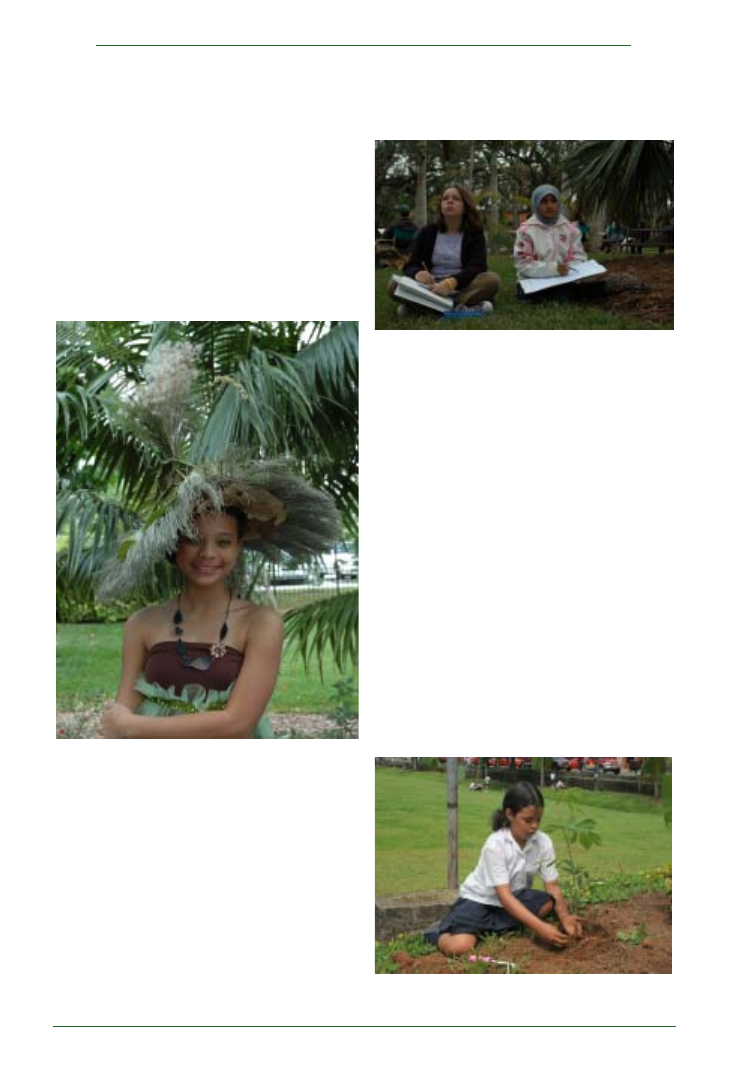
114
Plant Science Bulletin 55(3) 2009
South Florida students from 141 middle and high
schools are engaged in the program.
The mission of the Fairchild Challenge is to foster
interest in the environment by encouraging young
people to: appreciate the beauty and value of nature,
develop critical thinking skills, understand the need
for biodiversity and conservation, tap community
resources, become actively engaged citizens, and
recognize that individuals do indeed make a
difference.
The Fairchild Challenge is launched annually at the
beginning of each school year, and ends with an
Awards Ceremony in May. It is a free, interdisciplinary
environmental program that offers separate but
related Challenge options or competitions for middle
and high schools, grades 6-8 and 9-12, respectively.
The program allows schools to earn points by
participating in some or all of the Challenge options.
These are interdisciplinary, aligned with state
education standards, and pitched to schools via
teachers in a variety of disciplines. The program is
designed to engage thousands of teenagers and,
by extension, their teachers, parents, friends and
communities.
The menu of Challenge options varies annually and
may include: Create/restore/expand and interpret
school gardens or natural habitats. Investigate
water flow and quality. Perform original poetry, song
or dance celebrating nature. Explore cultural uses
of plants through intergenerational interviews.
Create artwork inspired by nature. Produce themed
skits, public service announcements, and pod casts.
Build models of LEED buildings, solar cookers and
solar model cars. Explore careers working alongside
scientists and naturalists. Prepare high-nutrient-
value plant-based meals. Capture people and plants
through photojournalism. Produce research-based
opinion papers and projects. Participate in formal
debate on local/global topics. Compare
environmentally friendly versus unfriendly products.
Promote green initiatives and report on efforts taken
at home, school and in the community. Complete
school energy and waste audits and biodiversity
inventories. And, we are always exploring new
ideas from staff and stakeholders.
The Fairchild Challenge quickly becomes an all-
school effort. Annually, schools earning at least 700
points (a very attainable goal) earn the Fairchild
Challenge Award. Prize money is also awarded to
the top point-scoring schools to be used toward
environmental initiatives. Fairchild Challenge
A middle school student models her hat made out of
plant parts at the Fairchild Challenge Plant and Paper
Hats Fashion Show
Two students find inspiration in the Garden at the
annual Fairchild Challenge Art Workshop
Student participating in the Fairchild Challenge at La
Selva Biological Station in Costa Rica, one of 46 trained
Fairchild Challenge Satellite Partner sites worldwide

115
Plant Science Bulletin 55(3) 2009
participating students receive Challenge T-shirts
or drawstring backpacks (with winning student
design) and family passes to the Garden.
Outstanding students and teachers are also
recognized, as are school-nominated student
Environmental Role Models, affectionately called
ERMies. Additionally, schools earning the Fairchild
Challenge Award for five consecutive years are
named Fairchild Challenge Schools of Excellence.
The program allows parents, teachers, school
systems, community and government organizations
to work together to shape the program and celebrate
the creativity and accomplishments of tens of
thousand of students.
Fairchild Challenge schools include Title 1 schools
and college prep private schools, as well as charter
schools and schools for physically and emotionally
handicapped kids. Promoting the program through
schools maximizes youth involvement, regardless
of age, race, religion, socioeconomic status, interest,
and ability. Additionally, we support schools by
offering garden mini-grants, plants and tree
saplings, teacher professional development,
comprehensive web resources, media coverage,
transportation subsidies, lunch or snacks at all
events, and resources for specific options, including
seeds for germination experiments, solar energy
kits, art supplies, environmental films on DVD for
critique, etc.
The Fairchild Challenge readily attracts
partnerships with community members who
volunteer as ambassadors, evaluators, funders,
and sponsors, and include artists, scientists, county
officials, school district staff, educators, and parents.
We also partner with colleges, universities, parks,
nature centers, government agencies, community
groups, and private businesses. Very fluidly, the
Fairchild Challenge is able to include, embrace and
promote a range of other nature-friendly initiatives,
supporting the work of like-minded organizations.
Fundraising for the program is broad-based and
donor retention is high. Often, our donors volunteer
in the program and see firsthand how engaged the
students, teachers and schools become. Our
funders, partners and stakeholders embrace the
Fairchild Challenge for its hands-on approach to
connecting youth with nature, appeal to diverse
learners, empowerment of students, positive impact
on school climate, and celebratory design.
Teachers of all disciplines also embrace the
program; 97% of those surveyed indicated they
would participate annually. Alumni of the Fairchild
Challenge (now college students) are coming back
to volunteer in the program. Feedback from students
and teachers indicate that we are helping to build
communities of learners who appreciate the beauty
and value of nature. Samples of student and teacher
feedback comments from the past several years
include:
Student feedback: I saw the environment with new
eyes. ~ I learned so much about the environment
that can be applied in my life in the future. ~ Thank
you for giving us a voice in our community. ~ The
Challenge has motivated me to make changes in
my personal life that I had never considered. ~ When
I am outdoors I can forget about everything that is
going on in my life and concentrate on its beauty and
purpose without ever getting tired of it. ~ I learned
creative ways to educate peers about environmental
issues. ~ I learned that plants are extremely
important to the survival of all living things. ~ Nature
is even more beautiful than we think, just open your
eyes. ~ After participating in the Challenge options,
I feel important and needed in my community. ~
Learning through the Fairchild Challenge has taught
A group of high school students proudly poses on
stage at the Fairchild Challenge Awards Ceremony
Students from the top-scoring Middle School proudly
display certificates and winning entries at the Fairchild
Challenge Awards Ceremony for Middle Schools
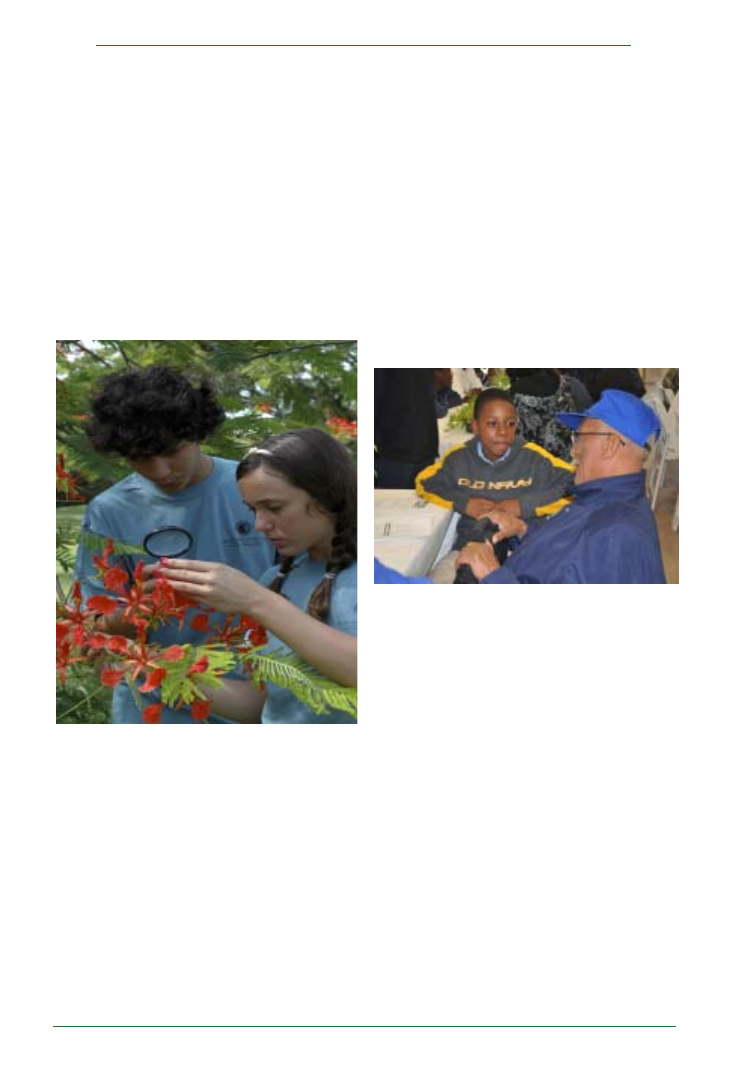
116
Plant Science Bulletin 55(3) 2009
me to be a better citizen and encouraged me to take
an active part in making the world a better place.
Teacher feedback: The Challenge has made caring
about the environment ‘cool’ to my students. ~
Thank you for the honor of being the bridge that
encourages students to participate in life, contribute
to community, and live in harmony with their
environment. ~ It is amazing how much this program
impacts our community by the efforts of our students.
~ I have been energized and inspired to involve my
students much more in environmental issues. ~
Faculty are now learning about their environment
through students. ~ Autistic students were
recognized for their abilities instead of their
differences. ~ Please thank the donors for supporting
a program that brings urban kids closer to nature.
~ This is an incredible program that engages
students in their own education. ~ It helps expose
students to the natural beauty of our area that most
of them don’t even know is here. ~ The Fairchild
Challenge touches the future, allowing students to
see their role in a constantly evolving world
environment. ~ Thank you for finding exciting ways
to help the teachers build interest in conservation,
trees, and the whole gamut of environmental issues.
~ Thanks again for sponsoring such a wonderful
competition. This year’s teachers are already getting
materials ready for next year and their enthusiasm
is contagious.
Next steps
The Fairchild Challenge is proving to be an effective
way to engage tens of thousands of teens and
preteens, and by extension, their schools, families,
friends, neighbors and communities. Interest is
growing nationally and internationally. Educators
from 43 zoos, public gardens and museums have
attended Fairchild Challenge Satellite Training
workshops to learn about and eventually implement
the Fairchild Challenge in their own communities.
Sites trained range from Chicago and Utah, to
Durban, South Africa and Costa Rica. Thus far, eight
sites have, with guidance, designed and launched
their own Fairchild Challenge for their area schools,
and several more sites are in the planning phases.
Additionally, in 2007, the Conservation Fund, a
leading environmental nonprofit, convened a group
of national leaders and formed a National Forum on
Children and Nature. Recognizing an urgent need,
the Forum sought to identify demonstration projects
that would serve as innovative models for community
leaders, planners, educators and others who want
to take concrete steps locally to connect children
with nature. The Forum received 560 proposals
from projects seeking endorsement, and ultimately,
selected 30 projects, based on relevance, impact,
sustainability and potential for success.
The Fairchild Challenge was recently named one of
the 30 selected projects. By endorsing the Fairchild
Challenge, the Conservation Fund’s National Forum
on Children and Nature celebrates its relevance,
impact and sustainability. The Forum seeks to
raise visibility and support for endorsed projects.
There is tremendous potential for refinement,
expansion and replication of the Fairchild Challenge.
It is a very scalable program. Currently, we are
exploring ideas such as web-based
communication and summer leadership institutes
for Fairchild Challenge students, teachers, and
Two high school students get up and close with a
magnifier and Poinciana flower during Environmental
Immersion Day at Fairchild Tropical Botanic Garden
A middle school student listens intently as a Haitian
American senior citizen shares stories of the plants he
has known in his life at the annual Green Treasures
event

117
Plant Science Bulletin 55(3) 2009
Botany in Equatorial Guinea & in
the Island Nation of São Tomé and
Principe
Anitra Thorhaug,
School of Forestry and Environmental Studies,
Yale University
INTRODUCTION
Equatorial Guinea is one of the smallest (28,051
km
2
) and most botanically interesting of the West
African nations. This nation has a small human
population of just over half a million and a small
terrestrial spatial extent (28,051 km
2
), but a rich flora
with both offshore volcanic islands and its mainland
part forms a portion of one of the legendary world hot
spots the Cameroon Forest ( Figure 1). The oceanic
space of the archipelago is very rich and far larger
(500,000 km
2
).
The island archipelago portion of
Equatorial Guinea is comprised of Bioko Nor and
Sur, Annabon, and geologically the archipelago
includes the island nation of São Tomé and Principe
(Figure 2). All of these islands are a botanist’s
dream. There are two portions of the nation of
Equatorial Guinea :1) the mainland portion ,which
reaches east from the coastline inland to the
Cameroon highland jungles of Central West Africa,
with plant species and ecosystems similar to the
Cameroon Highlands included in the Guinea
hotspots and one of the three richest biodiversity
areas in Africa (Figure 1): and 2.) the two offshore
Islands (Bioko and Annabon), which are onto
themselves a botanical ecosystem akin the
Galapagos or Hawaiian islands for their endemism,
although crops species have been brought from the
African mainland for millennium and Europe from
for five hundred years( Figure 2). Equatorial Guinea
has 3250 plants species with 66 endemic plant
species and 23 (while others estimate 61)
threatened plant species. Threats are increasing :
government mining, petroleum and gas business,
make this nation the number three exporter of oil
and Gas in Africa. Offshore fisheries and exploitation
by foreign nations of the timber are also accelerating.
I had the excellent fortune of being sent there in
winter of 1992 by the United Nations and welcomed
as the guest of the government so that I could look
first hand at the nation.
The nations’ mainland (Figures 1 & 2) borders
Cameroon highlands on the Equatorial Guinea
mainland north coast, Gabon to the east and south,
while the chain of Atlantic islands included in
Equatorial Guinea have Nigeria to the north and
Cameroon and Gabon to the east as their neighbors.
Spatially the terrestrial portion of the mainland is
only 26,017 km
2
, São Tomé and Principe lie further
away from the mainland and cover approximately
partners from the various satellite programs.
Conceivably, millions of urban youth (40,000 in 20+
cities over 5 years) could be engaged in the Fairchild
Challenge in the near future. Long term, the program
could well effect systemic change across the country
and beyond with respect to bridging young people’s
chasm-like disconnect from nature.
Working with the National Forum on Children and
Nature to gauge interest and lobby support, we plan
to approach several large Foundations sensitive to
initiatives like the Fairchild Challenge and share the
program’s ability to: reconnect youth with nature
and promote creativity, scholarship and civic
engagement; align the scope of work to state and
national education standards; and influence
education by providing real-world, interdisciplinary,
open-ended learning opportunities. Ultimately, we
would love funders to consider endowing the
Fairchild Challenge, ensuring its existence for
generations to come.
Teenagers are at an interesting time in their lives;
many believe they can do anything, and they have
passion, time and energy. By nature, they are bright,
articulate, confident, assertive, fearless, and funny.
But teens are also confused, angry, shy, selfish,
and narcissistic. Often, they are looking for
something bigger than themselves to embrace and
the Fairchild Challenge seems to provide an outlet.
It allows diverse audiences of urban teens to connect
with nature physically, emotionally, creatively, and
intellectually. We, educators, parents,
administrators, and community partners, should
offer support and cheer loudly!
Leading a GREEN MOVEMENT in schools
everywhere
Caroline Lewis, Director of Education
Fairchild Tropical Botanic Garden
10901 Old Cutler Road, Coral Gables, FL 33156
USA
Telephone: 305.667.1651, ext. 3376 Fax:
305.661.8953
calewis@fairchildgarden.org
www.fairchildgarden.org
All photographs courtesy of the Fairchild Educational
Staff.
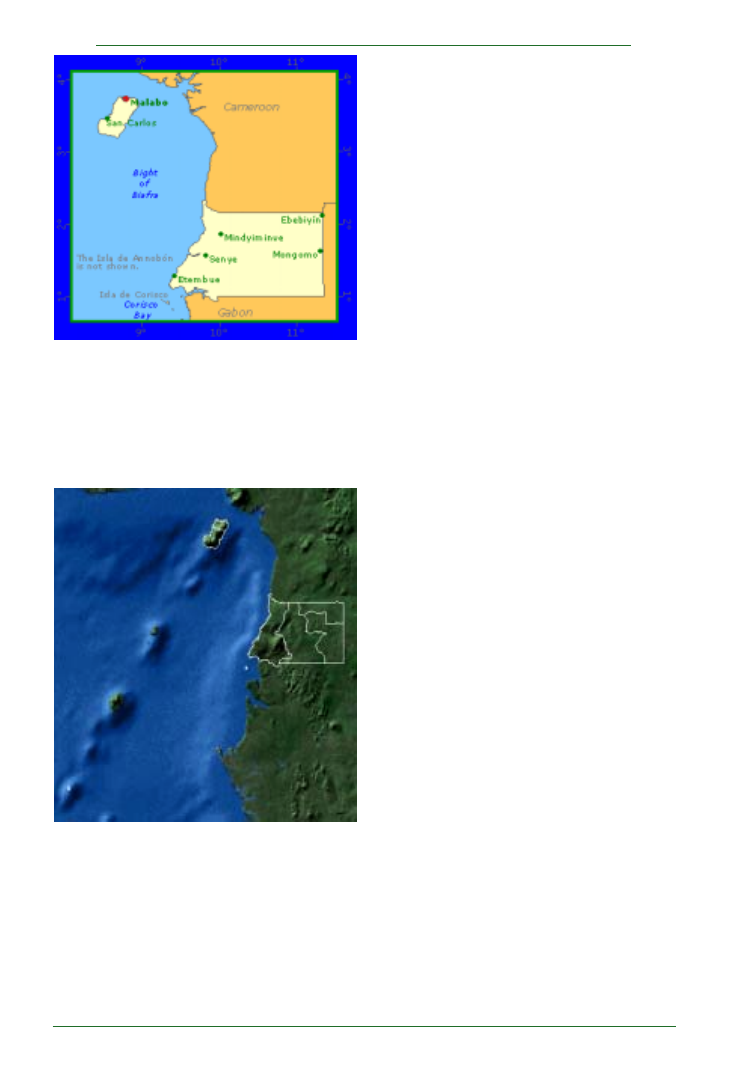
118
Plant Science Bulletin 55(3) 2009
F
A
O
)
Figure 1. Map of mainland Equatorial Guinea (Rio Muni)
seen in white in lower right and largest Island of the
archipelago (Bioko with capital Malabo) also seen on
white in upper left. See the below satellite map in
Figure 2 for outlying islands in archipelago of Annabon,
Principe, and São Tom¿. (from United Nations
FAO)
Figure 2.) NOAA 2002 satellite photo with superimposition
of mainland borders of Rio Muni on the African Mainland.
The four inhabited portions of the island chain can clearly
be seen to the left. Additionally the underwater portions
seamounts of the Equatorial Guinea islands, Bioko Nor and
Sur (large island outlined in white at the top center in the
ocean), and Annobon (furthest to the extreme lower left
in chain appearing as a white dot) and Island nation of
Principe and São Tom
é
( which appear as two green
islands between the white dot and the outlined island in
the center left oceanic area).
836 km
2
, and while the Equatorial Guinean island
of Bioko covers over 2000 km
2
, Annobon is the
furthest from the mainland coast with an territorial
area of 44 km
2
. But due to the line of volcanic islands,
the archipelago of Equatorial Guinea and Annabon
plus St Tomé and Principe have an enormous
oceanic space of 500,000 km
2
. Situated in the Gulf
of Guinea, there are a series of neighbors to the
north of the islands with neighbors (west to east)
Liberia, Cote d’Ivoire, Ghana, Togo, Benin, Nigeria,
and Cameroon.
BACKGROUND of GEOLOGY, OCEANIC and
ATMOSPHERIC CURRENTS AFFECTING the
BOTANY of the TWO NATIONS
Equatorial Guinea is unusual in several ways which
includes being composed of a series of offshore
volcanic islands which are theorized by some to be
formed in the Triassic-Jurassic period when the
Atlantic Ocean between Africa and South America
was being formed. A prevalent geological theory is
that the “Cameroon line” was a fracture from a triple
junction point in the Atlantic and became a geological
fault about 80 million years ago extending along a
zone from Mount Cameroon eastward toward Lake
Chad and westward to the Gulf of Guinea but the
fracture did not continue to extend toward the
European plate (a failed arm of the fault). The fault
contains the Mbere rift Valley and the Cameroon
Highland Mountains. This theory attributes the fault
line formation to the African plate rotating counter-
clockwise which opened up magma conduits so
that a line of volcanoes formed which includes
Annobon and Bioko. The oceanic portion of the line
of volcanoes are clear in the satellite photos (Figure
2) showing the string of offshore islands and sea
mounts, of which 9 are active (receiving shocks 3
times in the last hundred years). Also, an eruption
occurred in 2000 in the string of craters and crater
lakes (Lake Nyos) in the mainland portion of the
fault. The most active volcano is connected with a
large fracture zone evidently on the African Continent
itself including Lake Chad and Mount Cameroon.
The island of Bioko (previously named Fernando
Pó) is the farthest island north in the volcanic
archipelago in the Bight of Biafra . The structure of
the island is cones of two volcanoes reaching 3,008
m named Pico de Santa Isabel. Bioko is primarily
of volcanic origin, resting on a sedimentary base,
and having thickly wooded mountains, with
predominantly a steep, rocky coast. Bioko is just
offshore of Cameroon (25 mile to Cameroon’s
west) and Nigeria (to Bioko’s northeast). The
smaller and more distant (latitude 1° 24´ S) island
of Annobón with the small area of 44 km
2
is primarily
composed of a volcano 900 m high and is part of
Equatorial Guinea. The mainland portion of
Equatorial Guinea is Rio Muni with its terrestrial

119
Plant Science Bulletin 55(3) 2009
area of 26,017 km
2
. Its width is 130 km with an
average western seaboard to mountains length of
200 km. Rio Muni has small offshore islands of
Corisco, Elobey Grande and Elobey Chico. Rio
Muni’s coastal plain is composed of sediment
which is about 15 km deep with a tiered escarpment
of strata at 300 m, 500 m, and 600 m, where a
granite plateau formed being the western extension
of the Gabonese Crystal Mountains. As one
progresses eastward up into the mountains the
land becomes heavily forested and higher so that
mountains can reach 1200 m. The Mbini (formerly
the Benito) River drains about 60 percent of the
area. The entire mainland portion of the nation Rio
Muni, as in many other West African nations, is
drainage basins of a dominant river system. The
central mainland area lies in conjunction with the
upland forests of the Congo and thence eastward
to the interior tropical African jungles, especially the
Cameroon Highlands and the Gabonese Crystal
Mountains. The geography of the two portions of the
nation obviously differs greatly especially with large
rivers on the mainland portion.
The climate is humid, tropical with an average
temperature in the Islands’ area 25
0
C, which does
not vary greatly. Equatorial Guinea generally has a
hot, humid tropical climate with average annual
rainfall varies from 1,800 mm in the north-east to
3,500 to 4,000 mm in the south-west (Cape San
Juan) of Río Muni, over 2,500 mm in Bioko, and
reaching over 10,000 mm in some interior places
in Rio Muni. Seasonal rains are greatest December
through February which are accompanied by highly
energized storms.
The Central West African nations north of Cameroon
have a portion of the Basement complex of West
Africa covered by sedimentary formations. Also
there are sandstone deposits, both having rich oil
reserves, as in Nigeria. There is a ridge of volcanic
highlands which form the western end of the East
African Rift Valley. Running to the south west (as
already mentioned), this volcanic fracture zone
includes the islands of Bioko, San Tomé, Principe
and Annobon ( Figure 2). The edge of the West
African tectonic plate (less studied than other
plates) lies close to the island chain and is active.
Terrigenous sediment predominates over much of
the oceanic region. In the Gulf of Guinea, 90% of the
sediments are terrigenous. The shelf grows deeper
rapidly on the west side of the archipelago islands
except in Bioko which sits on part of the continental
shelf.
The oceanic setting of the island chain is highly
interesting since it involves a set of currents and
counter currents which bring the mid-Atlantic
equatorial waters past the island portions of the
nation. The cooler and nutrient-rich Benguela
Current flows along the Southern-Western African
Coast from the south to north reaching Rio Muni,
where it turns west ( away from the coast) toward
Bioko, and may be found at differing seasons and
wind conditions east, west or south of Bioko. This
brings a richness of phytoplankton not yet fully
explored. The Guinea Current flows eastward and
south-eastward along the coast of the Gulf of Guinea,
reaching its end at Bioko. The waters near Bioko are
those of upwelling and potentially excellent fisheries
and rich marine plants. The South Equatorial Current
flows westward near the equator and then south.
The above currents are mainly wind driven. Several
large rivers draining nations to the east and north of
Bioko on the African continent produce ocean current
velocities from their mouths outward into the sea
tens of kilometers due to rainy season discharges.
Thus the currents around Rio Muni and the islands
especially Bioko are complex and changing with far
fewer scientific records and studies than on the
Western Hemisphere’s South Equatorial Atlantic
coast. These currents potentially bring spores and
seeds of marine plants and occasionally terrestrial
plants into the convergence of the Equatorial Guinea
area, although this rafting and current dispersal is
not well studied.
Atmospheric mixing also occurs in the strong air
patterns over the tropical Atlantic bringing offshore
winds having strong meterological events. The
large-scale, seasonal wind patterns originate from
the Azores and The Canary Island pressure centers
in the Atlantic. Prevailing winds are from the north-
east in the northern part and from south to south-
east in the southern part of the region except in the
Gulf of Guinea, where wind directions vary
considerably. The south-west monsoon dominates
being the strongest yearly wind event which reaches
the furthest north in summer. Violent tropical Atlantic
storms are common and highly energized.
Lightening in these storms is frequent and
consistently causes forest fires which rage until
rains extinguish them.
Botanically, during glacial periods, these islands’s
environmental conditions from Bioko to Annabon
were not changed as greatly as the mainland flora’s
conditions so that the island flora formed a botanical
refuge with ancient African plants which still occur
on these islands (or their successors) ( Leal ,
2004). Possibly, the islands’ conditions were
sufficiently different from the temperatures and
humidity of the mainland (due to the conservative
tendency of the ocean water) that the island
temperatures remained sustainably tropical-
subtropical for a range of plant species (or their
predecessors) found there today. The mainland
became drier, while the islands retained humidity
from aersols, fogs, dews, and other oceanic

120
Plant Science Bulletin 55(3) 2009
moisture. The next question is what occurred to the
oceanic and nearshore marine flora of the islands
versus mainland during these climatic upheavals?
The marine flora is still not well defined at the
inception of the second millennium except for the
mangroves, although the intertidal contains large
stands of seagrasses and a rich array of red and
brown algae, and the benthic habitats contain a
richness of marine plants helping to support a rich
fisheries. This question marine benthic history
remains unanswered at present.
BIODIVERSITY and ITS THREATS, PROTECTED
AREAS, and FOREST DIVERSITY in EQUATORIAL
GUINEA
Protected areas are 16.8% of the total land in 2003
(WRI, 2009) located in 10 protected sites locations.
Of the 3250 plant species, 66 are endemic and 23
are threatened (various authors’ estimates run
from 21 to 61 threatened species probably due to
recent threats of logging plus forest removal for
agriculture). Protected animal species associated
with the forest habitat are also present having one
of the highest areas of animal species (194 species
of mammals, 418 birds, and 91 reptiles) (World
Resources Institute 2009) in Africa. For example,
the mainland highland forest areas have been
called the third richest in species of birds in Africa
(Stuart, 1986, Gartlan, 1989, and Statterfield et al.
1998).
Loss of biodiversity is an ongoing environmental
problem. FAO has expressed concern about the
rate of conversion of lowland forests into agriculture
which rate is unsustainable. As these critical forest
habitats are destroyed and converted to farmland,
both plant and animal species are lost. Many of the
International treaties dealing with plant and animal
species exportation, sales, exploitation within the
nation, biodiversity and other treaties have been
agreed to by the government, which is an active
member of the United Nations. Equatorial Guinea
is a party to the following treaties: Biodiversity,
Climate Change-Kyoto Protocol, Desertification,
Endangered Species, Hazardous Wastes, Law of
the Sea, Ship Pollution. All these treaties are signed,
but not ratified. (This is not meant by me as a
statement of adherence to the treaties, but is set
forth as a factual statement of legal signatures.)
The biological assessment and evaluations of the
flora and fauna of the islands have been described
in a number of recent publications (Collar and
Stuart, 1988, Jones and Tye, 1988, Jones, 1994,
Atkinson et al., 1991, 1993, Leal, 2004, 2005) and
more below where details are found. Endemism at
the generic, specific and sub-specific level appears
extremely high for such a small land area. As with
island faunas elsewhere, the high taxonomic rank
of endemic forms indicates that the process of
relictualization has occurred on these islands for
millions of years. Hilton-Taylor (2000) has predicted
that many critical species on these islands have
small populations which are threated with extinction.
Much of the protected area is in covered in forest-
land, little is protected for other ecosystems such as
wetlands, nothing for marine ecosystems. In the
opinion of this writer more wetland area should be
set aside, especially on the south coast of Rio Muni
and the islands. Also any coral reefs should be set
aside as protected. Forests cover 79% of the inland
portion of the mainland Rio Muni and much of the
offshore islands ( although on the islands, due to
historical colonial farming much area is secondary
forest therein definitions and amounts vary between
estimates). The most critical ecosystems
botanically are those on the islands full of endemism
and secondly those in proximity to the Cameroon
highlands, one of the highest terrestrial biodiversity
areas on the planet besides Pacific coral reef
systems. According to FAO, forests presently
dominate 52.8% of about 1.6 million hectares of the
nation, which are being harvested at 0.89% per
annum. FAO estimates about 600,000 ha of forests
are virgin. According to FAO, there has been a recent
rapid change in forest cover. Between 1990 and
2000, Equatorial Guinea lost an average of 15,200
hectares of forest per year (0.82%). From 2000 and
2005, 0.89% per annum. Thus, from 1990 and
2005, Equatorial Guinea lost a total of 12.3% of its
forest cover (228,000 hectares). Wetlands of
international importance include only three Ramsar
sites made official in 2005. (There are more
deserving of the Ramsar site certification). The
number of tree species in the IUCN red list include
1 critically endangered, 3 endangered and 11
vulnerable species.
This ecoregion of the four islands of Príncipe, São
Tomé, and Bioko and Annobon in the Gulf of Guinea,
off the west coast of central Africa support high
numbers of endemic species, including several
endemic genera and families. This area has been
compared with other island centers of endemism
(e.g. Galápagos or the Hawaiian archipelagos
including their underwater seamounts, which in the
case of Equatorial Guinea’s seamounts are
underexplored. Being volcanic there should be
submarine lava tubes which may have fantastic
marine flora and animals as do those lava tubes
near the Canary Islands.) Evolutionary features
typical of island faunas and floras, such as gigantism,
dwarfism and unusual ecological, physiological
and behavioral adaptations are also found in a
range of species.
The Guinean hotspot (Figure 3) (an estimated
9,000 vascular plant species and 1,800 endemic
species) includes two distinct sub-regions,
whichncorporate several important Pleistocene

121
Plant Science Bulletin 55(3) 2009
forest i
Figure 3. Map of the Guinean Forests of West
Africa, one of the world’s biodiversity hotspots. (Source:
Conservation International).
refugia created by the retraction and fragmentation
of forests of the last 80 million years: 1.)Upper
Guinea hotspot stretches from southern Guinea
into eastern Sierra Leone and eastward through
Liberia, Cote d’Ivoire and Ghana into western Togo;
2.) Nigeria-Cameroon hotspot , extends along the
coast from western Nigeria to the Sanaga River in
southwestern Cameroon. The two sub-regions are
separated by the Dahomeny Gap in Benin, an area
of farmland, savanna and highly degraded dry forest.
The Upper Guinean hotspot includes the four
islands in the Gulf of Guinea: Bioko and Annobon,
and São Tomé and Principe. Bioko is considered
geologically to be a continental-shelf island,
whereas the remaining three are considered
oceanic (See Figure 2). The flora of these islands
is highly distinctive. The island of Bioko has 1105
plant species of which 12% are endemic (Excell,
1973). There are 37 endemic plant species on
Príncipe, 95 on São Tomé (along with one endemic
genus), and 20 endemic species on Annobon
(Figueiredo, 1994, WWF and IUCN, 1994). Only 16
of the region’s endemic plants are shared by more
than one island. This emphasizes the high degree
of isolation under which these island’s floras evolved
and it indicates that potentially each island received
its flora separately from the mainland. (The patterns
of current of wind and water would be potentially
possible to corroborate this theory.) The Rubiaceae,
Orchidaceae, and Euphorbiaceae are characteristic
of the islands’ flora having high generic diversity
and high numbers of endemics according to
Figueiredo (1994). Significant endemic radiations
among other plant genera (e.g. Begonia and Calvoa)
are also found. The Pteridophyte flora of the islands
is also considered particularly rich (Figueiredo
1998). The islands are distinguished as Centers of
Plant Diversity (WWF and IUCN 1994). For instance
giant begonias (Begonia crateris and B. baccata)
are found as are other plant and animal giantism
and dwarfism. Some international agencies and
NGO’s have proposed to protect the remaining
areas of primary forest on São Tomé and Príncipe
as national parks. A law establishing procedures
for the proclamation and management of a protected
area system was passed in 1999. The proposed
parks would protect the largest remaining habitat
blocks, including areas of primary forest. São Tomé
and Príncipe are preparing to declare protected
areas for the Parques Naturais d’Ôbo, which will
cover a total of 293 km
2
. It is pleasing to be able to
state that the entire island of Annobon was recently
ratified as a protected area. Let us hope these legal
status declarations have some effect. The second
Guinean sub-region, Nigeria-Cameroon, extends
along the coast from western Nigeria to the Sanaga
River in southwestern Cameroon going inland
toward the east. Important montane regions,
including the Cameroon Highlands (Mt. Cameroon,
at 4,095 m is the highest peak in West Africa) and
with south ends of the range of ecosystems in
mainland Equatorial Guinea (Rio Muni) as well as
on the island (Bioko). Part of the value of the region
is the high number of both endemic plants and
animals. Also the rapid development of farming and
forestry as well as population growth in these areas
puts the species in threat. As previously mentioned,
FAO is concerned about lower altitude mainland
areas being rapidly converted into forests. There
are a number of economically important species
found among the outstanding plant species in this
second Guinean hotspot. This region forms the
origin for a series of important cultivated plants. The
original native oil palm (Elaeis guineensis) (widely
cultivated throughout the tropics for palm oil) is
found along with valuable timber species including
African ebony (Diospyros gracilis), two genera of
African mahogany (Entandophragma and Khaya),
and iroko (Milicia excelsa), which have been widely
exploited. In the Bamenda Highlands a distinct sub-
region within the Cameroon Mountains 120 plant
species are endemic. The subregion has rare
woods such as Mahogany, ironwood, cam wood
and mimosup . In a smaller sub-region within these
highlands, the Kilum-Ijim forests within these
highlands have Arundinaria alpine (Alpine Bamboo)
and quantities of endemic species. These forests
form the habitat for a food web of animals with 62
mammalian species (11 are endemic). There exist
36 endemic bird species, 40 amphibian endemics,
9 reptiles and possibly a large number of endemic
fish. Butterflies species exceed 950 with over 100
endemics.
CURRENT FOREST STATUS
There is currently estimated to be 40 km
2
of primary
forest on Príncipe, and 240 km
2
on São Tomé. Over
larger areas of both islands, secondary forest
vegetation is regenerating on old plantations. On
Annobon, much of the forest, with the exception of
the high peaks of Santa Mina and Quioveo, has

122
Plant Science Bulletin 55(3) 2009
been modified by humans over several centuries
but remains important habitat for endemic species.
Many of the endemic species have adapted to
modified habitats on the cocoa and coffee plantations
because of the use of shade trees to protect crops.
Some International agencies have for decades
proposed to protect the remaining areas of primary
forest on São Tomé and Príncipe as national parks.
A law establishing procedures for the proclamation
and management of a protected area system was
passed in 1999. The proposed parks would protect
the largest remaining habitat blocks, including areas
of primary forest, as has been done with Annobon.
Concerns exist over the protection and status of the
remaining areas of drier forest on São Tomé, and
for the long-term survival of species confined to
lowland forests of these islands. The remaining
lowland forest habitats are being gradually cleared
for agriculture. Knowledge of many species of
conservation concern is so poor that it is difficult to
assess whether the proposed national parks on
São Tomé and Príncipe will adequately protect
these populations.
Threats to Plant Species
During the sixteenth century, a large area of dry
forest in the north and northeast of São Tomé was
cleared for sugar cane production. After the decline
of this cash crop at the end of that century, some of
this forest recovered. From the middle of the
nineteenth century, large coffee and cocoa
plantations were established on both Príncipe and
São Tomé, which led to the widespread modification
and destruction of primary rain forest. Rain forest in
the north of Príncipe was also severely modified
during a campaign against sleeping sickness from
1911-16. However, many endemic species adapted
to the shade forest found in plantations. After the
1930s, and especially following independence in
1975, many plantations were abandoned, and there
was some regeneration to secondary forest. Since
the mid-1980s, land reforms have led to the
development of market gardening and consequent
land conversion from coffee and cocoa plantations.
Some secondary forest areas have also been
cleared once more for agricultural use. This is of
some concern because it will put pressure on
endemic species that have adapted to secondary
and plantation shade forest, and it will also increase
pressure on remaining primary forest areas.
Agricultural practices on Annobon have traditionally
been based on a forest agricultural system that was
less damaging to biodiversity than the large-scale
plantations of Príncipe and São Tomé. However,
there remains a danger that agricultural
encroachment in the primary montane forest zones
of Pico Quioveo and Pico Santa Mina will result in
irreversible damage to these habitats.
PLANT INTRODUCTIONS:
The crop plants of the colonial plantations such as
cocoa and coffee are introduced plants, as are
those which the pre-colonial groups brought with
them, namely, the Fang, Bantus, Bubis and other
tribes. Earlier biodiversity on the four islands may
have been particularly susceptible to the introduction
of non-native species. On all four islands, a number
of terrestrial mammals, both domestic and wild,
have been introduced over the centuries (Dutton
1994) some of which have done damage to native
species. For example,recent introductions of
terrestrial gastropod species have been recorded
on all three islands (Gascoigne 1994a). Little direct
exploitation of the endemic terrestrial wildlife occurs.
Medicinal plant use is almost exclusively concerned
with non-endemic species.
Educational Botany and Botanical Groups
There is the Universidad Nacional de Guinea
Ecuatorial (Equatorial Guinea National University),
founded in 1995 in Bata (on the Mainland) with a
medical school and other active professional
schools. Botanical activity is found in the Agricultural
School and the Fishing and Forestry School. None
of the islands, nor Fernando PÛ„has a University.
Citizens wishing higher education have been
accustomed to going to Europe, Russia, or the USA
for university training, where many of the present
government engineers, administrators and
scientists have been schooled.
There are a series of donor government projects
and multi-governmental projects ( EU and other
regional groups). Overseas development projects
from Spain, Portugal, USA, EU have been central in
the botanical research being carried out. Also there
are a series of various disciplinary projects at an
International level by African Development Bank,
African Union, BDEAC, CEMAC, FAO, G-77, IBRD,
ICAO, ICRM, IDA, IFAD, IFC, IFRCS, ILO, IMF, IMO,
IOC, ITSO, ITU, MIGA, NAM, OIF, OPCW, UNCTAD,
UNESCO, UNIDO, UNWTO, UPU, WFTU, WHO,
WIPO, UNDP, and other international agencies.
Thus, during the past thirty years much more
information has been obtained about the flora of
Equatorial Guinea than previously.
Anthropological history
Probably the original mainland inhabitants were
pygmies (groups of Pygmies are presently located
in scattered locations in Rio Muni). Historically
recorded are waves of Bantu migrations occurred
in the 1600-1800 after the Portuguese had claimed
the area. Later migrations included the Fang tribes
from the Cameroon into Rio Muni displacing Neolithic
populations and the Bubi (chiefly into Bioko where
they became the first human inhabitants). Migrations
between the 17th and 19th centuries brought further
coastal tribes (such as Ndowes, Bujebaes,

123
Plant Science Bulletin 55(3) 2009
Balengues, Kombis and Bengas) along with their
languages. The Fang comprise about 80% of
Equatorial Guinea’s population, while the Bubi
comprise about 15% along with some Fernandinos.
Probably the Annobon population was brought by
the Portuguese from Angola for colonial plantations,
which also was the case in São Tom¿„and Principe.
At present there are also Europeans, other African
groups, and Asians living in Equatorial Guinea.
Recent Human History
The history of the small nation has been a bit
strained in the twentieth century. After being a
Portuguese colony, for hundreds of years, in 1778,
the island of Bioko, adjacent islets, and commercial
rights to the mainland between the Niger and Ogoue
Rivers were ceded to Spain in exchange for territory
in the Western Hemisphere and then governed
from Buenos Aires. These areas were ruled by
Spain until 1958. Colonization began in the early
sixteenth century when São Tom¿„became the
world’s largest sugar producer and, after this crop’s
decline, the island grew to be an important slave
trading post. Annobon became a Spanish colony in
the eighteenth century and now forms part of
Equatorial Guinea. In the nineteenth century, coffee
and cocoa plantations were established on São
Tomé and Príncipe so that Africans from Angola
chiefly were moved to the islands to work on the
estates. These islands have remained populated
and became an independent country in 1975.
The Republic of Equatorial Guinea is now an African
democracy which exports oil. Since its recent
beginnings to pump gas and oil to export abroad in
1992, it has rapidly become Africa’s number three
in exports of gas and oil ranking after Nigeria and
Angola. Equatorial Guinea also has other natural
mineral resources such as gold, bauxite, diamonds,
tantalum, sand and gravel. The sea in this portion
of Africa has plentiful fish for the native artisanal
fishermen, although dangerously offshore rights
are sold to foreign fishing companies.
The population of Equatorial Guinea is slightly
greater than a half a million of which about half live
in the major cities with Malabo the nation’s capital.
Average life expectancy is 49.7 years in Equatorial
Guinea. Median age is 18.83 year with fertility rates
over 4. Infant mortality rate is 85.13 deaths per 1000
births (WHO, 2005). About 52% work as farmers,
arborists and artisanal fishermen. Artisanal fishing
is important in the coastal and island areas, while
arbors, livestock and farming are central
employment sectors in the mainland and growing
inland replacing forest-based livelihoods. Little
English is spoken, although knowledge of
Portuguese, Spanish, and French are common
with the inhabitants, who also speak several
indigenous languages such as Fang and Bubi. The
population of São Tomé and Principe is 206,000 of
which 95% live in São Tomé who are chiefly farmers,
with 2300 fishermen. The São Tomé average life
expectancy is 65.3 years with 63.8 of men and 66.7
for women. The São Tomé median age is 14 with
4.39 fertility rate. A series of other employment
sectors are available, although the population is
very young. There is some service work.
Equatorial Guinea now has the second highest per
capita income in the world, after Luxembourg,
although this is derived by simply dividing the GDP
by the population. This ranking has several effects.
The United Nations can no longer provide the
nations the loans and other newly industrializing
nations’ services. Second, the other nations expect
a developed nation set of standards from this young
democracy which is independent from Spain only
some 50 years.
Two emerging regional governance issues are the
following: first, a great deal of piracy occurs along
the Bay of Guinea coastline in general, both within
these territorial waters and those of all the adjacent
nations of Gulf of Guinea. A second regional problem
is the illegal immigration of citizens of many West
African nations along the general coastline from
Gabon to Liberia then northward into Morocco and
thence into Europe in small boats. Both trends are
occurring in increasing numbers.
REFERENCES AND LITERATURE CITED
Atkinson, P.W., N. Peet, and J. Alexander. 1991. The status
and conservation of the endemic bird species of São Tomé
and Príncipe, West Africa. Bird Conservation International
1: 255-282.
Atkinson, P.W., J.S. Dutton, N. Peet, and V.A.S. Sequeira.
(eds.) 1993. A study of the birds, small mammals, turtles
and medicinal plants of São Tomé, with notes on Príncipe.
BirdLife Intern
ational
Study Report 56: Cambridge.
Bibby, C.J., N.J. Collar, M.J. Crosby, M.F. Heath, C. Imboden,
T.H. Johnson, A.J. Long, A.J. Stattersfield, and S.J. Thirgood.
1992. Putting biodiversity on the map: Priority areas for
global conservation. ICBP, Cambridge, UK.
Collar, N.J., and S.N. Stuart. 1988. Key forests for threatened
birds in Africa. ICBP, Cambridge, UK.
Dutton, J. 1994. Introduced mammals in São Tomé and
Príncipe: possible threats to biodiversity. Biodiversity and
Conservation 3: 927-938.
Fa, J.E. 1991. Conservacion de los ecosistemas forestales
de Guinea Ecuatorial. IUCN, Gland & Cambridge.
Figueiredo, E. 1994. Diversity and endemism of angiosperms
in the Gulf of Guinea islands. Biodiversity and Conservation
3: 785-793.
Figueiredo, E. 1998. The Pteridophytes of São Tomé and
Príncipe (Gulf of Guinea). Bulletin of the Natural History

124
Plant Science Bulletin 55(3) 2009
Museum, London (Botany) 28 (1): 41–66.
Gascoigne, A. 1993. A bibliography of the fauna of the
islands of São Tomé e Príncipe and the island of Annobon
(Gulf of Guinea). Arquipélago 11A: 91-105.
Gascoigne, A. 1994a. The dispersal of terrestrial gastropod
species in the Gulf of Guinea. J. Conchol. 35: 1-7.
Gascoigne, A. 1994b. The biogeography of land snails in
the islands of the Gulf of Guinea. Biodiversity and
Conservation 3: 794-807.
Gascoigne, A. 1996. Additions to a bibliography of the
fauna of the islands of São Tomé e Príncipe and the island
of Annobon (Gulf of Guinea). Arquipélago 14A: 95-103.
Gartlan, S. 1989. La conservation des ecosystémes
forestiers du Cameroun. IUCN, Gland and Cambridge.
Hilton-Taylor, C. 2000. 2000 IUCN Red List of Threatened
Species. IUCN, Gland, Switzerland and Cambridge, United
Kingdom.
IUCN 1989. La Conservation des ecosystems forestiers
d’Afrique centrale. IUCN, Gland and Cambridge.
Jones, P.J. 1994. Biodiversity in the Gulf of Guinea: an
overview. Biodiversity and Conservation 3: 772-785.
Jones, P. J., and Tye, A. 1988. A survey of the avifauna of
São Tomé and Príncipe. ICBP Study Report No. 24. ICBP,
Cambridge, UK.
Jones, P. J. and Tye, A. 1991. Conservação dos
ecossistemas florestais na República democrática de
São Tomé e Príncipe. UICN, Gland, Switzerland and
Cambridge, UK. x + 78 pp.
Juste, J. 1996. Trade in the gray parrot Psittacus erithacus
on the Island of Príncipe (São Tomé and Príncipe, Central
Africa): Initial assessment of the activity and its impact.
Biological Conservation 76: 101-104.
Juste J., and C. Ibanez. 1994. Bats of the Gulf of Guinea
islands: faunal composition and origins. Biodiversity and
Conservation 3: 837-850. Pyrcz, T. 1992. Provisional
checklist of the butterflies of São Tomé and Príncipe
islands. Lambillionea 92: 48-52.
Leal, M.E. 2005 A new rare endemic Calvoa
(Melastomataceae) from the Mbé National Park, Gabon
Novitates Gabonenses 61. Blumea: 50, 473-475.
Leal M.E.2004. The African rain forest during the Last
Glacial Maximum, an archipelago of forest in a sea of grass.
2004. Ph.-D. thesis. Wageningen University, the
Netherlands.
Leal,M. E. 2002 Microrefugia, small scale ice age forest
remnants.Geography & Systematics of Plants 71: 1073-
1077.
Stuart, S N 1986 The conservation of the montane forests
of Western Cameroon. Cambridge, UK: International Council
for Bird Preservation Report.
Stattersfield, A.J., M.J. Crosby, A.J. Long, and D.C. Wege.
1998. Endemic Bird Areas of the World. Priorities for
Biodiversity Conservation. BirdLife Conservation Series
No. 7. BirdLife International, Cambridge, UK.
White. 1983. The Vegetation of Africa. A descriptive
memoir to accompany the UNESCO/AETFAT/UNSO
vegetation map of Africa. Paris:UNESCO. pp.356.
Wojtusiak, J., and T. Pyrcz. 1997. Taxonomy of three
butterfly species from the islands of São Tomé and
Príncipe in the Gulf of Guinea: Neptis larseni n. sp.,
Charaxes thomasius n. stat., Papilio furvus n. stat.
(Lepidoptera: Papilionoidaea). Lambillionea 97: 53-63.
World Wildlife Foundation. 2003. Biological Priorities for
Conservation in the Guinean-Congolian Forest and
Freshwater Region. Proceedings of Workshop held on
March 30 - April 2, 2000 in Libreville, Gabon. Kamdem
Toham, A., D. Olson, R. Abell, J. D’Amico, N. Burgess, M.
Thieme, A. Blom, R. W. Carroll, S. Gartlan, O. Langrand, R.
Mikala Mussavu, D. O’Hara, H. Strand, and L. Trowbridge
(Editors). Available from http:www.worldwildlife.org/
ecoregions
World Resources Institute 2009 Equatorial Guinea.
WWF and IUCN. 1994. Centres of plant diversity. A guide
and strategy for their conservation. Volume 1. Europe,
Africa, South West Asia and the Middle East. IUCN
Publications Unit, Cambridge, U.K. Prepared by: Angus
Gascoigne

125
Plant Science Bulletin 55(3) 2009
Positive Interactions and Interdependence in Plant
Communities. Callaway, Ragan M. 2008/ ISBN
978-1-4020-6223-0 (Hardcover) 415 pp. Springer,
P.O. Box 17, 3300 AA Dordrecht, The Netherlands.
In this book, Ragan Callaway argues
persuasively that ecologists have vastly
underestimated the influence of facilitation and
positive interactions among species in plant
communities. In particular, beginning with chapter
one, he forges into battle with the ghost of Henry
Gleason and his individualistic view of the biotic
forces responsible for structuring plant
communities. Callaway makes it clear that the
individualistic view is inadequate as a means to
describe plant assemblages because positive
interactions among species create webs of
interdependence. By reviewing a century’s worth of
literature that spans terrestrial ecosystems across
all biomes, Callaway mounts a convincing
argument for facilitation as a potent force driving
patterns in the succession, structure and function
of plant communities.
In chapters two, three, and five, Callaway provides
a comprehensive review of the mechanisms that
cause direct, indirect, and species-specific positive
interactions. He marshals a very large, and arguably
excessive, number of examples from the literature
to support each purported mechanism. Even
Callaway laments that his approach is “a bit mind
numbing”, but he ultimately concludes that,
“sometimes science by siege can make a point.”
Despite the tedium, these chapters should be
required reading for anyone interested in studying
facilitation. Callaway challenges the dogma that
competition is the primary structuring force in plant
communities, although he acknowledges that
positive interactions are not new to ecological
understanding. He further argues that a renewed
appreciation of positive interactions could “catalyze
new thinking about old theories.” In the end we
came to agree with him.
As a complement to the extensive literature review,
Callaway also provides two chapters centered on e
Ecological
Positive Interactions and Interdependence in Plant Communities. Callaway, Ragan M
- William R. Brogan, Hale, Alison N., Heckel, Christopher, D., Hua, Jessica, Montesinos, Alicia, Rohde,
Alexandra, R., Shaffery, Heather, M., Stoler, Aaron B., Wolfe, Marnin, Ashman, Tia-Lynn, and Walter P.
Carson...................................................................................................................................................................125
A Primer of Conservation Biology, 4th ed. Primack, Richard B - Shannon Fehlberg...........................127
Self-Incompatibility in Flowering Plants: Evolution, Diversity, and Mechanisms. Franklin-Tong, Vernonica
E. (Ed.) - H.S. Arathi..............................................................................................................................................128
Economic Botany
Chocolate: Pathway to the Gods. Dreiss, Meredith L. and Sharon Edgar Greenhill- Carolyn Wetzel..129
Mushrooms as Functional Foods. Cheung, Pater C.K. (ed.) - Michelle A. Briggs..................................130
Physiological
Micropropagation of Orchids, Second Edition, Arditti, Joseph.- Michael Strauss..................................131
Plant Desiccation Tolerance. Jenks, Matthew A. and Andrew J. Wood (eds.)- Adrian Renshaw......132
Plant Signal Transduction: Methods and Protocols (Methods in Molecular Biology), Vol. 479, Pfannschmidt
Thomas, (Ed.) - Beronda L. Montgomery.........................................................................................................133
Systematic
The Marie Selby Botanical Gardens Illustrated Dictionary of Orchid Genera. Peggy Alrich and Wesley
Higgins. Bruce Hansen, Robert L. Dressler, Tom Sheehan and John Atwood, eds.
- Marilyn H.S. Light...............................................................................................................................................135
Moth Orchids. The Complete Guide to Phalaenopsis. Frowine, S. A. - Tim Wing Yam and Joseph
Arditti.......................................................................................................................................................................136
Plant Taxonomy: The Systematic Evaluation of Comparative Data, Second Edition. Stuessy, Tod F.
- Tyler Smith...........................................................................................................................................................136
Rare Wildflowers of Kentucky. Barnes, Thomas G., Deborah White and Marc Evans. --Dr. Nina L. Baghai-
Riding.....................................................................................................................................................................137
Books Reviewed

126
Plant Science Bulletin 55(3) 2009
interactions (Chapter 4) and how research on
facilitation contributes to an understanding of a
diverse range of topics in community ecology
(Chapter 6). Most importantly, Callaway presents
dominates over two-thirds of the text, we felt that the
target audience for this book should be narrowed to
scientists primarily interested in pursuing
facilitation-oriented research or to community
ecologists who are firmly rooted in the dogma of
competition as the driving force in communities. For
these groups, the book will undoubtedly provide
insight into the methods used to conduct solid
research in, and highlight the importance of, positive
interactions in plant communities. The extensive
literature review will certainly prove invaluable for
this audience. For readers with a more general
interest in plant or community ecology, however, we
suggest reading Chapters four and six first. The
introduction to the SGH and the link to larger themes
in community ecology (e.g., niche space and co-
evolution) will lay the conceptual foundation that
gives the reader the context to understand the
importance of the numerous examples of facilitation
found in other chapters. We also recommend
supplemental reading (e.g. Bruno et al. 2003,
Brooker et al. 2008) to buttress the theory behind
facilitation introduced in this text.
Despite the overall paucity of theoretical implications
and syntheses, this book provides a thorough and
compelling argument for the critical importance of
facilitation in plant communities. Surprisingly, many
ecologists still appear to adhere to the Gleasonian
(individualistic) paradigm that Callaway effectively
skewers. Even as recently as last year, Ricklefs
(2008) argued that, “communities are not integral
entities.” Callaway’s myriad examples assault this
ideology, and will leave readers with a much greater
understanding of the interdependence of species
and the influential role that positive interactions play
in plant communities. For this Callaway has done
the field of plant community ecology a great service.
Literature Cited
Brooker, R., F. Maestre, R. Callaway, C. Lortie, L. Cavieres,
G. Kunstler, P. Liancourt, K. Tielborger, J. Travis, and F.
Anthelme. 2008. Facilitation in plant communities: the past,
the present, and the future. Journal of Ecology 96:18-34.
Bruno, J.F., J.J. Stachowicz, and M.D. Bertness. 2003.
Inclusion of facilitation into ecological theory. Trends in
Ecology and Evolution 18(3): 119-125.
Ricklefs, R.E. 2008. Disintegration of the ecological
community. The American Naturalist 172(6): 741-750.
-William R. Brogan, Hale, Alison N., Heckel, Christopher, D.,
Hua, Jessica, Montesinos, Alicia, Rohde, Alexandra, R.,
Shaffery, Heather, M., Stoler, Aaron B., Wolfe, Marnin,
Ashman, Tia-Lynn, and Walter P. Carson Department of
Biological Sciences, University of Pittsburgh, Pittsburgh,
PA 15260.
the Stress Gradient Hypothesis (SGH), which
predicts that as abiotic stress increases, positive
interactions will increase disproportionately in
importance relative to competitive interactions. The
SGH is unfortunately the only major theoretical
synthesis explored in any detail but it serves as a
refreshing reprieve from the barrage of examples
from the literature covered in the first half of the text.
Chapter 6 provides a substantial number of thought-
provoking examples of facilitation expanding
species’ realized niches, promoting community
stability and biodiversity, impacting exotic species,
and the most likely way that facilitation could cause
evolutionary changes among interacting species. It
was this chapter that stimulated our most thought
provoking discussions of potential future research
avenues.
This book is almost certainly the most extensive
review of the literature on positive interactions in
plant communities to date and thus a key source of
references on nearly any topic regarding facilitation
and its importance. For those specifically interested
in facilitation, Callaway’s attention to detail in these
examples will be a valuable introduction to the most
commonly used experimental designs and their
shortcomings. To supplement his review of the
literature, Callaway occasionally points out specific
areas in need of further study, making this book a
valuable springboard for those interested in
facilitation research. Nonetheless, some of us felt
that Callaway missed an opportunity in many places
to identify holes in our knowledge regarding specific
areas where research is most critically needed to
advance the field.
We read this book as part of a graduate-level
seminar course, and by the end, nearly all of us were
wishing for a more synthetic approach to the topic.
Our primary complaint was that the book read more
like an annotated bibliography rather than a synthetic
work designed to provide novel insights to community
ecological theory. Perhaps this is too much to ask
when the major thrust of the book is seemingly to
convince ecologists that ignoring these interactions
leads to scientific peril. Callaway could have made
a more compelling argument if he had illustrated
that facilitation is the major force influencing species
composition or dynamics in communities where
competition had previously been the accepted
explanation. From an editorial perspective, the book
had numerous typos, figures that lacked clarity,
references left out of the bibliography, and an index
that had too few entries to be of much value.
Initially, the book seemed like a timely and pertinent
read for anyone interested in plant community
ecology. However, after pouring through the
exhaustive list of examples of facilitation that the
balance between competitive and facilitativ

127
Plant Science Bulletin 55(3) 2009
A Primer of Conservation Biology, 4th ed. Primack,
Richard B. 2008. ISBN 0-87893-692-0 (Paper
US$49.95) 349 pp. Sinauer Associates, Inc. P.O.
Box 407, Sunderland, MA 01375-0407.
This introductory book by the qualified and
knowledgeable Professor Richard Primack is a
clearly written, beautifully illustrated, accessible,
comprehensive summary and guide to the field of
Conservation Biology. Students enrolled in a number
of different introductory or non-major courses, as
well as non-scientists, citizens, and professionals
who wish to learn more about the field will find this
book to be precisely the breadth and depth of
information they are seeking.
“A Primer of Conservation Biology” begins in the first
chapter with an introduction to the field including its
history, major definitions and concepts, and unifying
goals. Each chapter then successively builds on
previous chapters in terms of both content and
concept. The first four chapters following the
introduction describe and explain topics in
biodiversity including identification of species,
measures, types and patterns of biodiversity, placing
economic values on biodiversity, major threats to
biodiversity, processes of extinction, and specific
challenges faced by small populations. The final
four chapters summarize broad conservation efforts
including methods used to evaluate and monitor
populations, creation of new populations,
establishment of protected areas, conservation
outside of protected areas, and sustainable
development in the future. The book ends with a
poignant charge to conservation biologists to take
on active roles that will help bring about the protection
of the world’s biodiversity.
This book fulfills its stated purpose as a “concise
guide for those who require a well documented
overview of the subject but do not require in-depth
experimental data or lengthy scientific discussion”
and is perfectly suited for its intended audience. The
text is easy to read, terms are carefully explained,
and the use of jargon is avoided. The main take-
home message from each chapter or chapter
subdivision is clearly discernable. Topics covered
and references used are current and relevant.
Several features enhance the utility of this book as
an introductory text for students such as an
instructor’s resource CD that includes all the tables
and figures from the book, chapter end summaries
of the main points covered, excellent discussion
questions that encourage students to digest and
apply what they’ve read, and annotated references
for further reading.
Throughout the book, the use of simple color figures
and tables and real-life examples bring
understanding and relevance to the subject matter
covered. Figures include graphs, diagrams, flow
charts, maps, and high-quality photos. The choice
of real-life examples is well balanced and makes
use of a full range of species (including plants),
habitats and geographic areas of the world.
Examples are also chosen to familiarize the reader
with some of the most important and well-known
stories in conservation biology, for example, the
recovery of sea turtles, multiple uses of horseshoe
crabs, and plight of the American Chestnut.
In my opinion, this book has only a few shortcomings.
First, some topics are possibly oversimplified and
presented without controversy. In other words, the
reader might be given the impression that certain
concepts are straightforward and free from
disagreements or challenges, for example,
ecological economics, global climate change,
reintroductions, mass extinctions, and minimum
viable population sizes. Perhaps a discussion of
controversy and complexity for these and other
issues is outside the scope of this book. Second,
some portions of the text are very dense – the author
attempts to cover large amounts of complex
information briefly and simply, for example,
ecosystems in chapter two. This dense text likely
reflects the need to introduce certain terms and
concepts for later discussion to readers who are
not already familiar with them. Finally, a few minor
complaints are that the heading and subheading
designations within chapters are not clear, the
discussion of extinction rates in chapter 5 is
somewhat confusing, and the chapters at the end
of the book could possibly be subdivided into smaller
chapters, each with a more precise focus.
This fourth edition of “A Primer of Conservation
Biology” appears to be a significant improvement
over previous editions in that color figures and
photos have been added, topics have been better
organized into shorter chapters, and recent
developments and approaches in conservation
have been included.
In summary, this book is informative, interesting,
and fun to read. It covers a wide range of topics in
conservation biology and can be enjoyed by anyone
wishing to learn more about the field. Although it
suffers from some oversimplification, I would not
hesitate to adopt it for my own introductory course
or recommend it to a friend or professional in
another field.
-Shannon Fehlberg, Ph.D., Conservation Biologist,
Desert Botanical Garden, 1201 N. Galvin Pkwy,
Phoenix, AZ 85008.

128
Plant Science Bulletin 55(3) 2009
Self-Incompatibility in Flowering Plants: Evolution,
Diversity, and Mechanisms. Franklin-Tong,
Vernonica E. (Ed.) 2008 ISBN: 978-3-540-68485-5
(Cloth, $219.00) 314 p. Springer. 233 Spring Street
, New York, NY 10013.
Self-Incompatibility in Flowering Plants serves as
a reference to the latest advances in self-
incompatibility (SI) research. Although it cannot be
a replacement to the classic 1977 (2
nd
revised
edition 2001) text book, it provides a more recent
summary of the current status of self-incompatibility
research. The book contains brief descriptions of
topics providing a good source for the recent
literature on this topic. The book can serve varied
audience – an ecologist, evolutionary biologist,
molecular biologist or cell biologist. It would also
help some one trying to gain a peek into all of these
different areas and then explore any of these in
greater detail by going through the original articles.
Being an edited book, the writing style varies from
chapter to chapter and that is a little frustrating as
some chapters do not offer the same detail as
others do. The book forms a really good compilation
of the works by the authors’ research in the field of
SI. The book overall is a good summary of the recent
advances in SI and can form an immediate reference
on topics but priced at $219, I would say it is on the
expensive side.
The focus of the book includes ecology, evolution,
phylogeny, molecular and cell biology of self-
incompatibility and provides details on the
complexity and diversity of interactions. Providing a
glossary of terms at the beginning is really the best
part of such a specialized book. The book is divided
into two parts – the first focusing on the evolution
and genetics of SI while the second delves
completely into the molecular and cellular bases of
SI. Some chapters on ecology, environment and
genetics of SI really read a little choppy desiring
continuum across the different topics described but
provide a good segue into the remaining chapters
in the book. The evolutionary genealogies of SI and
individual case studies of evolution of SI in
Brassicaceae form a good transition into advances
in molecular and cell biology of SI. In addition, the
book also deals with other individual cases such as
poppy, Ipomoea, grasses and finally terminates
with the classic SI example of Primula.
The first two chapters by Barrett and Shore and
Good-Avile et al respectively summarize the ecology
and genetics of heterostyly and self-incompatibility.
Barrett and Shore begin with a description of the
sexual organs of a flower and with a diagrammatical
representation the heterostylous floral
polymorphisms present a clear description of the
heterostylous variations. The chapter then
progresses into the phylogenetic reconstructions
and the functional significance of heterostyly and its
effect on the reproductive ecology. These parts of
the chapter are very brief and are essentially the
summary of many recent reviews as the authors
have mentioned. The authors have described and
contrasted the different theoretical population
genetic models to explain the evolution of distyly.
Being an ecologist myself, I finished reading this
chapter wishing it was not as brief and wanting
some details especially on the topics of floral morph
ratios and reproductive success and theoretical
models and predictions. Good-Avila et al take the
book into the genetics of self-incompatibility
beginning with a brief introduction on the evolution
of breeding systems, the advantages of selfing and
the genetic and environmental interactions
determining self fertility. This chapter provides a
‘non-exhaustive’ peek at the many mechanisms
that underlie self fertility of individuals in self-
incompatible species. The chapter provides a good
description of the S-locus, self fertility in the presence
of S-alleles, modifiers of SI, and it includes mentions
of pseudo self fertility and plasticity in self fertility. I
found the discussion on the fate of self-fertility
genes and the conditions for maintaining stable
polymorphisms of self fertility and SI to be a very
interesting summary of the theoretical aspects of
self fertility and SI. The chapter by Allen and Hiscock
discuss the diversity of SI systems and summarize
the different hypotheses on the evolution of SI in
angiosperms and the underlying phylogenetic
relationships. This chapter presents a picture of the
evolution and the phylogeny of SI by attempting to
combine the current SI data with the recent
angiosperm phylogenies. The description of SI in
basal angiosperms is fairly detailed and forms a
good beginning moving onto SI in monocots,
phylogenetics distribution of SI in the different
angiosperm families leading to the different
expressions of SI including late acting ovarian SI
and the more common gametophytic and
sporophytic SI. This chapter is interspersed
throughout with possible avenues for future
research. Sherman-Broyles and Nasrallah begin
with an excellent contrast of Darwinian thoughts on
self fertility and Stebbins hypothesis of selfing being
the most frequently travelled path in plant evolution.
They focus on the studies of sporophytic SI system
in the Brassica family and briefly discuss the loss
of SI in many plant lineages. They focus on self-
fertility in A. thaliana and summarize the hypotheses
explaining the switch to self-fertility in the species.
The latter chapters deal with the molecular and
cellular bases of SI each discussing either single
species, family or a set of families where cellular
pathways and molecular mechanisms have been
explored in great detail. The chapter by Watanabe
et al highlights the important milestones in the
research on SI in Brassica beginning with an

129
Plant Science Bulletin 55(3) 2009
Chocolate: Pathway to the Gods (subtitle: The
Sacred Realm of Chocolate in Mesoamerica) 2008.
Dreiss, Meredith L. and Sharon Edgar Greenhill.
ISBN 978-0-8165-2464-8 (195 pages, hardcover
with DVD, $30.00) University of Arizona Press.
Chocolate: Pathway to the Gods is a visually
impressive book, containing numerous beautiful
full-color images of artifacts, places, and practices
historically associated with chocolate and its
production. The book focuses on Mesoamerica,
especially the Mayan period. Despite the plethora of
high-quality books available on the social and natural
history of chocolate, this book fills an open niche by
providing an overview of chocolate in Mesoamerica
that is approachable to non-scholars while
maintaining a suitable level of well-documented
scholarship to appease the specialist.
The book is loosely divided into topics such as
rituals, wealth, healing powers, and ecology, but the
topics overlap significantly because of their inherent
interactions. Page space is about equally divided
between images and text. There are a few maps to
clarify locations mentioned in the text. The authors
state that the book arose because they had collected
too many images for their 60 minute DVD (included
with the book, see below). It is apparent that they
used the text and interesting stories to tie the images
together, versus using images to illustrate the text.
Because of this, one can approach the book either
by flipping through and stopping at an eye-catching
image and learning about it from the text, or by more
methodically reading through each section.
My only criticism of the book has to do with its
somewhat irregular and ill-defined timeline. The
mental crisscrossing of centuries within any given
section can be bewildering. The reader is thrown,
for example, from “Early Classic Maya” to the “Madrid
Codex” with little to no explanation of the relationship
between the two. It is assumed that the reader is
familiar with the major periods of Mesoamerican
history and therefore there is no definition of them
in the book. Readers would greatly benefit from a
one page timeline listing the major periods and
location of the described cultures by year. [As a
substitute, you can consult the entry on
“Mesoamerican chronology” in Wikipedia.org]
The 60 minute DVD (2005) that is included with the
book is well-produced and really interesting to
watch. It suffers a bit from the same time-travel
giddiness of the book, but having the information
portrayed in video helps the viewer maintain a better
sense of time and place. My two pre-teen kids
wandered through the room while I was watching it
and stayed for the whole movie. I later heard one of
them describing the role of chocolate in present-
day “Día de los Muertos” (Day of the Dead) rituals to
her friends.
In summary, Chocolate: Pathway to the Gods is a
worthwhile addition to your library if you are interested
in chocolate, Mesoamerican history, and/or
economic botany. The combination of book and
DVD would be useful in a class on Mesoamerican
history, Latin American studies, or economic botany.
It also provides clear photographs of period artifacts
that may serve as inspiration for Mayan-themed art.
- Carolyn Wetzel, Dept. of Biological Sciences, Smith
College, Northampton, MA
introduction on the importance of SI for agriculture.
The chapter contains brief descriptions of the
Bateman model of the sporophytic control of the S-
locus, and identification of S-locus glycoproteins
(SLG). It follows a chronological progress in Brassica
SI with the discovery of the second S-linked gene for
SI in B. olerecea, the functional evidence for the role
of this S receptor kinase (SRK) in SI and a bioassay
system for the identification of a pollen ‘S gene’ that
would interact with SRK. With a description of the
dominance relationships among the complex set
of S genes in Brassica, the chapter concludes with
future prospects of SI and how we can allow our
knowledge of the SI system to be applied in a plant
breeding context. The chapters by Zhang and Xue
and that by McClure deal with the flowering plants
of the family Solanaceae. Rosaceae and
Plantaginaceae exhibit the most widely distributed
S-RNase-based SI system described so far. These
chapters describe the molecular bases of S-RNase-
based SI and the S-RNase genes on the female
side and the S-locus F-box on the male side and the
influence of non S-locus genes on their functions.
The chapter by McCubbin forms a good culminating
point by taking on the classical example of SI in
Primula. This chapter ties in the different topics
discussed by Barrett and Shore in the first chapter
and with a reassessment of the historical
information on SI in Primula, McCubbin excellently
reviews how the recent developments at the
molecular level could generate promising tools to
improve our understanding of self incompatibility in
Primula. The chapter summarizes the floral
characteristics of the mating types in Primula and
the functions of the heteromorphic characters. The
genetic structure, location and size of the S-locus,
the allelic dominance and the current status of the
molecular genetic characterization of the genus are
described fairly briefly. The chapter concludes with
a description of future prospects and ties in the
aspects described in the ecology and diversity parts
of the book into the molecular developments of SI.
-Arathi, H.S. Department of Biology, Colorado
State University, Ft. Collins, USA

130
Plant Science Bulletin 55(3) 2009
Mushrooms as Functional Foods. Cheung, Pater
C.K. (ed.) 2008. ISBN 0-470-05406-2 (Cloth
US$90.00) 259 pp John Wiley & Sons, 111 River
Street, Hoboken, NY 07030.
As our interest in the medicinal aspects of plant
chemicals increases, it makes sense that our
focus should also include chemicals produced by
fungi. Interestingly, more than 400 fungal species
have known medicinal properties. These medicinal
uses are responsible for approximately $6 billion in
global sales; however, less than 0.1% of those
sales occur in North America.
When discussing health benefits of any food, the
first step is obvious: nutritional value. Cheung’s
chapter covers this topic comprehensively. For
example, mushrooms typically contain more protein
than plants, while being low in fat and calories. But
as a functional food - one that promotes health and
reduces disease risks - mushrooms offer us much
more. For example, they have known antioxidant
ability (although little information on the character of
these antioxidants is known) and the ability to lower
blood cholesterol. Cholesterol-lowering effects
may be due to a variety of effects. These include
presence of compounds like lovastatin, which block
cholesterol biosynthesis, or may even be due to
fungal cell wall components interfering with
cholesterol absorption from the gut. Mushrooms
are also associated with lowering plasma glucose
levels, a bonus for diabetics.
While most mushroom nutriceuticals (a refined or
partially refined extract) are derived from mycelia
and culture filtrates, sclerotia are an underutilized
resource. Wong and Cheung’s chapter not only
discusses characteristics of sclerotia, but goes on
to describe three specific sclerotia that are used
both as food and medicine. The chapter also
explains pharmacological activities of their cell
walls, and especially ²-glucans, on physiology,
ranging from their ability to increase calcium and
magnesium absorption to their ability to modulate
the immune system.
I felt the chapter most central to the book’s focus
was V. C. E. Ooi’s chapter on the antitumor and
immune modulating roles of higher fungi. Ooi
focuses on how mushroom polysaccharides
activate macrophages and natural killer cells, induce
apoptosis, and suppress metastasis. The author
also discusses the relationship between
polysaccharide size and anti-tumor activity - the
larger the polysaccharide, the greater the anti-
tumor effect. It also appears other structural
characteristics like branching and helices influence
antitumor activity. The information in this chapter
certainly points out the folly of not including these
compounds in cancer treatment regimens.
The final chapter of Mushrooms as Functional Foods
deals with global inconsistencies in how
mushrooms as dietary supplements are regulated.
The regulatory systems in the U.S., Canada,
European Union, Australia, Japan and Israel are all
discussed, as well as the best techniques for
obtaining consistent nutriceuticals, and potential
methods for consolidating food safety systems.
The one major drawback I found was that the title
leads one to believe the book will focus almost
solely on the ability of fungal compounds to improve
health. While Mushrooms as Functional Foods
included several chapters specifically on the nutritive
and medicinal nature of mushrooms (see above),
it also included several sections that don’t easily fit
the topic. For example, bioremediation is discussed
in the introductory chapter. Another subject that
stretches to fit the idea of functional foods was the
molecular analysis of Lentinula edodes (shiitake)
growth and development strategies. I was hoping
that this chapter would include information on its
main medicinal compound, lentinan, but due to
limited research, the only information on this
functional aspect was the post-harvest degradation
of lentinan. Most material in this chapter discussed
items such as the molecular basis of fruiting body
development and the chemistry of food source
degradation. Interesting, but I feel the topic is
perhaps not yet worth an entire chapter in a book on
mushrooms as functional food.
The book is targeted at those in working with
functional foods, in the areas including nutrition and
complimentary/alternative medicines. The writing
was clear, findings concisely described, the sections
well-marked, material was exceptionally well-
referenced, and all authors pointed out areas where
little research has occurred - making this a great
jumping off point for future research projects.
-Michelle A. Briggs, Department of Biology,
Lycoming College, Williamsport, PA 17701,
Briggs@Lycoming.edu

131
Plant Science Bulletin 55(3) 2009
Micropropagation of Orchids, Second Edition,
Arditti, Joseph. 2008. ISBN 978-1-4051-6088-9
(Cloth US$475.00 ) 1523 pp. Blackwell Publishing
Ltd, 350 Main Street. Malden, MA 02148-5020.
Only the skilled can judge the skillfulness,
but that is not the same as judging the value of the
result.
C.S. Lewis, A Preface to Paradise Lost
This might seem a rather improper way to begin a
review. I do not attribute to myself the quality of skill,
but rather an assessment of the value of the result.
As to the notion of the skilled as judges, this is an
apt description of the second edition of Joseph
Arditti’s Micropropagation of Orchids. At first glance
one might believe this to be a mere compilation of
recipes gleaned from the published literature. That
would overlook its true value. Arditti is not merely a
scribe or compiler transmitting what others have
done, but a synthesizer who, having himself been
an active scientist and micropropagator, has sought
out, studied, interpreted, and (where necessary)
inferred the details of orchid micropropagation. He
has brought to this massive work the skills of a
scientist and the art of a teacher. In so doing he
provides not only the method, but also a judgment
of its skillfulness.
This is hardly a book one sits down by the fire to
enjoy. It also is not likely to find a place on many
coffee tables. But it does contain a wealth of
information drawn from a career devoted to all
things orchid—and if put to proper use will become
a marked up, dog-eared essential in the laboratory.
A carefully detailed and important initial chapter is
devoted to the history of orchid micropropagation.
Therein Arditti seeks to right what he perceives as
the flawed record of history (for which he
apologetically takes some small responsibility).
He admits in his preface to having been “made to
remove parts of the story which placed the discovery
and its discovers in proper perspectives…” from a
similar chapter in the First Edition. This new edition’s
chapter on history carefully details the many who
were instrumental in advancing orchid
micropropagation, and reinstates those removed
parts. In so doing it provides the full picture and
acknowledges the contributions by many deserving
individuals to the development of orchid
micropropagation.
Through Arditti’s history the reader gains an
appreciation of the fact that while we often attribute
advances in science to a handful, it is the
contributions of many taken together that forms a
body of knowledge. Like a teacher, he introduces us
to many who might otherwise be forgotten (we see
not only a name, but in addition for many a photo, a
signature, and an occasional personal note). Was
the fact that only one individual has received the
greatest credit for the work deliberate fabrication by
those with commercial or other interests? An error
of understanding? The result of commercial
protectionism? Arditti leaves his reader to decide
but provides a thorough history that reads like a
good mystery novel.
Having dispensed with the background, for the rest
of this work it is time to roll up your sleeves. As noted,
this is no simple “how to cookbook.” Rather, Arditti
provides the reader the details and tools (from how
to make the necessary stock solutions and media
to how to deal with contamination in cultures, or
where to purchase supplies) to become skilled in
the art of micropropagation. And as fitting the largest
of plant families, we see that the methods are as
diverse as the forms of the orchid flower. For some
the details are manuals in themselves (see, for
example, methods for Cymbidium or Dendrobium
in Volume 1 and those for Phalenopsis in Volume 2).
While for many others they are only brief notes, as
is the three-paragraph entry for Dactylorchis. But
even here there is valuable information for while the
original publications provide only scant information,
Arditti, drawing on his understanding of the topic,
infers for us details omitted by the original authors.
When teaching them the techniques of tissue culture
and micropropagation, I used to warn my students
that success was a mix of science, experience, luck,
and a bit of “witchcraft.” Many years ago, for example,
we sought to develop methods for culturing
Paphiopedilum (the success for which Arditti
suggests remains uneven). After numerous failed
efforts we were overjoyed to find a piece of ovary
tissue packed with what appeared to be bright
green callus growth. A laboratory accident led to the
loss of that culture and despite many efforts, we
were never able to repeat it. Thus, Arditti cautions his
reader that these techniques are far from foolproof.
And, perhaps most valuable, he provides throughout
editorial evaluations and advice that could prove
invaluable for adapting individual efforts.
The publisher’s description of Micropropagation
refers to it as a “classic.” Certainly if one lines this
up with Shakespeare, it would fail that test. And even
in science, I would hesitate (as I am sure the author
would) to list it alongside Darwin’s Origin of Species.
But in the sense of its universal value and
importance, this Second Edition will undoubtedly
be considered a classic, if only because it will serve
as a sole and invaluable resource on the subject. It
has grown from an appendix in a volume of the
series Orchid Biology, Reviews and Perspectives

132
Plant Science Bulletin 55(3) 2009
Plant Desiccation Tolerance. Jenks, Matthew A.
and Andrew J. Wood (eds.). 2007. ISBN 0813812631
(Cloth US$200.00) 311 pp. Blackwell Publishing
Professional, 2121 State Avenue, Ames, IA, 50014.
I chose to do this review as I wanted to know more
about desiccation tolerance in plants. I now do,
however, it is ultimately a book for physiologists,
biochemists, molecular biologists and perhaps it is
most suited to those in agronomy, plant breeding
and conservation. The book does not deal in any
great depth with the ecology and evolution of
desiccation tolerant plants or methods in plant
desiccation tolerance research. Bewley (1975)
described desiccation as the ability of an organism
to dry to equilibrium with dry air and resume normal
metabolic function on rehydration. He proposed
that desiccation tolerance is an inherent property of
the cell. That property limits damage to a repairable
level while maintaining integrity in the dried state
and upon rehydration, mobilizes repair
mechanisms. Sugars, glasses, proteins and genes
all play a role in the different organisms and
structures that are desiccation tolerant. This book
provides an up-to-date review of the various
molecules and mechanisms involved.
Structurally the book is divided into three sections
with 10 chapters. Each chapter is followed by a list
of references. It has an index, but not a glossary or
list of abbreviations that it might well have had. For
example, ABA or GA are abbreviations that many
plant biologists of any description may readily
recognize; however, T
g
(glass transition temperature)
or even LEA (late embryogenesis abundant) are at
another level of specialization. Having said this, I
must also say that there are not a lot of abbreviations
and a one-page list would have done the job. Section
1, Vegetative desiccation tolerance has five chapters.
One chapter is dedicated to angiosperms and one
to lichens. Section 2, Desiccation tolerance of pollen,
spores and seeds has 4 chapters. Section 3,
Applications of Desiccation tolerance research
curiously has only one chapter.
Regardless of the extent of future changes in our
climate, many regions of the world already struggle
with drought, many of those also with famine, and
it was somewhat surprising, that only one chapter
was dedicated to applications of desiccation
tolerance. That chapter focused on the work done
on one desiccation tolerance associated gene
(XvSap1). A chapter on climate change, world food
supplies and a discussion on such things as
elucidating the relationship between desiccation
tolerance and productivity (Alpert, 2006) may have
rounded off the last section and provided a better
finish. I make this comment in light of what I read in
the preface and on the cover to this book. I did expect
(edited by Arditti and others), to the nearly 700-page
First Edition, to the present more than 1500 pages,
2-volume work…a measure of how far and how
rapidly the techniques of micropropagation have
expanded.
While most of the two volumes is devoted to a
species by species listing of methods, there are
valuable appendices on supplies, Internet
resources, and some fundamental chemical and
physical resources (e.g., light, units of measure,
glossary, etc). A very substantial bibliography allows
the interested reader to research and study the
original references themselves…and serves as a
testament to the fact that this is the result of a
lifetime devoted to the study of orchids.
As the author of what he says will be the last such
volume he will produce, Arditti takes opportunity to
project into the future. He sees, not surprisingly,
continued growth and spread of these techniques
and looks to (hopes for?) others who would take up
the task of the next edition in another 15-20 years.
If I could speculate, I would suggest that it would be
difficult to find someone with a similarly intimate
knowledge of orchids and the science and intrigue
that surrounds them. Finally, I would predict that
this work will be considered a classic in one more
sense: it will (very soon I expect) be scarce and out
of print. There is, to return to Lewis’s admonition,
therefore, great value in this result.
Michael S. Strauss
Office of Scientific Quality Review
USDA-ARS
Beltsville, MD 20705

133
Plant Science Bulletin 55(3) 2009
Plant Signal Transduction: Methods and Protocols
(Methods in Molecular Biology), Vol. 479,
Pfannschmidt Thomas, (Ed.) 2009. ISBN 978-1-
58829-943-7 (Cloth US$99.00) 357 p. Humana
Press, a part of Springer Science + Business Media,
333 Meadowlands Pkwy Secaucus, NJ 07094.
This text pertinently addresses the field of signal
transduction in plants. Largely framed in the area
of plant responses to the environment, the text
overviews methods for investigating a broad range
of areas related to plant signal transduction,
primarily for use with model systems such as
Arabidopsis thaliana. The stated emphases of the
text are on in planta studies, as well as methods for
studying plant signal transduction proteins.
This volume covers a wide range of basic and
cutting edge techniques that can be used in any
number of areas of plant signaling research. The
text opens with an insightful overview chapter that
frames the many signals – both external and internal
– that plants must respond and adapt to in the
environments in which they exist and reproduce. An
overview of some eminent areas of plant signal
transduction are examined and described. The
nature of signals and locations of signal perception,
i.e. local, neighboring or long distant, as well as the
receptors that perceive signals and receptor outputs
are covered using well-known examples. The
complexity of each of these components is also
addressed, as is the resulting intricacy of signaling
networks. This overview is an appropriate
introduction to the techniques needed to unravel
and probe experimentally complex plant signaling
networks, which are the focus of subsequent
chapters.
There are a number of major themes covered by the
chapters included in this volume. These themes
include mutant analyses and complementation for
probing gene function, imaging and microscopy-
based analyses, techniques for probing protein
function, and methods for exploring protein-nucleic
acid interactions. Each of these major themes is
addressed in a number of complementary chapters
that in some cases are dispersed throughout the
text.
Mutant analysis is addressed first. One of the most
widely used tools for probing gene function is
reverse genetics – i.e. assaying mutants that harbor
a mutation in a gene of interest for disrupted
phenotypes that may lead to insight into gene
function. Approaches for identifying developmental
phenotypes in Arabidopsis mutants are addressed
in Chapter 2 entitled “Phenotyping of Arabidopsis
Mutants for Developmental Effects of Gene
Deletions.” The full spectrum of assays needed for
analyses from seed sterilization and germination to
to see more on the practical applications of
desiccation research. Interestingly, issues relating
to the application of desiccation tolerance research
are often mentioned; however, the text stops at
exploring them in that context. For example, the
desiccation tolerance/productivity tradeoff
hypothesis is mentioned in reference to the
evolutionary history of the tracheophytes but is
otherwise not considered. This is the only thing that
distracts from an otherwise well-written and
presented book and it might have been better to
have omitted Section 3 but kept the chapter, ‘XvSap1
a desiccation tolerant gene with potential for crop
improvement’.
Chapter 1 was a very informative, enjoyable read
and not limited to plants. ‘Desiccation, unlike
dehydration, is both a process and a destination’
(page 7), made me want to read on. Sufficient
introductory information was provided in Chapter 1
for the rest of what followed. For example,
anhydrobiotes (desiccation tolerant organisms)
may be divided into two broad categories based on
their differing abilities to survive rapid or relative
slow desiccation. This was one central theme that
came up numerous times throughout the book. The
chapters were well edited and there is continuity
between them. For example, in Chapter 2 we find
that there are two general strategies for surviving
desiccation: constitutive and induced cellular
protection, both coupled with rehydration-induced
repair. In part these two strategies reflect the board
categories introduced in Chapter 1 (being able to
survive rapid or relatively slow desiccation).
In summary the book provides a comprehensive
and recent review of plant desiccation tolerance.
There is an emphasis on the physiological,
molecular and genetic aspects; however, it is well
supported with general biological and ecological
information making it a more palatable read for the
non-specialist as well.
References
Alpert, P. 2006. Constraints of tolerance: why are
desiccation-tolerance organisms so small or rare? The
Journal of Experimental Biology 209, 1575-1584.
Bewley, J. D. 1975. Physiological aspects of desiccation
tolerance. Annual Review of Plant Physiology 30, 196-
238.
-Adrian Renshaw, University of Western Sydney,
Australia.

134
Plant Science Bulletin 55(3) 2009
Fluorescence Complementation (BiFC). The widely
used BiFC technique can be used in protoplasts, as
well as for transient expression in tobacco as
discussed (Chapter 12). The mating-based split-
ubiquitin system also is addressed (Chapter 14).
This system, which uses a yeast host to probe plant
protein interactions, is purported as complementary
to in planta assays such as BiFC. Additional specific
confocal-related techniques addressed include
fluorescence cross-correction spectroscopy
(Chapter 13).
Protein-based methodologies are discussed in a
number of contexts. The discussion of these
methodologies includes a chapter on thioredoxin-
based redox regulation (Chapter 8), which describes
a rather specific affinity-purification of thioredoxin
target proteins. Methods for detecting in vivo protein
phosphorylation (Chapter 9) and phosphatase
activities (Chapter 16) also are discussed. As the
phosphorylation status of many proteins are critical
for their roles in signaling, these chapters provide
key insight into practical methods for understanding
protein function in signal transduction pathways.
Protein phosphorylation methods are discussed
specifically in regards to the detection of
phosphorylated proteins in thylakoid membranes.
The chapter on phosphatases addresses
investigating phosphatase activities in vivo. As
protein kinase and protein phosphatase activities
are often antagonistic, the discussion of protein
phosphorylation and phosphatase activity, though
dispersed in the text, seems well aligned. Protein
regulation also is discussed in regards to the
impact of the ubiquitin-proteasome system on
protein stability in Arabidopsis – an emergent issue
in many plant signaling pathways. The methods
useful for identifying proteins that are a part of the
protein degradation system or targets of the system
are detailed (Chapter 10). The more global protein-
based method of proteomics is the focus of Chapter
11. The technology is discussed based on its use
for probing circadian rhythms in Chlamydomonas
reinhardtii. This chapter, unlike the majority of the
included chapters, reads as a case study on the
efficacy of the technique for addressing a specific
research question in this case in Chlamydomonas.
Protein interactions with nucleic acids and the
resulting impact on plant signaling are addressed
in a number of chapters. Chromatin
Immunoprecipitation (ChIP) assays have become
increasingly important for investigating in vivo
transcription factor binding properties. These types
of studies can be complementary to gene expression
studies. In chapter 17, a general overview to ChIP
analyses is presented. Additional methods for
probing DNA-protein interactions are covered
including fluorescence-based electrophoretic
mobility shift assay (Chapter 18), the yeast-one-
hybrid assay (Chapter 19), and transient protoplast
the assessment of a number of phenotypic
characters, including cotyledon shape and size,
hypocotyl lengths and a number of other
physiological parameters are addressed. In the
following chapter “Phenotyping of Abiotic
Responses and Hormone Treatments in
Arabidopsis”, the search for phenotypes that are
dependent on external stressors, i.e. abiotic factors
and hormones, are discussed. The experiments
described in this chapter provide methods for
identifying conditional phenotypes or functions of
genes that may not lead to readily observable
developmental phenotypes. While these two
chapters provide a brief overview to a large variety
of screening conditions, detailed analysis of the
impact of any one of the factors or conditons will
require additional insight into the potential impact
of distinct factors on specific pathways or biological
functions. Later in the volume, a heterologous
mutant approach is presented as an effective tool
for probing the functions of plant signaling proteins
(Chapter 15). In this chapter entitled “Functional
Complementation of Yeast Mutants to Study Plant
Signalling Pathways”, the approach of
complementing yeast mutants to probe plant gene
function is explored. This approach is described in
the context of having been used successfully for
studying plant stress response genes. A practical
method for probing the impact of disrupted gene
function or the impact of changes in the ambient
environment on plants is the quantification of
changes in gene expression. Quantitative Real-
time reverse transcription PCR (RT-PCR) is a widely
used method employed for this purpose. In chapter
4 of this volume, quantitative RT-PCR using SYBR
green chemistry is described. This fluorescence-
based method allows high-throughput gene
expression analyses. The chapter addresses a
number of issues related to primer design,
generation of standards, utilization of controls, and
data analysis.
The discussion of imaging techniques ranges from
more general approaches using confocal
microscopy to more specific experimental
measures, such as the detection of intracellular
calcium concentrations (Chapter 5) and the
measurement of cellular redox states (Chapter 6)
and the detection of reactive oxygen species
(Chapter 7). Each of these chapters provides
detailed steps for the effective use of particular
probes or biosensors, feeding or expression of
probes/biosensors and microscopy-based
detection. Later in the text, a number of chapters
focus on confocal laser microscopy-based imaging
techniques. Confocal imaging has emerged as a
powerful tool for investigating protein localization
and function in planta. One emergent, powerful
technique for studying protein-protein interactions
using confocal imaging is Bimolecular

135
Plant Science Bulletin 55(3) 2009
The Marie Selby Botanical Gardens Illustrated
Dictionary of Orchid Genera. Peggy Alrich and
Wesley Higgins. Bruce Hansen, Robert L. Dressler,
Tom Sheehan and John Atwood, eds. 2008. ISBN
978-0-8014-4737-2 xxx + 482 pp. Cornell University
Press, Ithaca, in association with Selby Botanical
Gardens Press.
This comprehensive illustrated dictionary of some
2500 orchid genus names lists the approximately
850 genera recognized as of 2007 as well as those
names validly published but no longer accepted,
invalidly published names, orthographic variants,
and names published before 1753 (pre-Linnean
taxa). It is important to note that “The accepted
names used in this dictionary follow the taxonomic
use in the Orchid Identification Center at Marie Selby
Botanical Gardens, Sarasota, Florida USA and may
vary from other treatments.”
The Table of Contents lists several small sections
of interest including a profile of the orchid family by
David H. Benzing which sets the stage for the
largest section, Orchid Genera Botanical
Descriptions. It is a challenge to introduce such a
diverse family as the Orchidaceae in just a few
pages but the profile of the family ably covers the
defining characteristics of orchids including
vegetative and reproductive structures, flower biology
and speciation. There is a fascinating reference to
the discovery of an extinct stingless bee preserved
in amber excavated from a mine in the Dominican
Republic in the year 2000 where the insect was
found bearing orchid pollen (Ramírez et al., 2007).
The Orchidaceae have hitherto lacked a definitive
fossil record so the discovery of a bee carrying well
preserved orchid pollinia, which in itself is an unique
fossil observation of orchid-pollinator interaction,
led to the naming of Meliorchis caribea as a new
genus and species. Meliorchis is the single
accepted fossil orchid genus name appearing in
the dictionary.
The major part of this book is the list of orchid genera
with their botanical descriptions. The authors
recognized their daunting task in presenting a
complex assemblage of names in a way that would
be easily searched and most useful to the reader.
A guide to dictionary use appears at the beginning
of this section. The genera are presented in
alphabetical order and color-coded according to
current name status: a simple key to color coding
appears at the bottom of odd-numbered pages
thereafter. Whether a reader is simply curious
about orchid names or is a serious student of the
Orchidaceae, they will find the coding easy to master
although there could be some difficulty for visually
challenged readers with the shades of green, red
and brown used. Also, if a reader had not first
browsed the profile of the orchid family, they may not
have known the name of the fossil genus, Meliorchis,
and could spend some time searching the Botanical
Descriptions section to find the one fossil genus
name that is color-coded dark blue. Antholithes and
Protorchis are fossil genus names that are not
validly accepted. This category of names is printed
in lighter blue type. It might have been helpful to note
these few fossil genus names on the Guide page.
Flowering plants are diverse in their floral structures
and orchids are particularly so. There is such an
array of colors and shapes that perhaps the best
way to present this diversity is to employ a pictorial
approach. Color is used but the small medallion-
style images do not distract the reader rather serving
to intrigue and beckon one to explore further. There
is sufficient detail to recognize favorite genera and
species, and colors are true. The majority of
illustrations used in this work represent type species
of currently accepted and validly published orchid
genera. These are an eclectic mix of paintings,
drawings and photographs. We also find
reproductions of pages and plates from historic
works such as Species Plantarum (Linnaeus 1753),
and Histoire Particulière des Plantes Orchidées
(Thouars, 1822). Some genera of historic interest
are illustrated including Viscum Sloane, a genus
name published in 1707. On the same page as
Viscum, we find Vanilla mexicana Miller used to
illustrate another pre-1753 genus, Volubilis
Catesby. The type species, Volubilis siliquosa
plantaginis folio Catesby, was published in The
assays and in silico analyses (Chapter 20). RNA-
protein interactions also receive some coverage as
a case study of RNA-protein interaction in the
Arabidopsis circadian system (Chapter 21).
This volume of Springer Protocols covers a wide
range of cutting edge techniques that are leading to
novel insight into signal transduction pathways in
plant biology. Most of the chapters are written as
how-to guides in the successful use of these
techniques, while a limited number of chapters are
presented as case studies. A major drawback that
I noted was the somewhat random organization of
the chapters, rather than organization around
emergent themes and/or related experimental
approaches. All in all, however, this is a fine reference
text that surveys a range of current plant experimental
tools and techniques.
-Beronda L. Montgomery, Michigan State University,
East Lansing, MI 48824

136
Plant Science Bulletin 55(3) 2009
Plant Taxonomy: The Systematic Evaluation of
Comparative Data, Second Edition. Stuessy, Tod
F. 2009. 539 pp. ISBN 978-0-231-14712-5. $99.50
(cloth). Columbia University Press, New York, NY.
Stuessy’s “Plant Taxonomy” provides a
comprehensive review of the literature of the field.
As such, it will serve well as jumping-off point for
taxonomists who need a deeper understanding of
the theoretical or philosophical aspects of their
science. Despite its comprehensive coverage and
extensive bibliography (about a third of the total
length!), I’m not convinced it would be a good
introduction to taxonomic practice for upper-year
undergraduates.
Moth Orchids. The Complete Guide to
Phalaenopsis. Frowine, S. A. ISBN-13-978–0-
88192-870-9. Hard Cover. $39.95. pp. 204. Timber
Press, Portland, Oregon.
About 50 years ago Phalaenopsis flowers existed in
all imaginable colors as long as they were purely
white only. Size varied, but not the color. And, the
plants were grown mostly by knowledgeable
hobbyists. At present Phalaenopsis flowers can be
white, green, purple, pink, rose, yellow, orange,
maroon and multicolored with dots, stripes, blotches
and combinations of these. Inflorescences can
bear a few or many flowers and can be erect of
gracefully arching. The plants are no longer grown
by expert amateurs. Phalaenopsis is now one of the
most commonly grown orchids in the world. Millions
of plants in full bloom are sold in nurseries,
supermarkets, discount outlets, florist
establishments, hardware stores, swap meets
and of course orchid specialists. They can be seen
in living rooms, offices, hospitals and in the
background of movie and television sets. Some
areas of Changi Airport in Singapore overflow with
magnificent displays of white Phalaenopsis (that
site alone is worth a trip to Singapore especially
since other areas of Changi have equally magnificent
displays of Dendrobium, Oncidium and other
orchids).
The popularity of Phalaenopsis and the many existing
and potential growers of this orchid have created a
need for “how to” manuals and guides which this
book aims to fill. It does so very well by describing
and illustrating a large number of hybrids, providing
good and clear information about cultivation and
including lists of sources, hybrids, fragrant forms,
four page (two columns each) bibliography and a
helpful index.
This is a very good horticultural guide which we can
recommend highly as such especially for those
who are just starting to grow Phalaenopsis or want
to keep alive a plant or two received as a gift. It is not
a botanical book and does not claim to be one. That
is why this review is very short. A longer and more
analytical review belongs in a horticultural publication.
–Tim Wing Yam, Singapore Botanic Gardens, Cluny
Road, Singapore and Joseph Arditti, Professor
Emeritus, University of California, Irvine, CA 92604,
USA
Natural history of Carolina, Florida and the Bahama
Islands, Savannah, in 1747.
Readers will appreciate the inclusion of a Guide to
Book/Periodical Abbreviations used in this work.
Additionally, there is a Guide to Taxonomists and an
alphabetical listing of taxonomists who have
published one or more new genus names. The
taxonomist’s name, date of birth (and death, if
applicable), and the B&P standard abbreviation for
the author is provided according to Authors of Plant
Names by Brummitt & Powell (1992). The dictionary
would not have been complete without sections on
current nomenclatural rules and a glossary of terms
used in the text.
The authors recognize the fluid nature of orchid
nomenclature but we should bear in mind that there
is limited cross referencing of accepted names and
validly published genus names not currently
accepted by the Orchid Identification Center at Marie
Selby Botanical Gardens so that additional
searching of databases may be needed to establish
synonymy. There is certainly a wealth of useful
material within the pages of this singular work for
the specialist: the quantity of orthographic variants
alone is impressive. This dictionary will also serve
as a useful starting point for those with a casual
interest in the field. The authors are to be
commended for skilfully presenting complex
information in an appealing fashion and assembling
a vast array of citations in one remarkable book.
Literature cited:
Ramírez, S.R., Gravendeel, B., Singer, R.B., Marshall, C.R.,
and N.E. Pierce. 2007. Dating the origin of the Orchidaceae
from a fossil orchid with its pollinator. Nature 448: 1042-
1045
.
- Marilyn H.S. Light, North American Region, Orchid
Specialist Group, Gatineau, QC, Canada, K1N 6N5

137
Plant Science Bulletin 55(3) 2009
Rare Wildflowers of Kentucky. Barnes, Thomas
G., Deborah White and Marc Evans, 2008, ISBN
978-0-8131-2496-4, 190 pages, (hardcover US
$39.95), The University Press of Kentucky,
Lexington, Kentucky, USA.
Landscapes around the world are drastically
changing. Natural resources are rapidly being
consumed to support increasing human population
growth. Old-growth forests, wetlands, and prairie
grasslands are being cut down for agricultural and
urban development. Paved roads are being
constructed in areas that were considered remote
less than 20 years ago. Pollution and over-collection
of plants for pharmaceutical trade or that are attractive
to collectors (e.g., orchids) have caused the demise
of other species. Many exotic plants such as
Ailanthus altissima (tree-of-heaven), Pueraria
montana var. lobata (kudzu), and Euonymus alatus
(winged euonymus), intentionally or accidentally
introduced by humans are eliminating many native
plant species that have evolved and adapted to local
conditions for thousands of years. Apart from
human disturbance, other native species are rare
because they have a narrow geographic range, are
habitat specialists, or represent historic relicts from
colder climatic conditions associated with the last
Pleistocene ice-age. For example, Mountain maple,
an ice-age relict, is found at cool air flowing cave
entrances that are isolated from the hot summer
Kentucky sunshine. Climate change is in no small
part, contributing to habitat decline. Native plants
also are important as a food source, provide critical
information about the health of natural communities,
and serve as a basis of ecotourism.
Rare Wildflowers of Kentucky explores the decline
of native plants in natural areas throughout Kentucky.
At first glance, this text resembles a coffee-table
book. It has a horizontal format (22.3 cm x 26 cm),
large white margins, more than 200 color
The greatest strength of this book is the exhaustive
review of the literature. I expect there are few ‘dark
corners’ of taxonomy that are not illuminated in the
text. I compiled a list of interesting papers to look up
as I read, and I expect even experienced researchers
will find previously overlooked nuggets in here. The
focus is clearly on cataloguing the literature, and in
places little context is provided. Many passages
begin with a brief outline of an issue, followed by a
list of papers on either side: “Jones argued that this
was crucial (1970), while Smith disagreed (1971)”.
In other words, the book documents the arguments
that took place, leaving the reader to look up the cited
papers to evaluate the issue for themselves.
In other cases, Stuessy has gone to lengths to
illuminate issues that warrant careful consideration.
Species concepts are presented in some detail, as
they should. However, I’m not convinced that the
debate around whether subspecies or variety should
be preferred as the primary infra-specific taxonomic
rank is important enough to justify the pages devoted
to it. Regardless, for those that disagree, Stuessy
provides an interesting historical perspective.
The second part of the book is devoted to the various
data used by taxonomists. Each of the ten chapters
includes a selection of recommended references,
an overview of the kind of information that can be
acquired, the equipment and training necessary,
and particular taxonomic issues to be aware of.
These concise reviews will be quite useful for
graduate students, or for researchers looking to
develop a new data source.
A notable weakness of the book is the treatment of
classification approaches. The debates among
pheneticists, cladists and phyleticists are recorded
here in some detail, but the methods themselves
are not well explained. For readers already
comfortable with these techniques, there is useful
background here, but a graduate student with no
previous exposure to ordination will not find this an
accessible introduction. The explanation of cladistic
techniques is hampered by an introductory example
with a data matrix that doesn’t match the associated
cladograms. These shortcomings undermine the
presentation of the explicit phyletic techniques, which
depend on the reader understanding the previous
two approaches.
A guiding theme throughout the book is the
construction of hierarchical classifications. This is
clearly the central issue in Stuessy’s view of
taxonomy, and this aspect of the discipline is
thoroughly presented. The coverage of other issues,
such as species diagnosis and delimitation and
phylogenetic reconstruction, is less satisfying. I
wouldn’t recommend this book as a text for courses
focusing on these latter topics. It would, however, be
a very useful resource for researchers and graduate
students who need an overview of the taxonomic
literature.
-Tyler Smith, MaGill University, Montreal, Quebec,
Canada.

138
Plant Science Bulletin 55(3) 2009
The natural communities subsection is especially
informative. It discusses how the original landscape
of Kentucky was transformed from being more than
90% old-growth forests prior to European settlement
in the mid-eighteenth century to being degraded or
damaged beyond recovery by logging practices,
grazing, fires, and urban development. A half-page
colored map depicts the major natural regions and
physiographic province boundaries within the state
near the beginning of this subsection. Each
physiographic province and associated plant
communities are briefly discussed and have
accompanying photographs such as Appalachian
dry forests, bluegrass mesophytic forests, upland
non-forested communities, prairies, bluegrass
savanna-woodland, and cliff communities.
Part two is a 117-page section entitled “The Rare
Plants”. This part is divided into five subsections:
“Forests”, “Prairies and Glades”, In and along
Rivers”, “Wetlands”, and “Cliff lines and
Rockhouses”. Interesting habitat strategies and
facts are given about each rare plant that is
discussed. For example, Podostemum
ceratophyllum (thread-foot) that thrives in riparian
regimes has thin long leaves that help it to reduce
stress from river currents and possesses a cement-
like compound in its roots that aid in anchoring itself
to rocks. Captions associated with each photograph
often provide additional information about a plant’s
distinguishing features. For example, the
photograph caption of Stenanthium gramineum
(eastern featherbells), mentions how the flowers
help to distinguish it from a grass and that it
possesses a six feet tall flowering stem.
At the end of the book are two appendices. The first
appendix contains a three page list of scientific and
common plant names that appear in the text. The
second appendix provides a seven page list of rare,
extirpated or extinct plants for the state that was
compiled by the Kentucky State Nature Preserves
Commission. Each plant in this list is given a code
as to whether it is endangered, threatened, of
special concern, or historic. A short but useful list of
references and an index follows the appendices.
Overall the book is well organized but the
photographs lack scales so it is difficult to interpret
the size of plants and their respective parts. Also,
the photographs are mainly of flowers rather than of
vegetative features. Metric units also are not included
in the text. However, this book is well written and is
recommended for general naturalists, gardeners,
horticulturists, lower-level biology undergraduate
students, and concerned citizens interested in
protecting rare plants.
-Dr. Nina L. Baghai-Riding, Delta State University
fphotographs of particular wildflowers (some are
full page), the lack of black-and-white illustrations,
and it heavily relies on common names rather than
scientific names. Barnes, a naturalist at the University
of Kentucky took all or the gorgeous and stunning
color photographs with his Nikon F100 camera.
White and Evans of Kentucky’s State Nature
Preserves Commission wrote the majority of the
text.
Many important scientific concepts (e.g., biodiversity
and species rarity) are explained clearly throughout
the book. Emphasis, however, is given to
approximately 220 threatened or endangered
species within Kentucky, most of which are vascular
plants. Sixteen mosses and one lichen also are
included. Species omitted were mainly grasses,
sedges, and rushes that the photographer claimed
were difficult to make photogenic. These authors
mentioned that only two plants among the many that
are listed as rare or endemic to Kentucky:
Leavenworthia exigua (Kentucky glade cress) and
Solidago albopilosa (white-haired goldenrod).
Additionally, these authors noted that only eight of
the 273 plant species listed as endangered or
threatened within the state of Kentucky are on the
Federal endangered/threatened species list. Many
of the listed species within Kentucky, such as
Cypripedium parviflorum (the small white lady’s
slipper), occur at the periphery of their natural range.
The authors stressed that Kentucky is located in the
middle of several neighboring plant communities
that are defined by their geology, hydrology, relief,
wind, and so forth. The Appalachians influence the
east, the Gulf Coastal Plain the west, the Great Plain
floras the west, and other species are associated
with more northern temperate regions. Saving
species at the edge of their range may contribute to
genetic diversity and could possibly lead to evolution
of new species.
The book is divided into two main parts. Part one
contains a 45-page introduction, that is divided into
small subsections including “reasons for decline
of native species”, “reasons for protecting native
plants”, “natural communities of Kentucky”, “rarity”,
and “extinction and preservation of species”. Short
tables scattered throughout this part summarize
several important scientific concepts including
intrinsic and extrinsic values of plants, common
exotic species, as well as provide succinct
definitions for assorted biological terms including
glades, extirpated, endemic, and mesic. At the
conclusion of part one it states how an individual
can assist with saving rare plants: green living and
support conservation organizations either with
financial donations or as a volunteer.

139
Plant Science Bulletin 55(3) 2009
Catálogo de las Plantas Vasculares del Cono Sur.
Zuloaga, F.O., O. Morrone y, M. J. Belgrano, eds.
2008. ISBN 978-1-930723-70-2 (entire work). 3
vols (Paper, US $375.00) 3348 pp. Missouri
Botanical Garden Press, P.O. Box 299. St. Louis,
MO 63166-0299.
Conifer Reproductive Biology. Williams, Claire G.
2009. ISBN978-1-4020-9601-3 (Cloth US$54095)
169 pp. Springer, Heidelberg, 69126, Germany.
Flora de Nicaragua, Tomo IV: Helechos. Stevens,
W.D., Olga Martha Montiel y Amy Pool (editores),
Luis Diego Gómez y Alba L. Arbeláez (autores), Alba
L. Arbeláez (illustradora). 2009. ISBN 978-1-
930723-87-0 (In Spanish; hardbound, US$109.00)
348 pp. Missouri Botanical Garden Press, Press,
P.O. Box 299. St. Louis, MO 63166-0299.
Flora of Great Britain and Ireland, Volume 3,
Mimosaceae-Lentibulariaceae. Sell, Peter and
Gina Murrell. 2009. ISBN 978-0-521-55337-7
(Cloth US$260.00) 595 pp. Cambridge University
Press, 32 Avenue of the Americas, New York, NY
10013.
A Guide to Florida Grasses. Taylor, Walter Kingsley.
2009. ISBN 978-0-8130-3319-8 (Flex US$49.95)
368 pp. University Press of Florida, 15 Northwest
15
th
St., Gainsville, FL, 32611-2079.
Introduction to Bryophytes. Vanderpoorten, Alain
and Bernard Goffinet . 2009. ISBN 978-0-521-
70073-3 (Paper US$45.00) 303pp. Cambridge
University Press, 32 Avenue of the Americas, New
York, NY 10013.
Lone Star Wildflowers: A Guide to Texas Flowering
Plants. Nieland, LaSahara and Willa F. Finley.
2009. ISBN 978-0-89672-644-4 (Paper US$29.95)
485 pp. Texas Tech University Press, Box 41037,
2903 Fourth St., Ste. 201, Lubbock, TX 79409-1037.
Manual of Leaf Architecture. Ellis, Beth, Douglas
C. Daly, Leo J. Hickey, Kirk R. Johnson, John D.
Mitchell, Peter Wilf, and Scott L. Wing. 2009. ISBN
798-0-8014-7518-4 (Paper US$29.95) 216 pp.
Cornell University Press, Sage House, 512 East
State Street, Ithaca, NY 14850.
Paleobotany: The Biology and Evolution of Fossil
Plants, 2
nd
ed. Taylor, Thomas N., Edith L. Taylor
and Michael Krings. 2009. ISBN 978-0-12-373972-
8 (Cloth US$125.00 ) 1230 pp. Elsevier Inc. 525
B Street, Suite 1900, San Diego, CA 92101-4495.
Palms of Southern Asia. Henderson, Andrew.
2009. ISBN 978-0-691-13449-9 (Cloth US$ 90.00)
264 pp. Princeton University Press, 41 William
Street, Princeton, NY 08540-5237.
Plastid Biology. Pyke, Kevin. 2009. ISBN 978-0-
521-71197-5 (Paper US$49.00) 203 pp. Cambridge
University Press, 32 Avenue of the Americas, New
York, NY 10013.
Protocols for In Vitro Cultures and Secondary
Metabolite Analysis of Aromatic and Medicinal
Plants. Jain , S. Mohan and Praveen K. Saxena, eds.
2009. ISBN 978-1-60327-286-5 (Cloth US$110.00)
350 p. Humana Press Ï% C/O Springer Science +
Business Media 333 Meadowlands Pkwy Secaucus,
NJ 07094 USA.
Raffles’ Ark Redrawn: Natural History Drawings
from the Collection of Sir Thomas Stamford Raffles.
Noltie, H.J. 2009. ISBN 978-0-7123-5084-6 (Paper
US$35.00) 180 pp. The University of Chicago
Press, 1427 E. 60
th
Street, Chicago, IL 60637.
S
alt Marshes: A Natural and Unnatural History.
Weis, Judith S. and Carol A. Butler. 2009. ISBN 978-
0-8135-4570-7 (Paper US$23.95) 272 pp. Rutgers
University Press, 100 Joyce Kilmer Avenue,
Piscataway, NJ 08854-8099.
Seedlings of Barro Colorado Island and the
Neotropics. Garwood, Nancy C. 2009. ISBN 978-
0-8014-4753-2 (Cloth US$99.95) 656 pp. A
Comstock Book, Cornell University Press, Sage
House, 512 East State Street, Ithaca, NY 14850.
Syllabus of Plant Families, 3. Bryophytes and
seedless Vascular Plants. Frey, Wolfgang (ed.).
2009. ISBN 978-3-443-01063-8 (Cloth •89,-) 419
pp. Borntraeger Science Publishers,
Johannesstrasse. 3a, 70176, Stuttgart, Germany.
Tyler’s Herbs of Choice: The Therapeutic Use of
Phytomedicinals, 3
rd
ed. Awang, Dennis V.C. 2009.
ISBN 978-0-7890-2809-9 (Cloth US$89.95 ) 269
pp. CRC Press, Taylor & Francis Group, 6000
Broken Sound Parkway, Suite 300, Boca Raton, FL
33487.
Books Received
If you would like to review a book or books for PSB,
contact the Editor, stating the book of interest and
the date by which it would be reviewed (15 January,
15 April, 15 July or 15 October). E-mail
psb@botany.org
, call, or write as soon as you notice
the book of interest in this list because they go
quickly!
Note that books in green are already in
review and no longer available.
Books received are
now posted on the web site as they become available
and may be requested as soon as they are posted.
- Editor

140
Plant Science Bulletin 55(3) 2009
Peer Review in
Plant Science Bulletin
for contributed and solicited articles and
book reviews
dealing especially with Botanical
Education, History of Botany, Botanical
Outreach and other botanical topics of
general interest
Coming with Volume 56, 2010
details will be forthcoming

